17. THE RISE OF THE DICTATORS

CONTENTS
 The attractiveness of the European The attractiveness of the European
Dictators
 Stalin's Communist "command Stalin's Communist "command
economy" (or "state capitalism")
 Hitler's "New Order" (Neuordnung) Hitler's "New Order" (Neuordnung)
 Italy's Mussolini Italy's Mussolini
 France and England seem to have little France and England seem to have little
will to oppose the dictators
 The Spanish Civil War (1936-1939) The Spanish Civil War (1936-1939)
 Japanese imperialism in Asia Japanese imperialism in Asia
 The expansion of Hitler's Nazi empire The expansion of Hitler's Nazi empire
goes unchallenged
 Nazi assault on the Jews intensifies Nazi assault on the Jews intensifies
 America retreats into a deep spirit of America retreats into a deep spirit of
isolationism
The textual material on this webpage is drawn directly from my work
America – The Covenant Nation © 2021, Volume Two, pages 1-14.
A Timeline of Major Events during this period
| 1930s |
The rise of the dictators
1935 When Mussolini's Italian troops invade a peaceful Ethiopia (Oct), Americans are shocked ... but do little in response
... American oil companies even ignoring the League's sanctions – happy to sell oil to Mussolini
Indeed, Congress begins its annual passage of the Neutrality Acts
(1935, 1936, 1937 and 1939) forbidding
Roosevelt to get involved in any of the international crises breaking
out across the world
1936 A bloody civil war breaks out in Spain ... and numerous idealistic Americans join in the "democratic" struggle of the Republicans against the
traditionalist Nationalists (the latter led by Franco)
1937 The Japanese military acts on its own to invade China (Jul) ... to begin the conquest of that country – murdering millions of Chinese in the process; America is shocked!
1938 When Hitler marches his troops into Austria (Mar) to force the union of that country with his Nazi Germany, Americans are
shocked further ... seeing war clouds developing across the world – but not sure what to
do about these matters; the situation is worsened that year (Sep) when
the British
authorize Hitler to also seize the German borderlands of Czechoslovaki
Americans are
horrified when Hitler's Nazis begin their full assault (Nov) on
Germany's Jewish< population
1939 Hitler completes the seizure of all of Czechoslovakia (Mar) ... with the help of the Slovaks who resent the Western ways of their Czech partners
Hoping to turn
Hitler's aggressions now westward (towards France and Britain) Stalin
signs a peace treaty with
Hitler (Aug) ... which secretly divides Poland between them as a buffer
zone; a week later World War Two begins
|
THE ATTRACTIVENESS
OF THE EUROPEAN DICTATORS |
|
While America was thrashing around in the 1930s
with different efforts to get the national economy up and moving again,
American intellectuals began to challenge the country to look abroad to
systems that seemed actually to be working. American capitalism
as an economic idea seemed stone dead. Other national economic systems
however seemed not to be suffering as badly as America's. Thus among
many Americans, the feeling began to grow that America needed to take a
closer look at, and possibly take some economic notes on, what these dictators were doing.
|
STALIN'S
COMMUNIST "COMMAND ECONOMY" (OR "STATE CAPITALISM") |
|
Joseph Stalin's Communist-directed industrial
revolution in Russia inspired many of these intellectuals. While
America and the capitalist West found their economies stagnant with
factories idle and workers unemployed in massive numbers – Stalin's
Russia presented a marvelous picture of rapid industrial development:
hydroelectric dams going up across many broad Russian rivers to bring
huge amounts of electricity to Russian society, steel plants rising
everywhere to produce the steel needed for trucks, tractors, etc.;
urban housing for the Russian worker going up everywhere, etc.
Communism seemed to be proving itself vastly superior to Capitalism,
which clearly had failed in America, at least as some American
intellectuals saw things.
Besides, wasn't Roosevelt's New Deal run along similar lines – with the government taking command of the national economy?
The hidden reality of Stalin's unbounded oppression
But what these intellectuals could not –
or would not – see was that nothing like Marx's Communist utopia was
going on in Stalin's Communist Russia. The state was hardly withering
away. Under Stalin, it had expanded its powers until virtually nothing
at all went on in the Soviet Union that did not come under the tight
grip of Stalin's police state.
Intellectual idealists in America were
unable to see the horrible price being paid by the Soviet farmer to
enable this amazing industrial building program to go forward in the
Soviet Union, because Stalin had terrorized the nation into silence
about this part of his many achievements. Farming families were forced
to hand over their fields and herds to Soviet authorities as part of
Stalin's policy of collectivizing Soviet agriculture. At this point
farmers in this Soviet workers' paradise were considered as simply
fellow workers for the Soviet state, much like the workers in the
factories, mines and other industrial operations. But Stalin's
treatment of the farmers was brutal in the extreme. He intended to
transfer the national wealth of Russia from the countryside to his new
industrial cities. And so he simply confiscated the wealth of the
countryside to finance his industrial programs.
Hoarding of food production was a crime
punishable by death. And if a farmer and his family looked moderately
healthy, they did so because they were hoarding, that is, holding back
part of their harvest for themselves. That was highly illegal. Thus
many farming families simply took the route of slow starvation. Many
others were sent to Siberian work camps for actively resisting this
forced collectivization – where they died either along the way or
within a few years of arriving at these work camps. In the process,
possibly as many as twelve million farmers died to make way for the
country's transition from agriculture to modern industry in the period
1930-1933.
What American intellectuals were not
understanding was how much of Stalin's rising industrial state – such
as the fabled Magnitogorsk Iron Works located in the Ural Mountains
(producing iron on a massive scale) – and massive supporting community
built around it – was built by and employed by masses of peasants
driven from their farmlands into this new industrial life by Stalin's
system of State-manipulated mass starvation. And there was the Norilsk
Mining and Manufacture Works (mining nickel, copper and palladium) –
and the extensive railway system reaching across a frozen north to
bring all this under central command – that were built by hundreds of
thousands of what were essentially slave laborers.
This was in addition to the massive and
equally brutal ethnic cleansing of national minorities that Stalin
ordered (a quarter of a million of such individuals). And it was also
in addition to the deadly purges of the later 1930s that Stalin forced
on his own Soviet Communist Party and the Soviet Red Army, because he
trusted no organization that he himself had not personally built up.
Even people who had once been political allies of his he had executed.
The figures are hard to validate but they range from about 700,000 to
almost 2 million people executed under the orders of Stalin in his
purges of the later 1930s (1937-1938).
Sadly, countless idealistic American
intellectuals would continue to extol the virtues of Communism –
something they would come to regret later, after the end of the coming
war (during the early stages of the Cold War of the late 1940s and
early 1950s) when Communism was at that point viewed as the greatest
threat to the existence of democratic America. Fellow Americans would
not easily overlook the earlier enthusiasm for Communism espoused by
such intellectuals. The suspicion would be that "once a Communist,
always a Communist" – which in most cases would not be true ... but in
some cases would indeed be true.
|
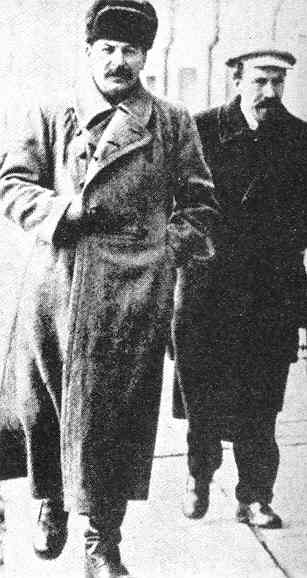
Joseph Stalin and Aleksei
Rykov (one of the Bolsheviks he
deposed to become absolute dictator in Russia by 1927)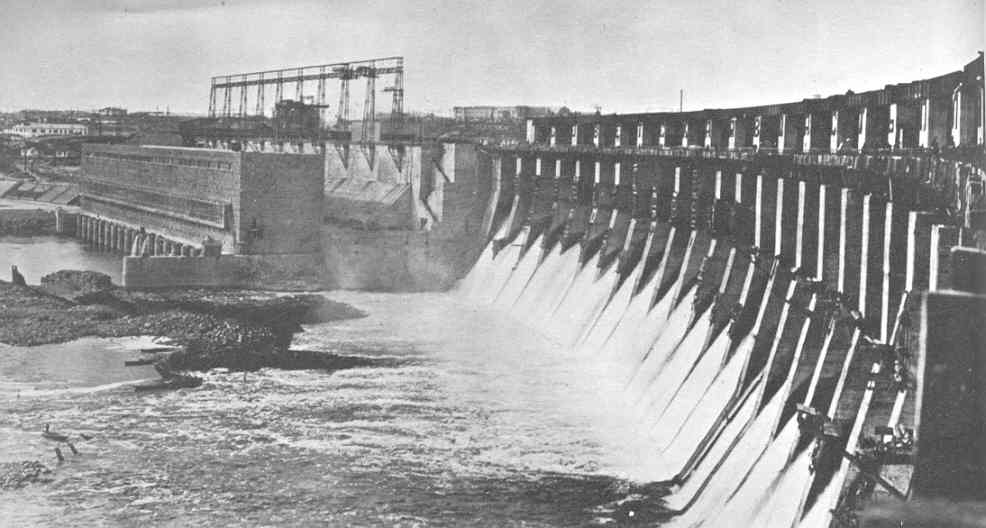 Soviet Dam on the Dnieper
River built in the 1930s (destroyed in advance of
the invading German Army – but rebuilt after the War)
Soviet Dam on the Dnieper
River built in the 1930s (destroyed in advance of
the invading German Army – but rebuilt after the War)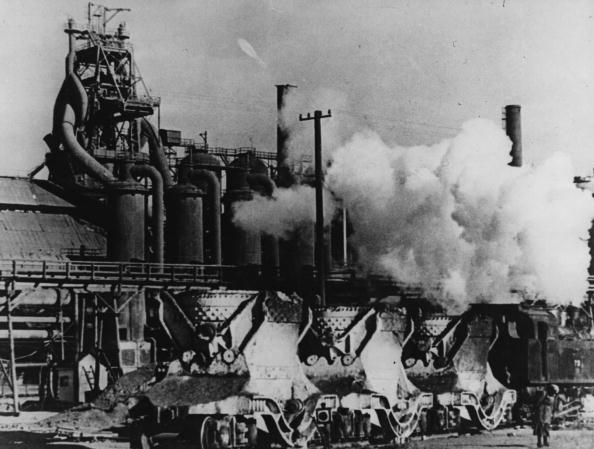 The Magnitogorsk iron works – a showpiece factory and workers' community in the Urals resulting from
Stalin's
5-year
planning (actually modeled after the US Steel Corp plant in Indiana
... with the entire
sprawling community servicing the plant designed by the German architect Ernst
May)
The Magnitogorsk iron works – a showpiece factory and workers' community in the Urals resulting from
Stalin's
5-year
planning (actually modeled after the US Steel Corp plant in Indiana
... with the entire
sprawling community servicing the plant designed by the German architect Ernst
May)
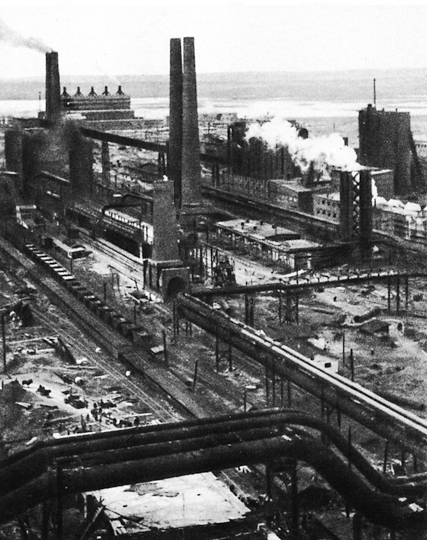 The Magnitogorsk iron
works The Magnitogorsk iron
works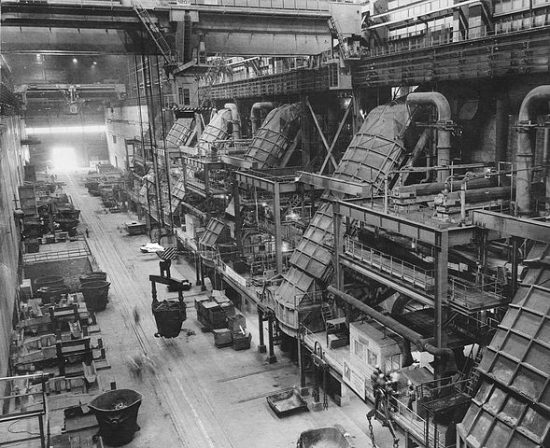 Norilsk Mining and Manufacture Works
(nickel-copper-palladium) created
in 1935 Norilsk Mining and Manufacture Works
(nickel-copper-palladium) created
in 1935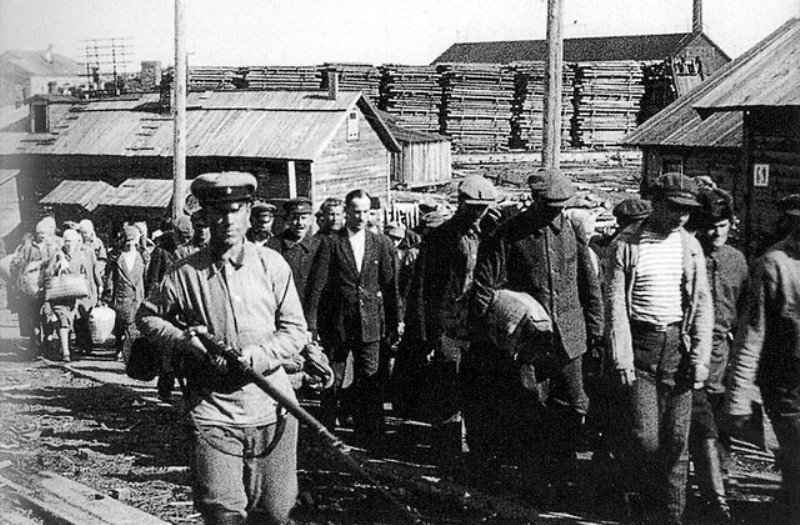 Workers at Murmansk working under armed
guards Workers at Murmansk working under armed
guards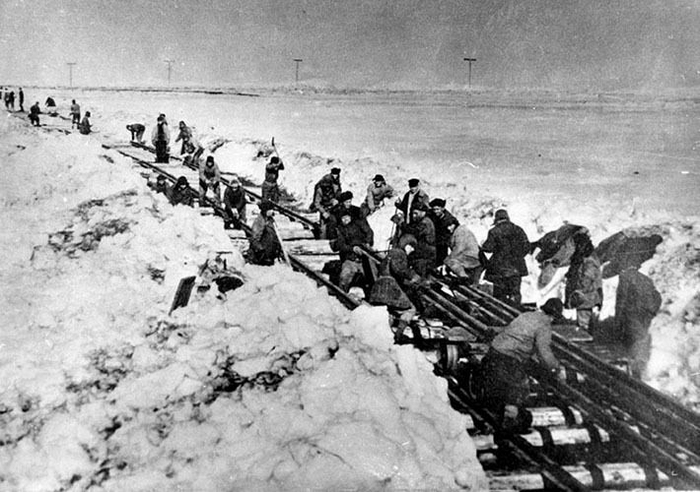 Some of the 58,000 prisoners used to
build the Karelian
railroad Some of the 58,000 prisoners used to
build the Karelian
railroad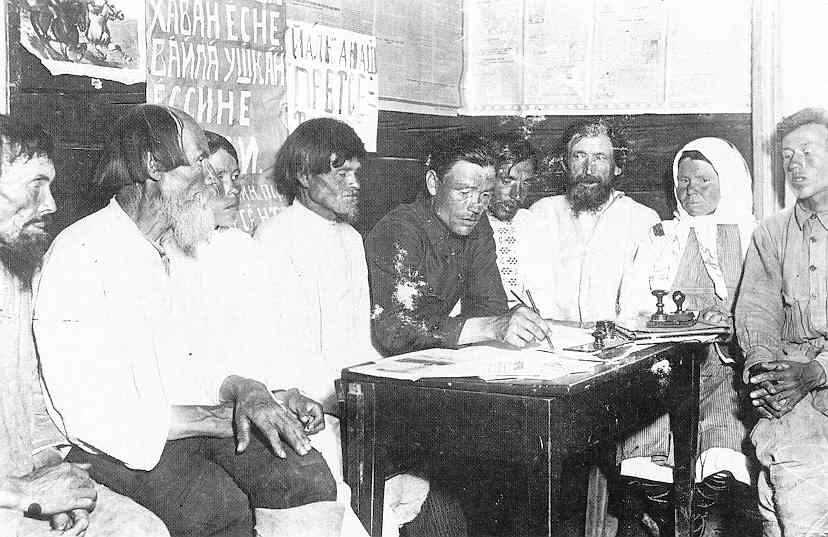 A Communist party official
instructing peasants on collectivization
A Communist party official
instructing peasants on collectivization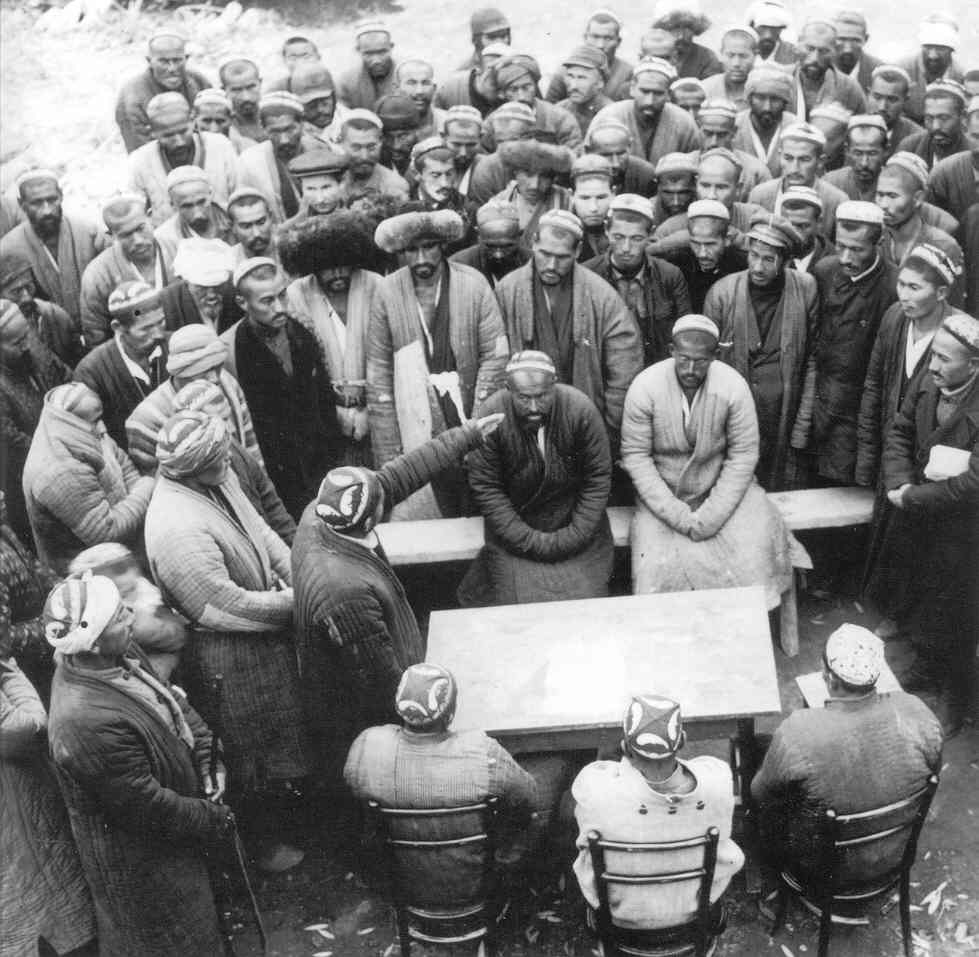 Central Asian peasants being
accused of grain hoarding – 1931
Central Asian peasants being
accused of grain hoarding – 1931
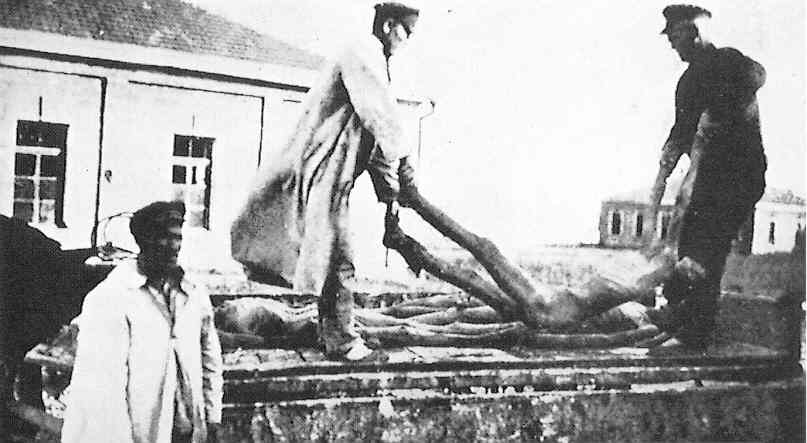 Ukrainians who starved during
the forced collectivization – 1932
Ukrainians who starved during
the forced collectivization – 1932
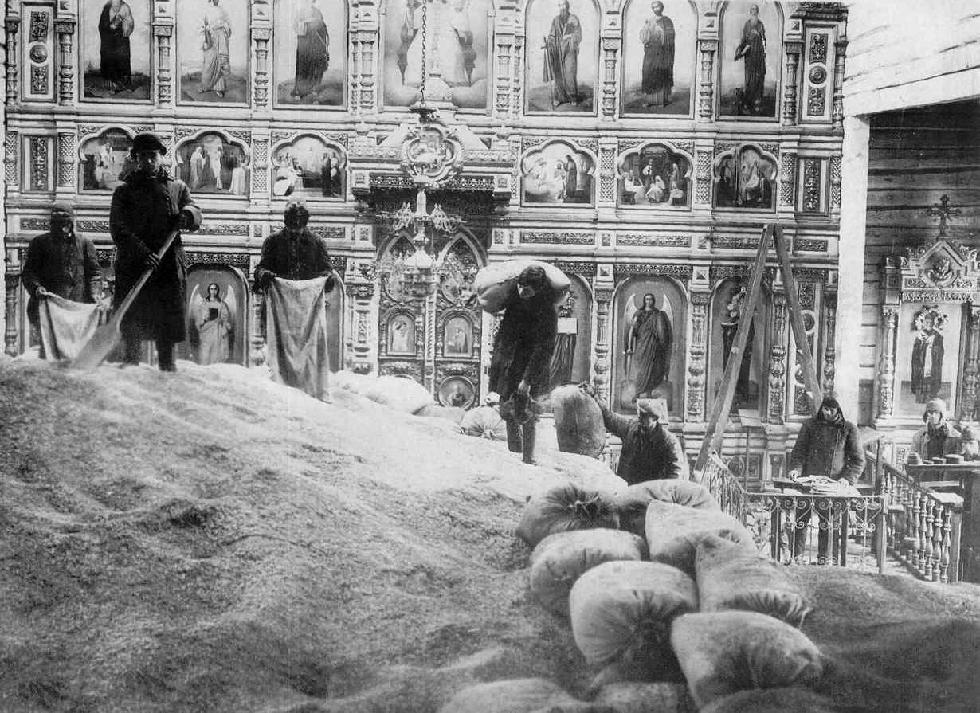 A Russian church in Petrovsky
being used as a grainary – 1930
A Russian church in Petrovsky
being used as a grainary – 1930
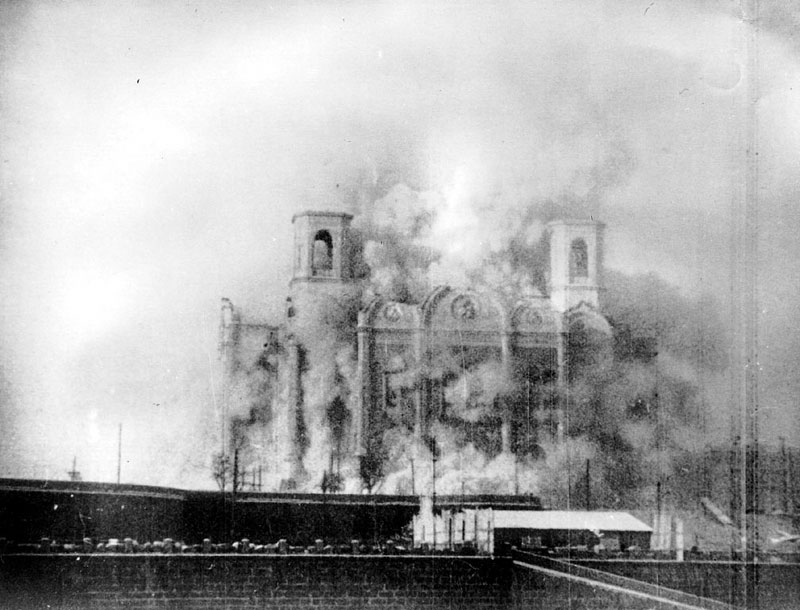 The destruction of the original
Church of Christ the Saviour in Moscow – 1931
The destruction of the original
Church of Christ the Saviour in Moscow – 1931
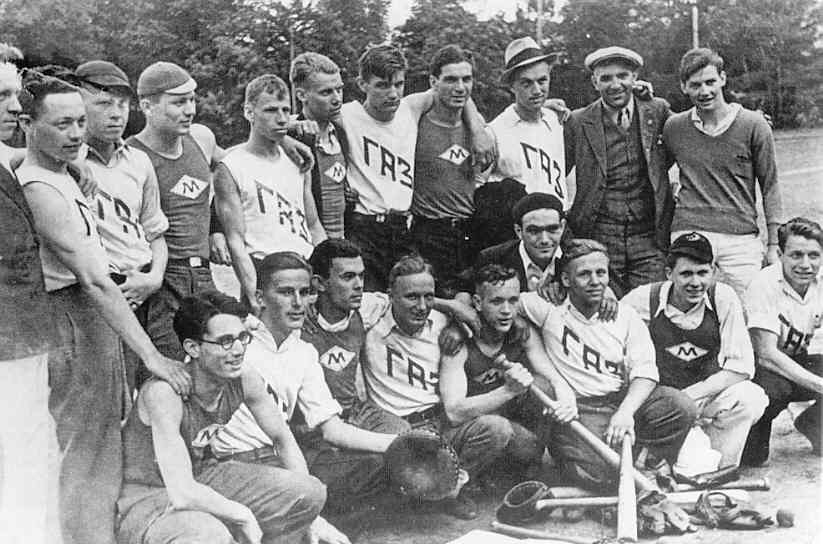 American expatriates who
moved to the Russian Socialist "utopia" – 1932. Stalin, who trusted no one, "liquidated" even these enthusiastic dreamers from America. They were eventually sent
off to Stalin's gulags (prison camps).
None of them would ever
make it back alive to America.
American expatriates who
moved to the Russian Socialist "utopia" – 1932. Stalin, who trusted no one, "liquidated" even these enthusiastic dreamers from America. They were eventually sent
off to Stalin's gulags (prison camps).
None of them would ever
make it back alive to America.
Sergei Kirov, Leningrad
party leader, and Stalin in 1934. His mysterious murder in
1934 became the excuse Stalin used to begin to purge the Party
of his political
opponents (real and imagined)
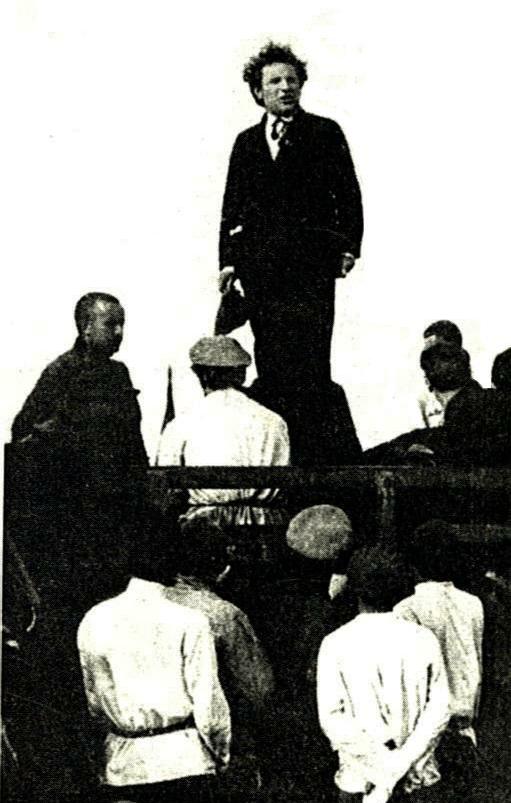
Grigory Zinoviev
speaking. Zinoviev, who was executed
on Stalin's orders after a show trial, was once one of the most powerful and well-known
leaders of the Soviet Communist party.
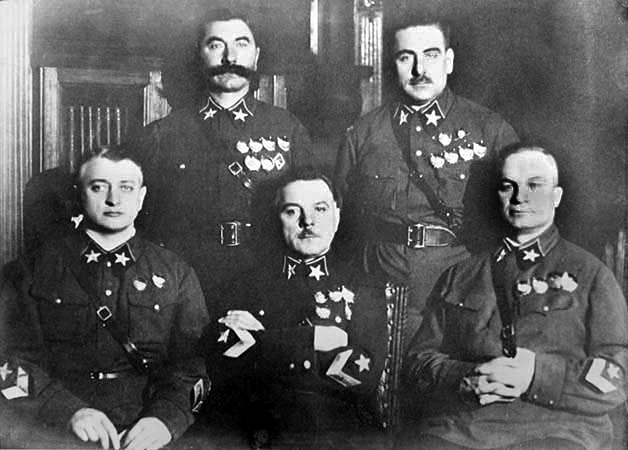
The first five Marshals of
the Soviet Union in November, 1935. (l-r): Mikhail Tukhachevsky,
Semyon Budyonny, Kliment Voroshilov, Vasily Blyukher, Aleksandr
Yegorov. Only Voroshilov and Budyonny
survived the Great Purge.
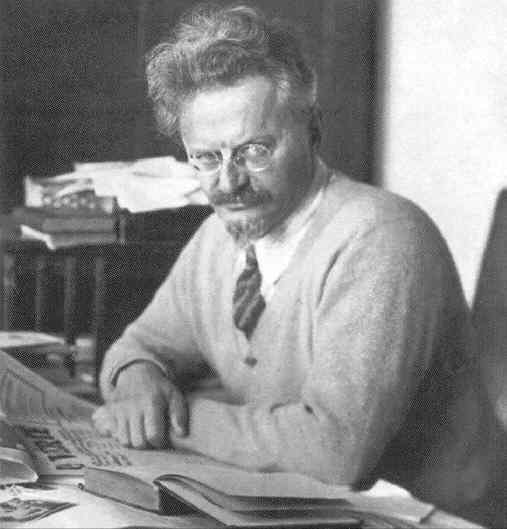 Leon Trotsky in Mexico -
1937. In 1940 he was
finally
assassinated
in Mexico City by a Stalinist agent with an ice pick
Leon Trotsky in Mexico -
1937. In 1940 he was
finally
assassinated
in Mexico City by a Stalinist agent with an ice pick
HITLER'S
NEW ORDER (NEUORDNUNG) |
|
Other American intellectuals looked to Adolph
Hitler's Nazi Germany (beginning in the early 1930s) with its very
evident strong rise in power out of the former catastrophe of Germany's
Weimar Government. The Weimar Republic had been a democratic experiment
in Germany, one that seemingly had failed to bring Germany out of the
chaos of the times. Actually, by the late 1920s things were working
fairly well in Weimar Germany, despite the huge economic punishment
thrust on this new German government, in compensation for the Germans
having supposedly started the war. What ultimately, however, caused
Weimar's failure was the Great Depression, exported to Germany from
America when American banks, facing bankruptcy, called in the huge
loans they had extended to Germany. This in turn threw the German banks
– and ultimately German society itself – into bankruptcy. It was this
condition of complete bankruptcy of Weimar Germany that had provided
Hitler and his Nazis the opportunity to come to power, in order to
"save" Germany.
Indeed, although Hitler himself was a
coarse man, or at least a leader of a very course group of Nazi German
toughs, his policies seemed to have validated themselves in the way
they got Germany back up and moving in strength again as a society –
something that many Americans felt was becoming increasingly beyond the
reach of their own government.
And Hitler knew how to put on a grand
show (thanks also to the talents of Goebbels who had the skills of a
major Hollywood producer), at a time when much of the rest of the
Western world was languishing in economic pity and spiritual
self-doubt. All of Hitler's Fascist expansiveness was accompanied by
grandiose ritual, with massive gatherings of hundreds upon hundreds of
boot-stomping and singing soldiers on parade, torch-lit assemblies with
Nazi banners everywhere and searchlights piercing the infinity of the
night sky, and – most importantly – Hitler from his podium haranguing
the masses with his frenzied boasting about German greatness.
He even knew how to validate his rule
"democratically," by working as Germany’s Chancellor (Prime Minister)
at first even through the Weimar Republic’s legislative system. For
instance, as Chancellor, he was able to exploit the public reaction to
the massive fire that raged through the German Bundesrat or
Parliamentary building just prior to the 1933 elections. He claimed
that this fire had been started by the Communists, thus supposedly
authorizing him to exclude the Communists from the elections – which in
turn gave his Nazi Party the voting edge it needed to stay in power.1
He would even from time to time use general votes or plebiscites in
which the Germans were instructed to vote in favor (or opposition) to
his programs, carefully chosen and conducted in a manner designed to
produce a ridiculously high democratic affirmation of him and his
policies. For Americans in love with the idea of democracy, it was
impossible to be critical of Hitler’s democratic ways.
Hitler was actually a despiser of
democracy – considering it simply a system by which the weak held back
the natural drive of the strong toward greatness. He was very Darwinian
in his understanding that nothing should stand in the way of the strong
taking control of history – to promote the rising greatness of the
superior people (the Aryan Germans). He also had problems with
Christianity for much the same reason: it focused too much on the
problems of the poor and weak. In its unreformed ways (by German
national standards) it was a religion fit only for the poor and weak,
not the strong. Tragically, German Christians – and most importantly
Christian leaders – adjusted their gospel message as "German
Christians" to make it conform more to the Hitlerian agenda.
To be sure, the increasingly shrill
anti-Jewish ranting of Hitler disturbed many thoughtful Americans,
though there was always an undercurrent of anti-Jewish sentiment that
also ran through America at this time. Thus many Americans felt
inclined to look the other way when it came to what Hitler was doing to
the Jews in Germany during the 1930s: he had removed them from all
positions of importance in German society and treated them – even the
highly educated, even the highly decorated for their service to Germany
in the Great War – as the vilest of Untermenschen (inferior people) unworthy of any sentimental concern on the part of a true Aryan German.
And as the 1930s advanced, Hitler
increasingly directed his attentions to the program of demonstrating
the power of Nazi ideology on the larger European stage. He rebuilt the
German state around his own personal will, rearmed Germany militarily,
and began to bully his neighbors in order to make way for German
expansion or Lebensraum (living space or living room), directed
particularly eastward in the direction of the Slavic-speaking world
(Czechoslovakia, Poland, the Ukraine, Russia, etc.) where he saw land
available by conquest, land whose fields could feed the growing German
population and whose petroleum and minerals could feed the German war
machine.
1A
dim-witted Dutch Communist youth was arrested for having caused the
fire. He may have indeed started the fire. But it would have needed
much additional help to turn itself into the inferno that destroyed the
Parliament buildings. Suspicions are that the Nazis themselves may have
provided that help.
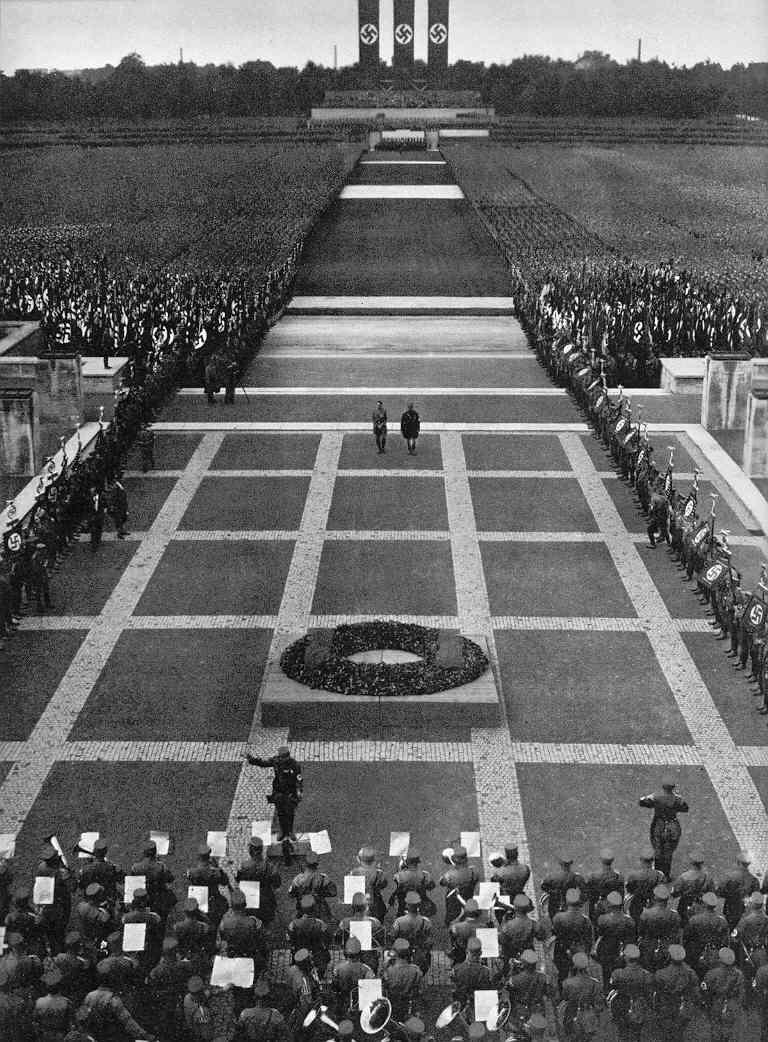
Hitler and Ernst
Röhm stride
together down the center of the first Nuremberg Nazi
Party Rally – 1933
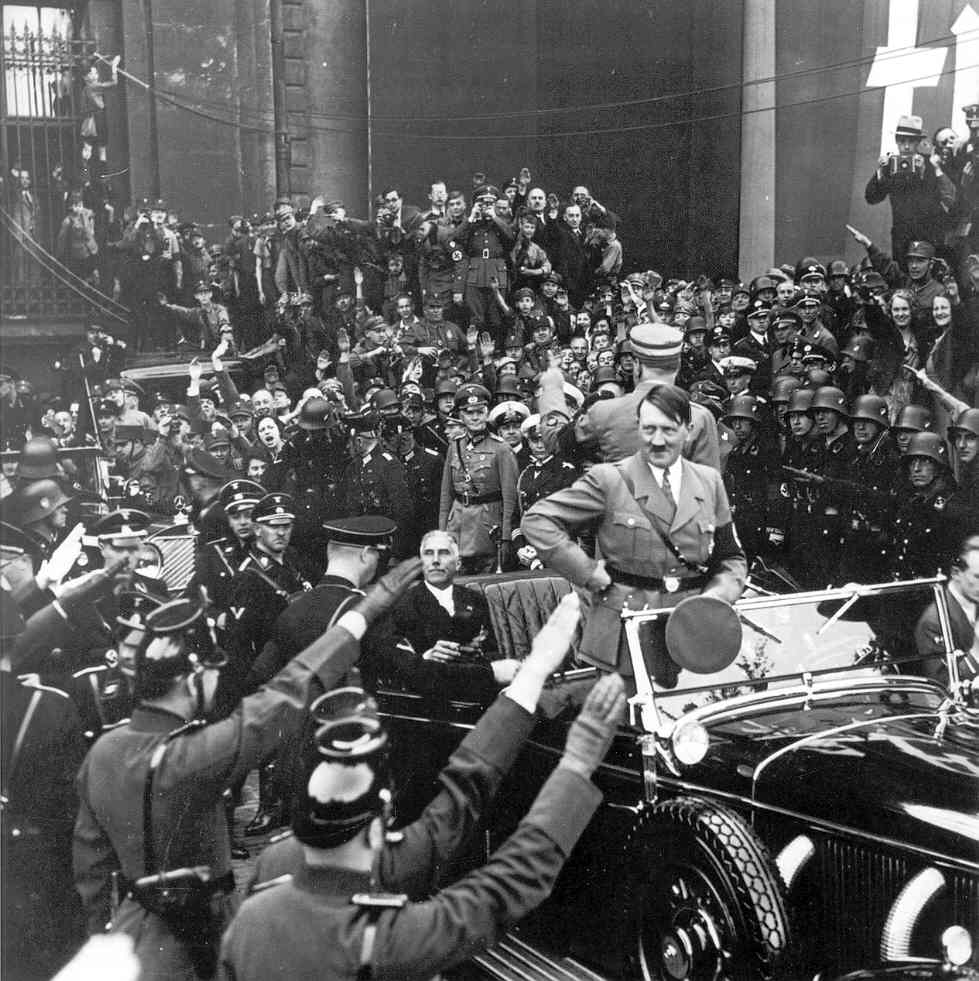
Hitler arrives at a youth
rally in Berlin – 1934 Hitler and
crowds
Hitler and
crowds
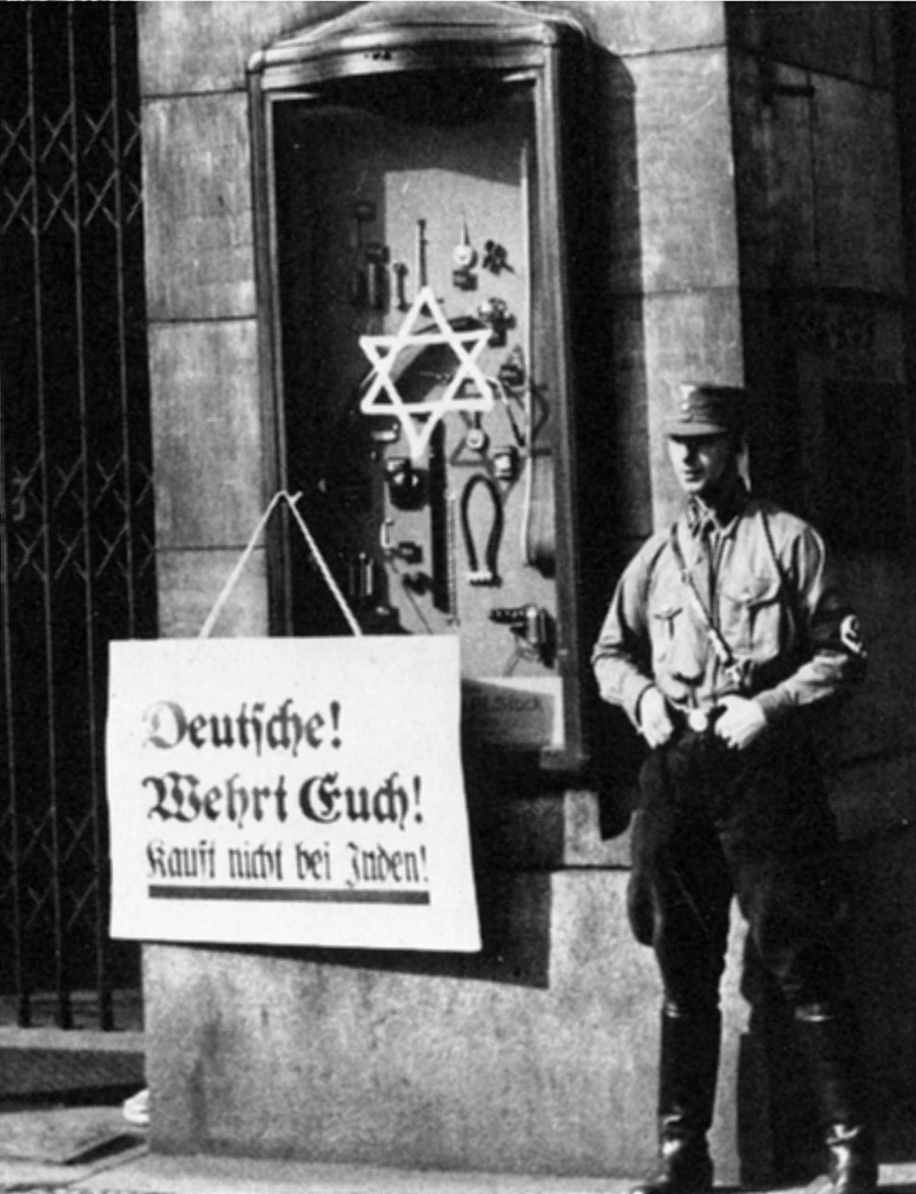
"On April 1st, 1933, the
boycott which was announced by the National Socialist party began. Placard reads, 'Germans,
defend yourselves, do not buy from Jews,' at the Jewish Tietz store."
Berlin.
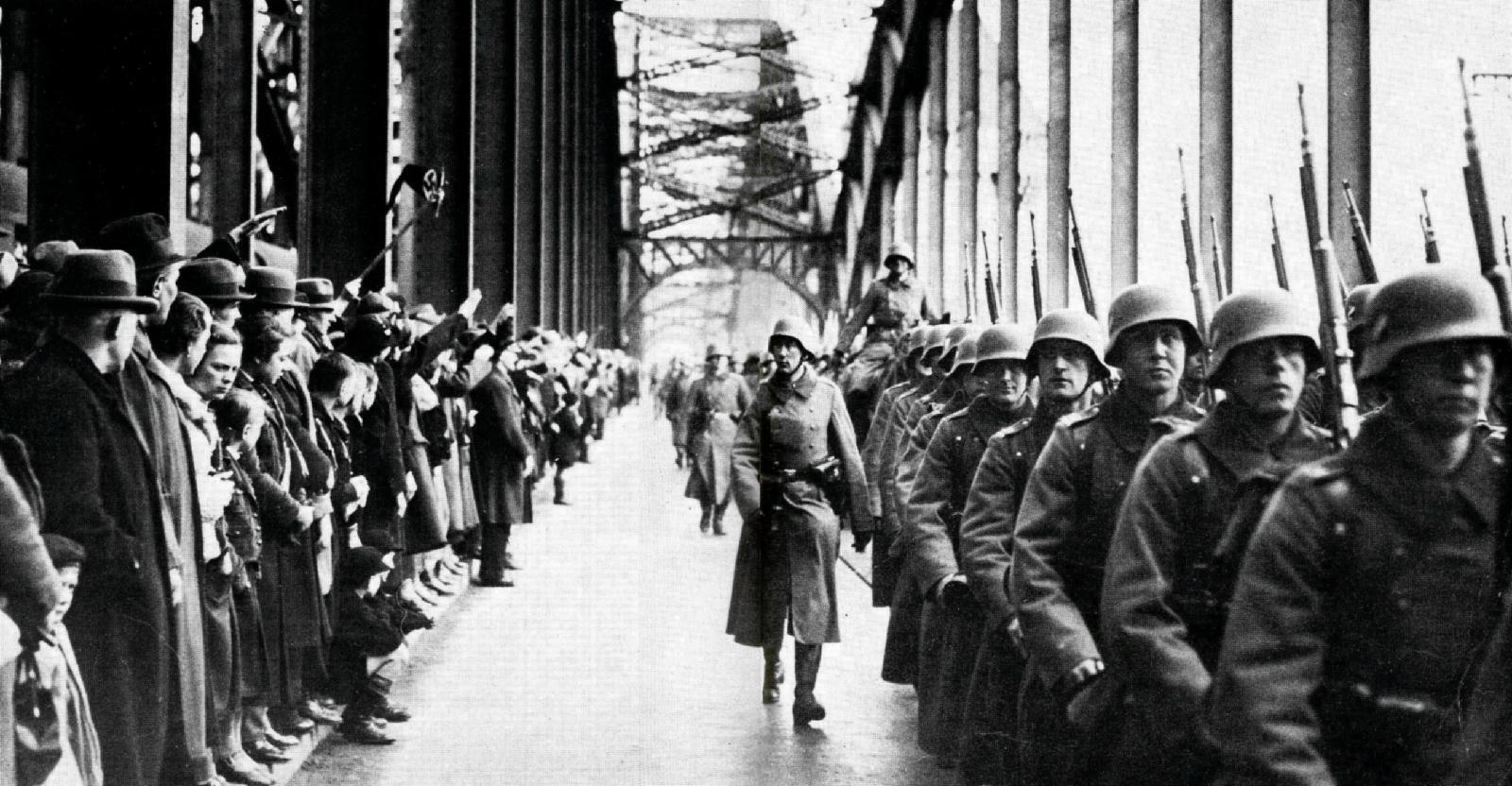
German troops crossing the
Rhine at the Hohenzollern Bridge on March 7, 1936 – in violation of
the Versailles
Treaty ... that neither France nor England seemed to have the will to
enforce
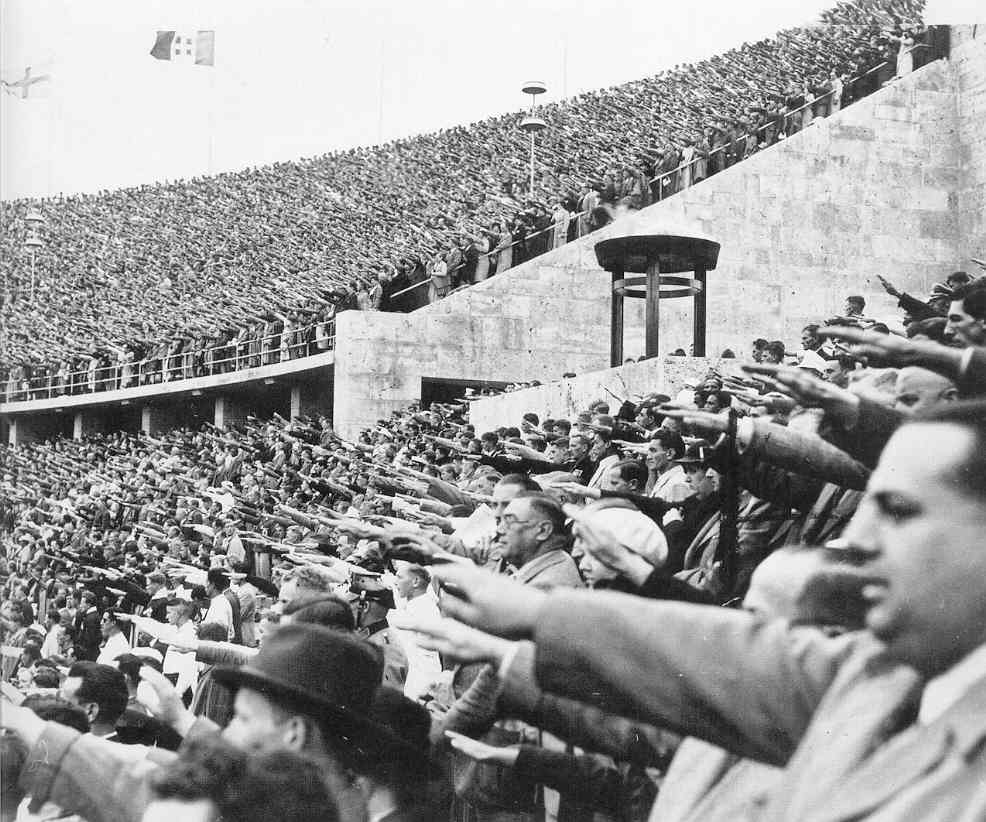
Berlin Olympics -
1936
Hitler also tries to woo America through
Lindbergh – who found himself favorably impressed
with the "progress" Germany had made under the Nazis.
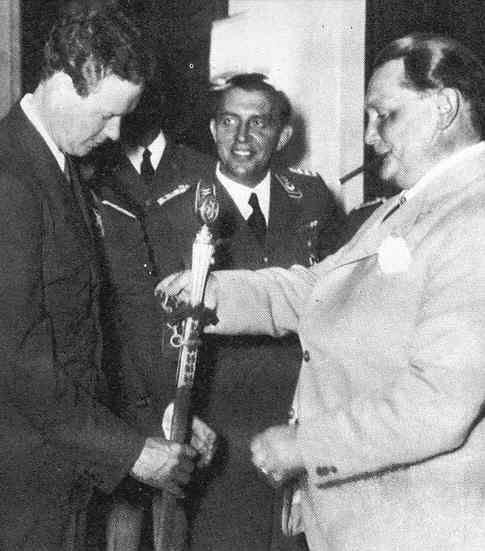 Charles Lindbergh, on a 1936
visit to Germany, inspects a sword with Herman Goering
Charles Lindbergh, on a 1936
visit to Germany, inspects a sword with Herman Goering
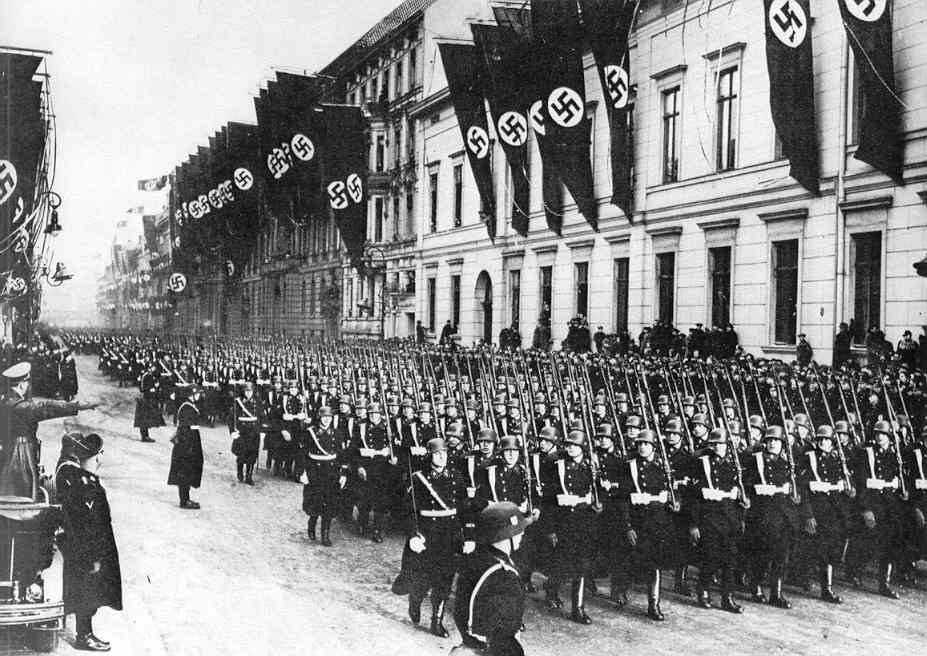 Hitler reviewing his personal
bodyguard: the Leibstandarte-SS – 1937
Hitler reviewing his personal
bodyguard: the Leibstandarte-SS – 1937
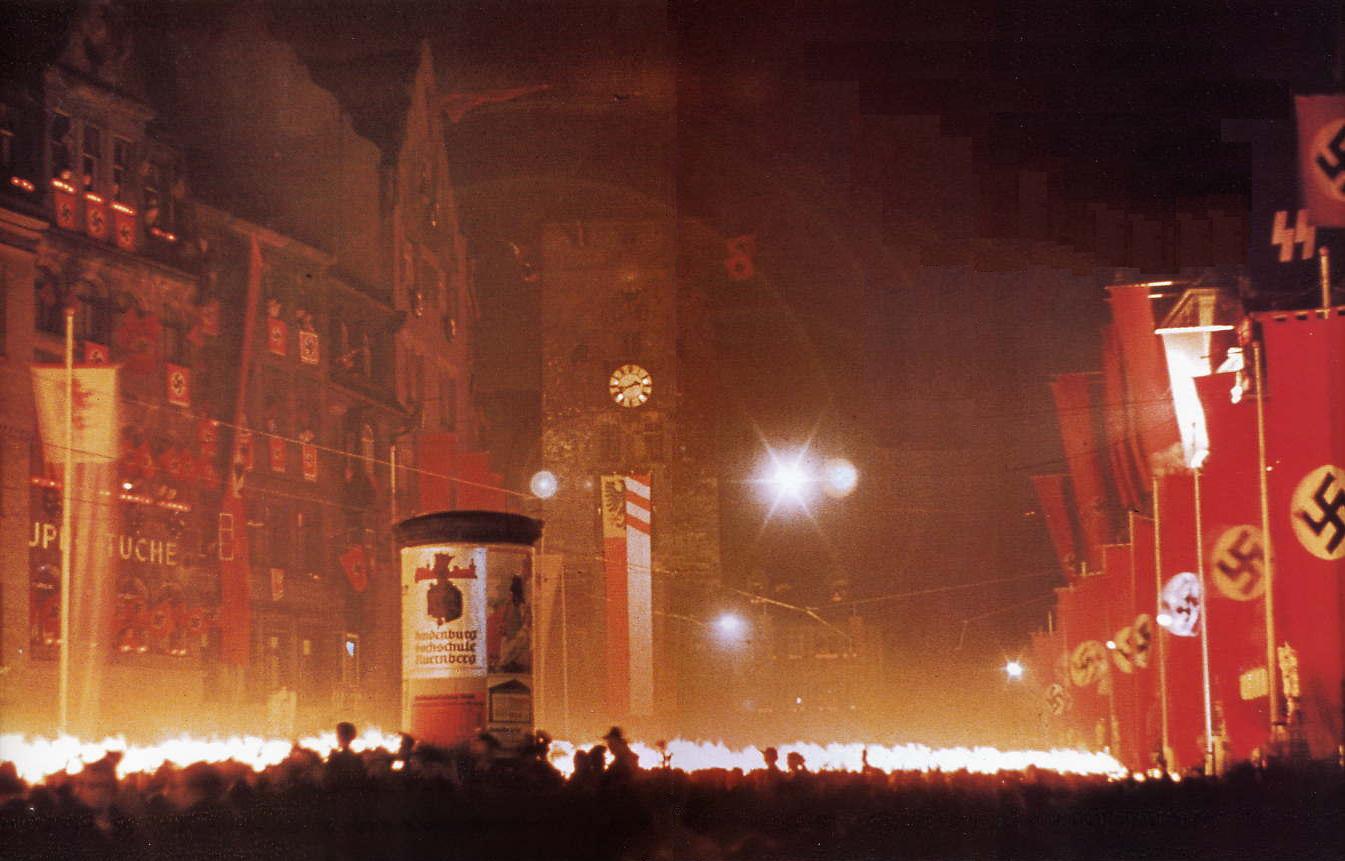
Nazi Party rally in Nuremburg – 1938
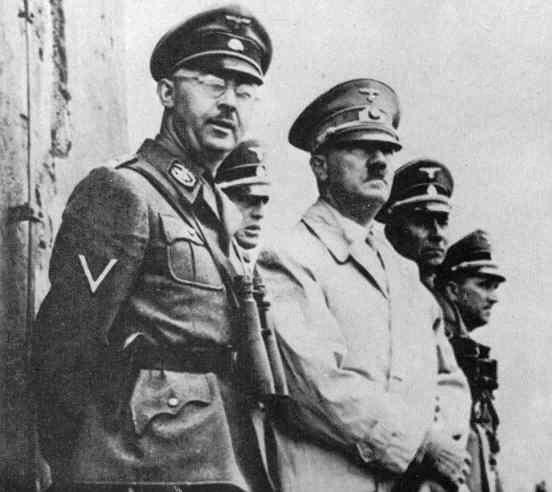 Hitler and
Himmler
Hitler and
Himmler
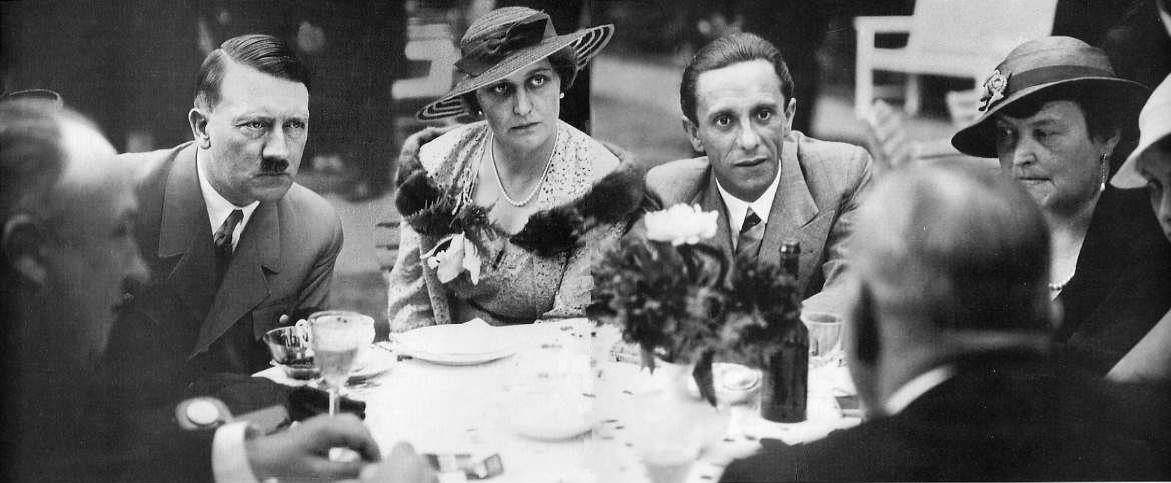
Hitler lunching with top
Nazis (Goebbels on the right)
Hitler undertakes a massive
assault on
Germany's Jews
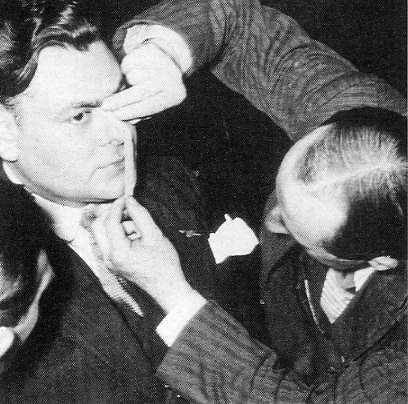 Measuring a Berliner for
Jewish traits
Measuring a Berliner for
Jewish traits
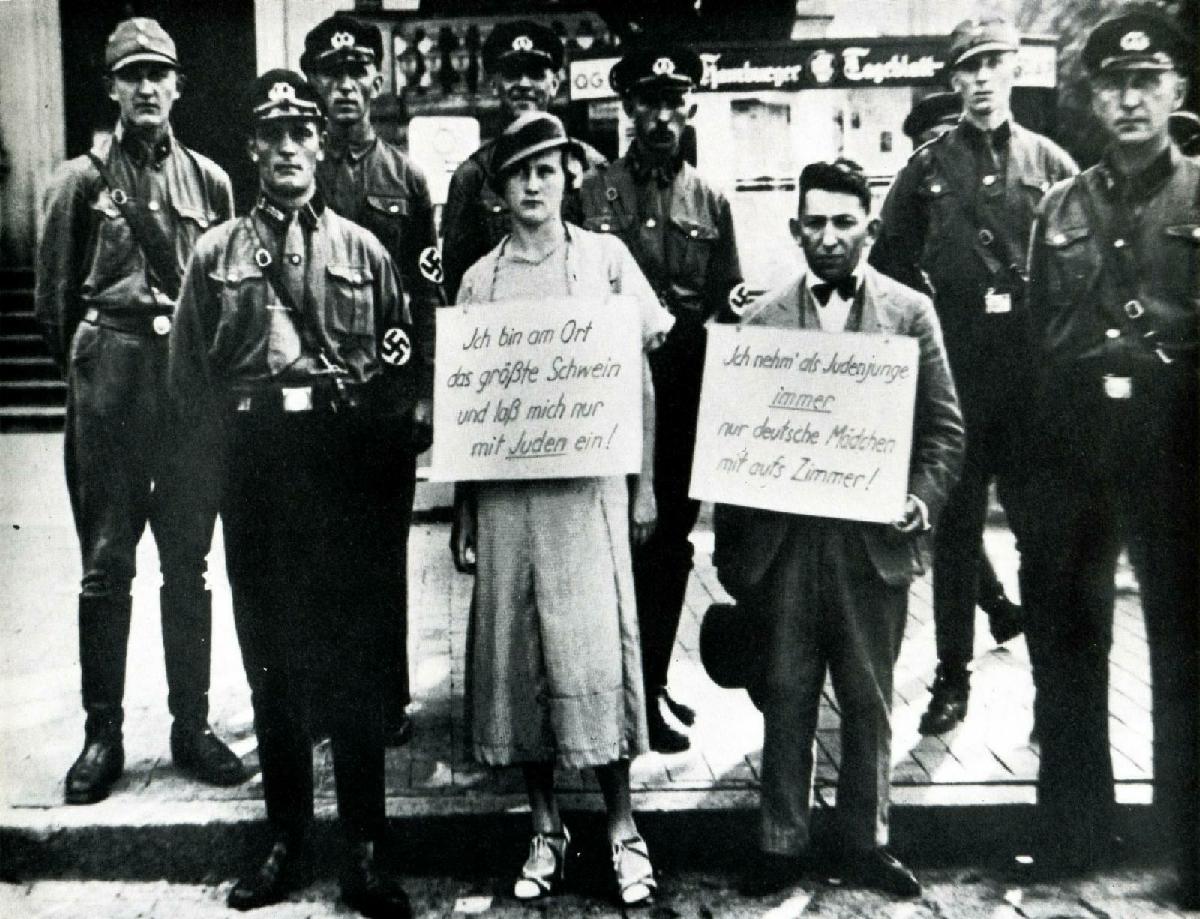
Two Germans accused of having
violated the law
against sexual relations between Jews and Gentiles – Hamburg.
The woman's sign:
"At this place I am the greatest swine for I laid with a Jew." The man's: As a Jewish
youth I always take only German girls to my room."
|
Benito Mussolini had easily seized national power
in 1922 and then undertaken political theatrics designed supposedly to
restore Italian pride, claiming that through his Fascist program the
greatness of ancient Rome had been restored. The Italians themselves
were not terribly impressed. But they played along with Mussolini and
his political band of Fascists, who paraded around like professional
soldiers, trying to impress the Italians with the seriousness of their
Fascist agenda.
Although the Italians themselves were
more motivated by family dinners and music offered in opera style
(Italians were indeed great singers) than by Mussolini's military
antics, Hitler was taken in by Mussolini's theatrics. Consequently, a
partnership developed between Mussolini and Hitler in which, oddly
enough, Hitler seemed to be more the junior partner.
Hitler indeed seemed to model much of his
own Fascist program after Mussolini's. Perhaps this was because by the
mid-1930s, Mussolini had already undertaken a program of military
expansion (in Africa) that Hitler was still only dreaming of.
In 1936 the two leaders signed a
friendship treaty: the Axis Pact. Mussolini now could claim that Berlin
and Rome formed an "axis" around which all of Europe would eventually
revolve. And in 1937 Germany and Italy (and Japan) signed a treaty more
clearly aligning the countries politically against Stalin's rising
Russia, and recognizing the right of each of the treaty powers to full
dominion in their respective theaters of operation.
Mussolini's invasion of Ethiopia – and the West's non-response
Hungering for imperial expansion,
Mussolini gathered 300,000 Italian troops in Northeast Africa in the
Italian colony of Somaliland, with the clear intent of seizing
still-independent Ethiopia next door. This matter of Italian aggression
was brought before the League of Nations, which ultimately did nothing
– the French and English still hoping to enlist Italy against the
threat of a rising Germany and thus not wanting to alienate Mussolini.
Realizing that he would get no opposition
from the Western powers, in October of 1935, Mussolini's troops crossed
into Ethiopia to begin a war that would drag on for another six years.
Italian victory seemed in the making when the Ethiopian Emperor fled
and the Ethiopian capital was seized in mid-1936. But the Ethiopian
tribesmen would continue to fight on guerrilla style against their
Italian occupiers, until the Italians went home in 1941 (to a more
serious fight going on in Europe itself).
Appearing before the League at the point
of the apparent Italian victory, the Ethiopian Emperor outlined the
pitfalls of failing to answer Mussolini's aggression, warning "It is us
today, it will be you tomorrow."
The League did respond with economic
sanctions aimed at Italy, which however were really not enforced. In
fact, an effort to restrict oil sales to Italy was undercut by American
oil industrialists who were quite willing to keep up oil sales to
Mussolini. And the French and English were discovered to be trying to
gain Mussolini's cooperation – through another secret treaty with
Italy, one recognizing the partition of Ethiopia among the three powers.
In fact the only net result of the League's sanctions was to rally the Italians more strongly behind Mussolini.
|
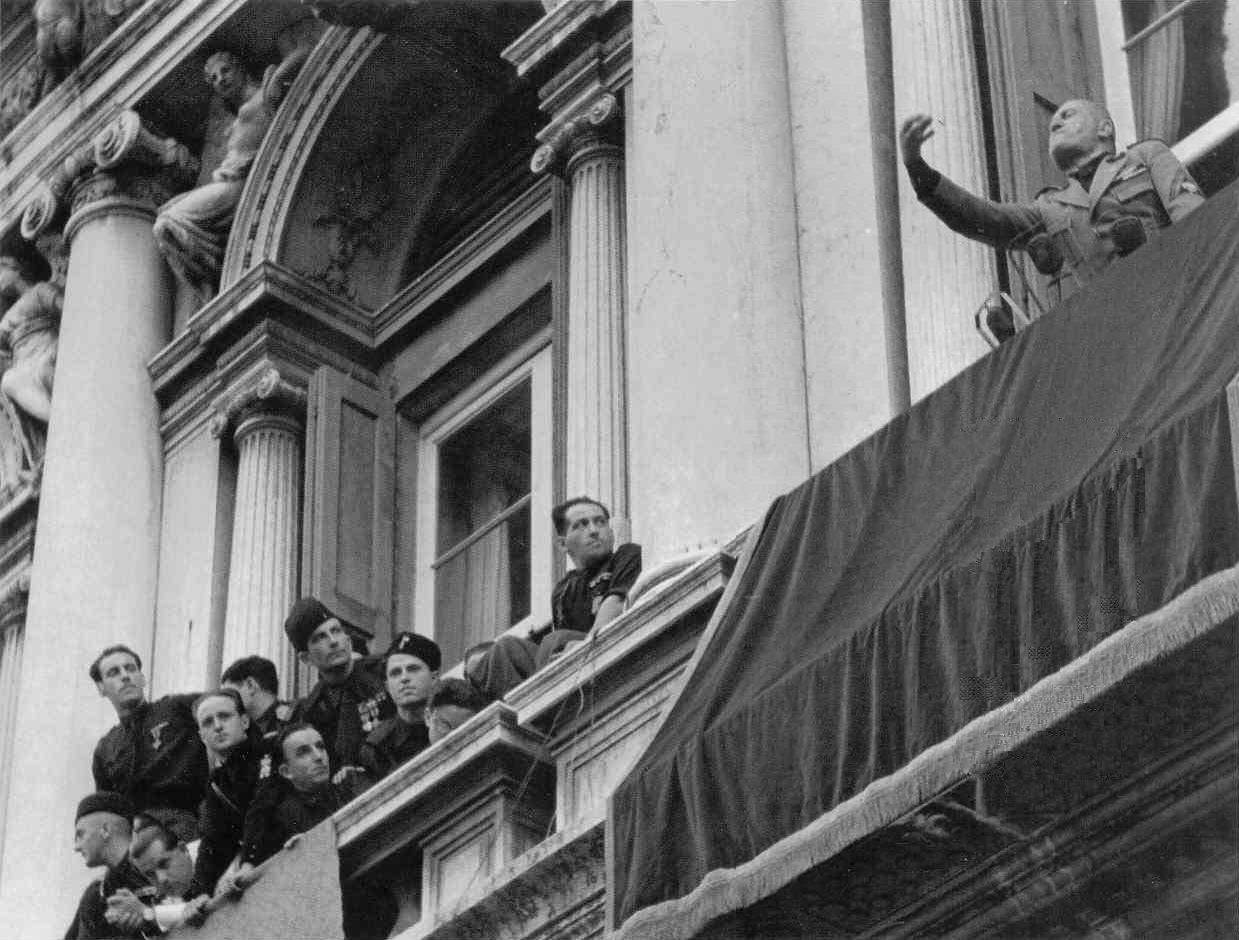
Benito Mussolini pitching
his Fascism to the crowds – 1934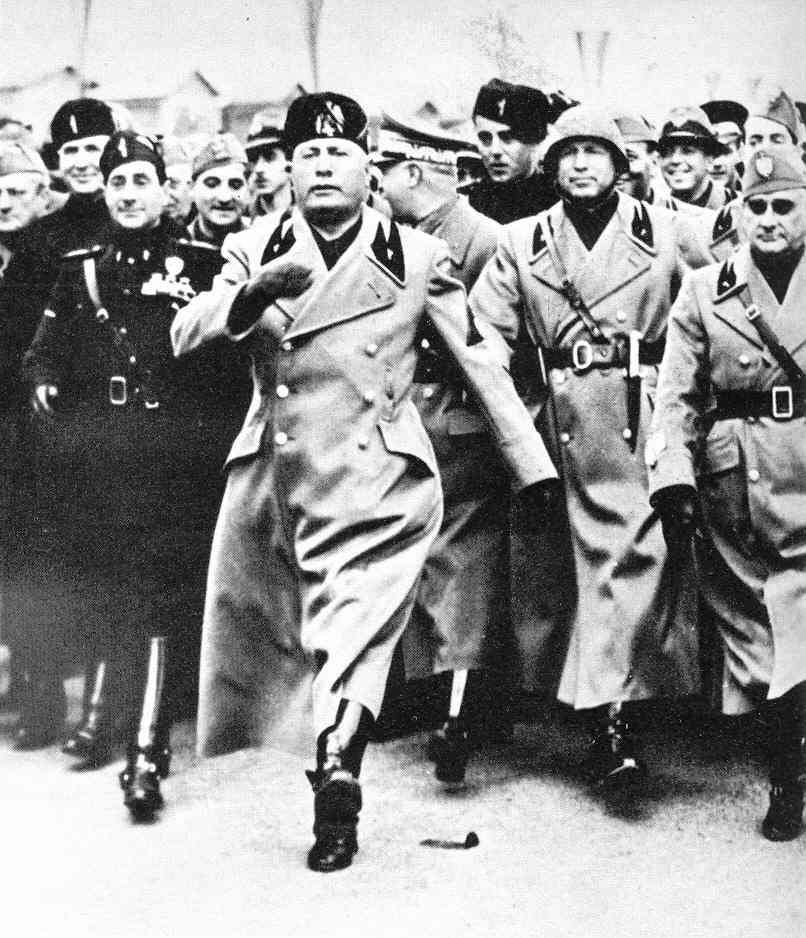
Mussolini aping the German
goose step as he leads fellow Fascists on a march – 1938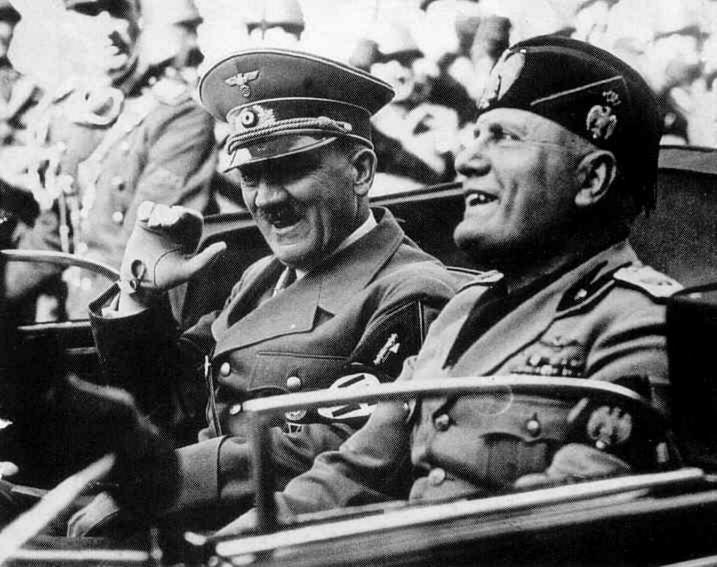 Hitler and Mussolini – 1938
Hitler and Mussolini – 1938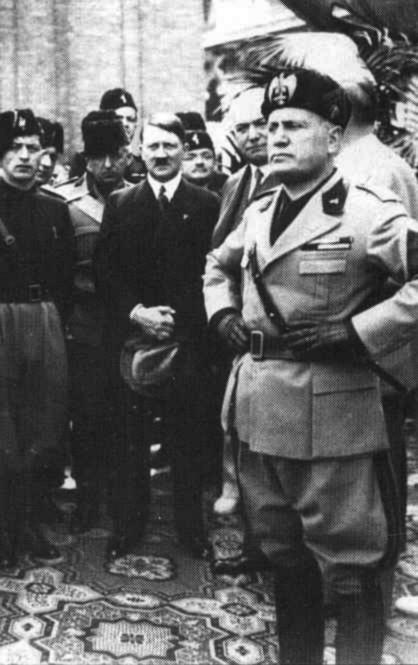
Hitler and Mussolini in
Rome 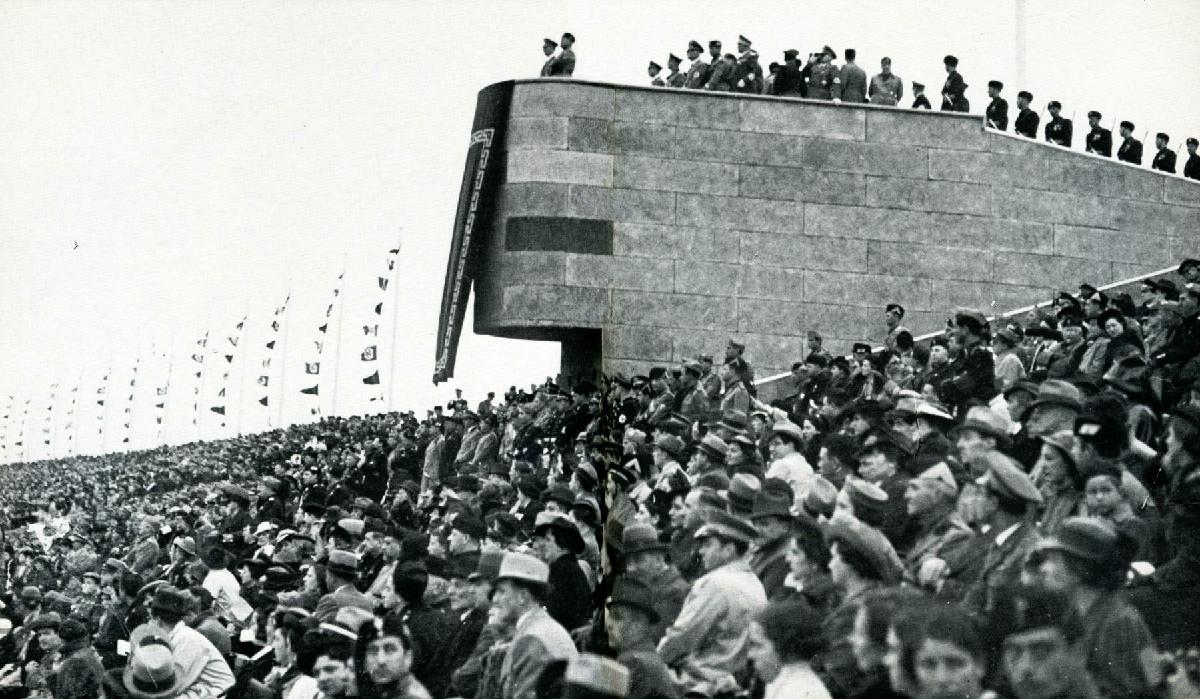
Hitler and Mussolini gaze
down upon a crowd at a Fascist rally in Rome – 1938
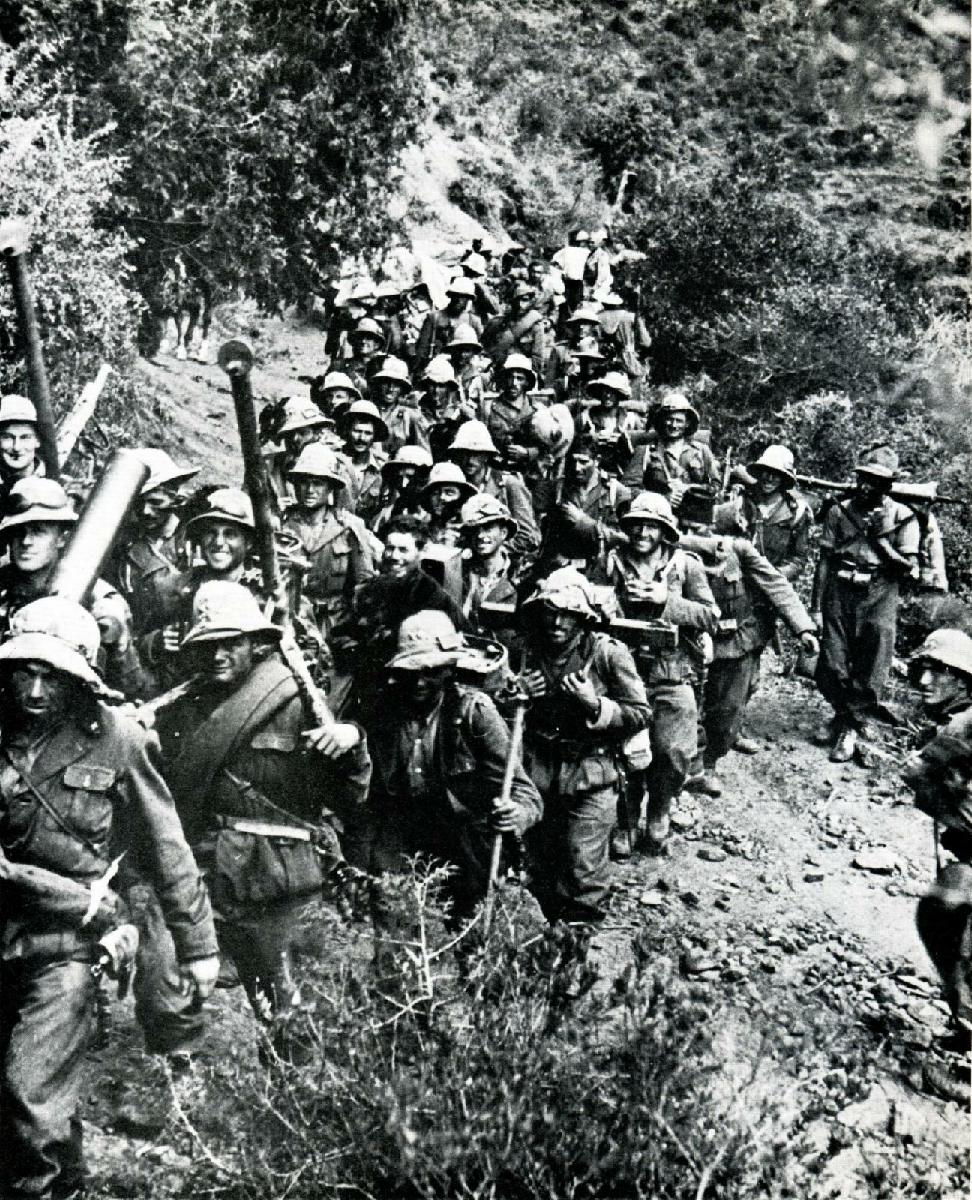
Italian infantrymen in Ethiopia – 1935
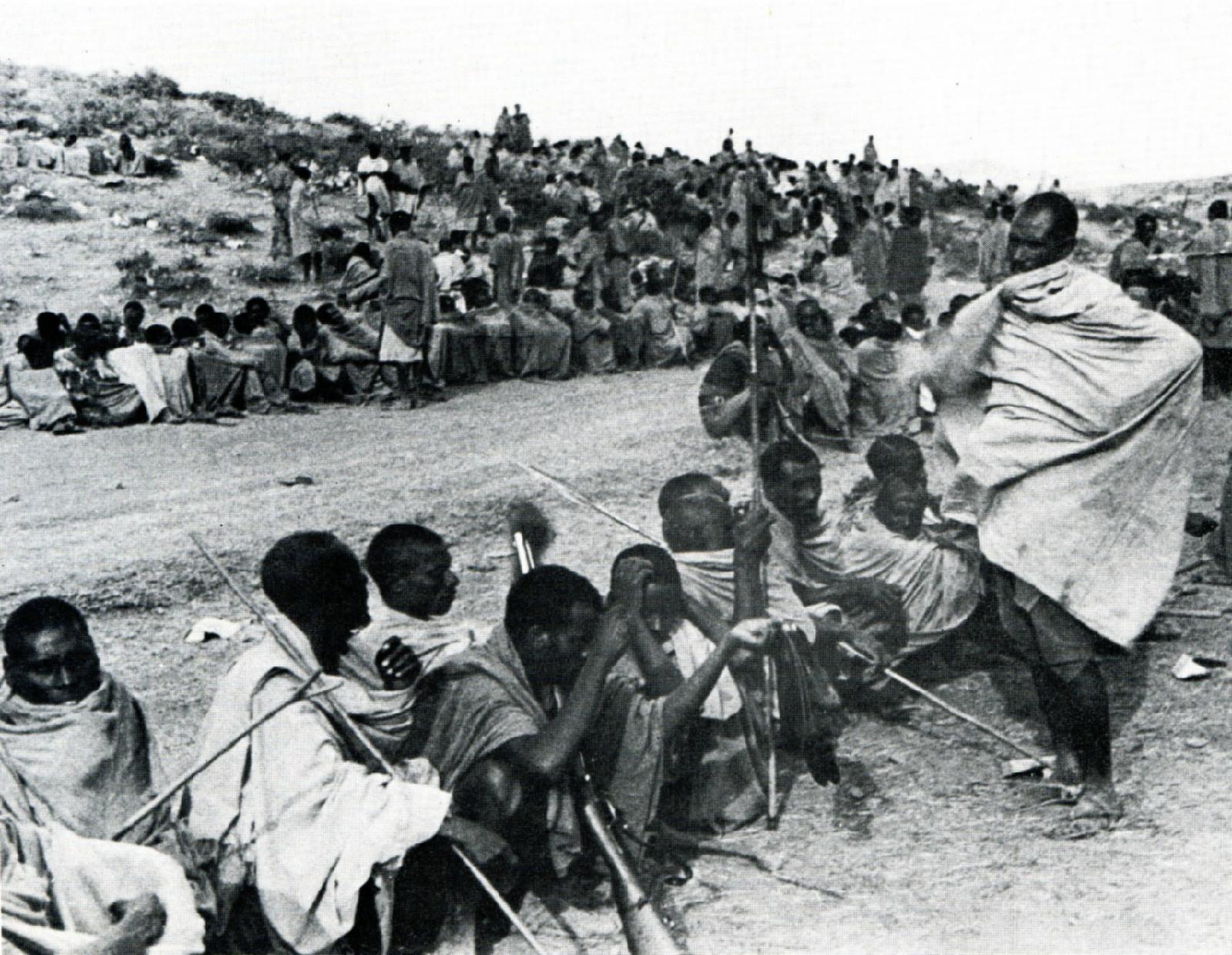
Ethiopian tribesmen – many
of whom defected to the Italians in the war
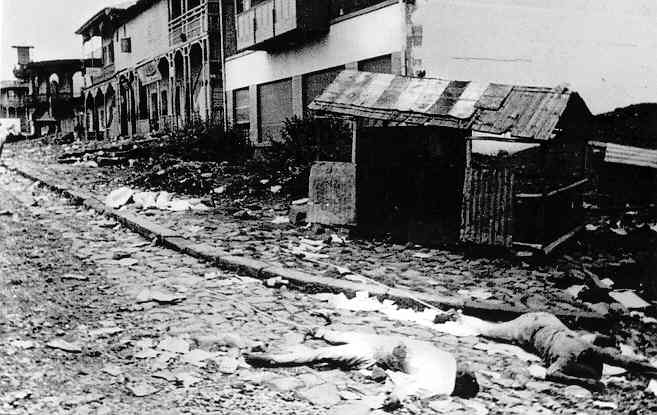 Ethiopians killed by Italian
bombing of their village
Ethiopians killed by Italian
bombing of their village
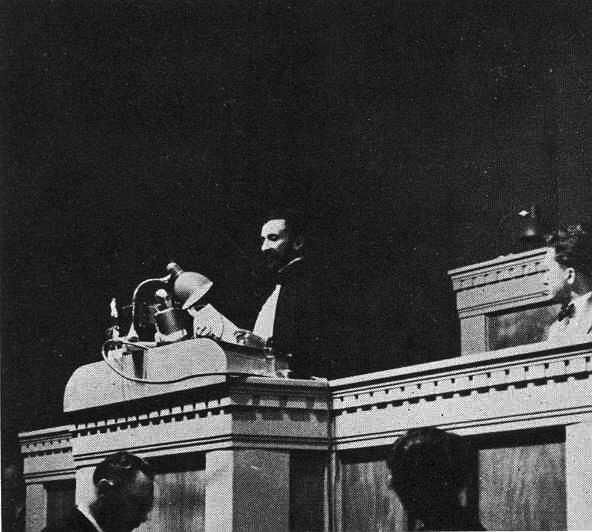 "It is us today, it will
be you tomorrow."
"It is us today, it will
be you tomorrow."
FRANCE AND ENGLAND SEEM TO HAVE LITTLE WILL TO STAND UP AGAINST THE RISING DICTATORS |
|
A divided France of the 1930s
In February of 1934 the growing antagonisms in
France between the political Left and the political Right – greatly
exacerbated by the Stavisky investment fraud which implicated many
Leftist cabinet members – erupted in the form of Paris riots, which
many thought was the prelude to an attempt at a Right-Wing political
coup. Order was restored to France. However, Left-Wing suspicions of
on-going Right-Wing Fascist plots, and similar suspicions by the Right
of Communist plots of the Left to take over France, split the country
into deeply hostile political groupings.
Besides the Left-Right deadlock over the
basic political path the country should take, the evolution of the
larger world of European politics, especially during the 1930s, made
French national politics even more complex. The French could not decide
which rising power to the East, Nazi Germany or Communist Russia, posed
the greater danger to Western, or at least French, civilization. Along
with this went wide disagreement on how to respond to Mussolini in
Ethiopia and the civil war raging in Spain (1936-1939).
In short – France really was not able to
get its act together at a time that it was supposed to be one of the
two major enforcers of the post war international status quo (the other
being Great Britain). Indeed, by the late 1930s France found itself
floundering in a deep domestic political war.
|
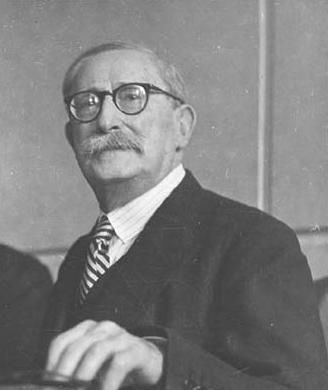 Léon Blum – French
Socialist Party leader and one of France's prime ministers during the French leftist
"Popular Front" of 1936-1938
Léon Blum – French
Socialist Party leader and one of France's prime ministers during the French leftist
"Popular Front" of 1936-1938
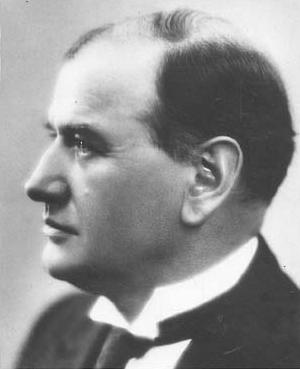
Édouard Daladier – head of the French "Radical" Party and French Prime Minister
after the fall of the Popular Front in 1938 – until just before Germany's
invasion of France in 1940
|
The British quest for peace – at any price
The Conservative Party leader Stanley Baldwin
dominated British politics during much of the period following the
Great War. Baldwin’s governance was characterized by a policy of
peace-at-any-price. He understood that the British did not want ever to
go to war again; that they expected him to keep them from diplomatic
entanglements and any military buildup, viewed at that time as largely
responsible for the Great War of 1914–1918; and that his first priority
as Britain’s leader was to get the country back on sound economic
footing.
Thus he cut back tremendously on British
military spending and strength at a time that Germany was rebuilding
its military power (happening even before Hitler took charge of Germany
in 1933) – in well-recognized violation of the terms of the Versailles
Treaty of 1919 and the Locarno Pact of 1925. Every effort was made by
Baldwin (and most British politicians and intellectuals) to excuse
Hitler's moves to remilitarize Germany – on the basis that Germany was
only compensating for the horrible injustices inflicted on Germany by
the now notorious Versailles Treaty.2
Thus Baldwin and fellow Conservative
Party member Winston Churchill (himself a former party leader) found
themselves constantly at odds over this issue of Great Britain's
pacifism in the face of German remilitarization. Baldwin viewed
Churchill as a war-monger who wanted to drag Great Britain into an arms
race and thus another war with Germany. Churchill viewed Baldwin as one
who invited German military adventurism by the obvious lack of English
resolve to stop Hitler before he became so strong that there would be
no way to block his military ambitions.
Basically, Baldwin was working out of the
spirit of the moment, of the times he lived in. Churchill was working
out of a longer sense of British history – and its long-standing role
as balancer of power on the European continent (as for instance in the
days of Napoleon in the early 1800s). History would soon be the judge
of which of the two had it right.
2The
spirit of total pacifism was so strong in Britain that not only did the
British Communist and Labour Parties on the Left denounce British
remilitarization but also in 1933 the Oxford Union debated the issue of
British intervention in the Japanese takeover of Manchuria, producing
(with a vote of 275 to 153) a final resolution declaring that "this
House will in no circumstances fight for its King and Country." The
resolution brought on much debate not only in Britain, but around the
world. Churchill was loud in his contempt for this resolution!
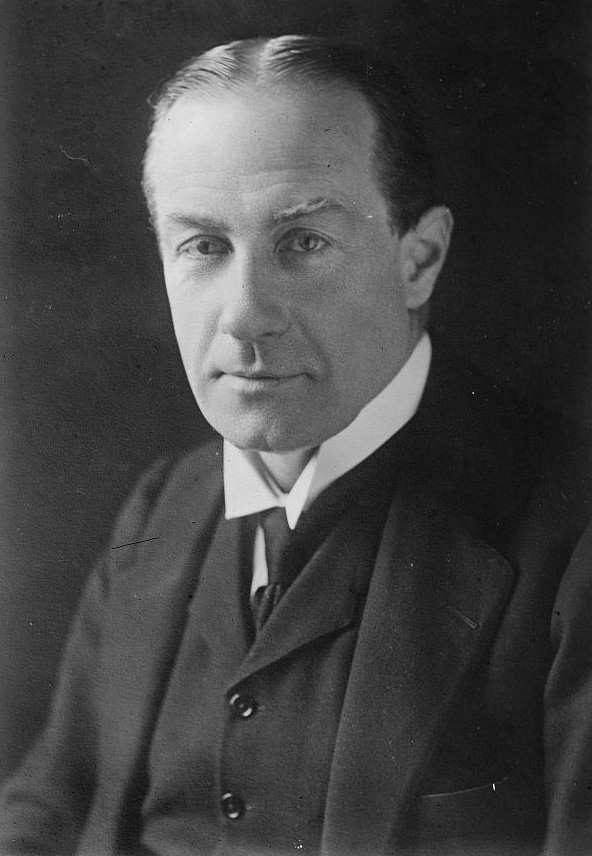 Stanley Baldwin (Conservative
Party) – British Prime Minister – 1923-1924; 1924-1929; 1935-1937
Stanley Baldwin (Conservative
Party) – British Prime Minister – 1923-1924; 1924-1929; 1935-1937
|
Chamberlain's "appeasement" policy
Then in May of 1937 an exhausted Stanley Baldwin
stepped down and the new Conservative Party leader Neville Chamberlain
became English Prime Minister. Whereas Baldwin had been a pacifist,
Chamberlain was actually rather pro-German. As the 1930s developed, it
appeared that Great Britain too was facing a choice of which of the two
growing military powers to the East, Communist Russia or Nazi Germany,
was the greater threat to the peace of Europe (and thus also the
world). Chamberlain took the view that it was the Russian Communists
that posed the greater danger, and a policy of "appeasing" Germany's
Hitler (and Italy's Mussolini) would bring the nations of West and
Central Europe into a broad anti-Communist/anti-Russian front.
But Great Britain (and Europe) would soon discover the shortcomings of the appeasement approach to Hitler and his doings.
|
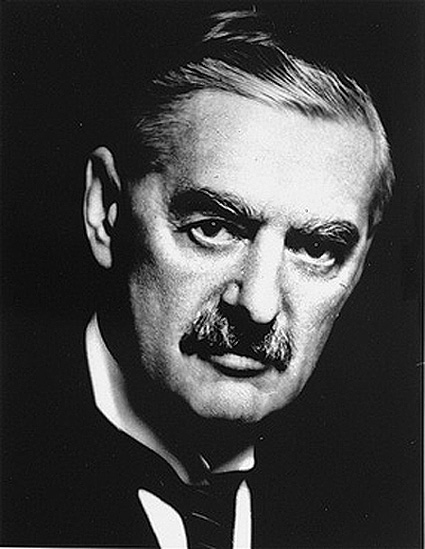 Neville Chamberlain (Conservative
Party) – British Prime Minister – 1937-1940
Neville Chamberlain (Conservative
Party) – British Prime Minister – 1937-1940
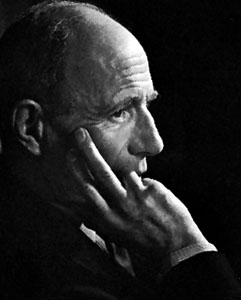 Edward
Frederick Lindley
Wood, 1st earl of Halifax – British Foreign Minister – 1938-1940 – also an "appeaser" toward
Germany Edward
Frederick Lindley
Wood, 1st earl of Halifax – British Foreign Minister – 1938-1940 – also an "appeaser" toward
Germany
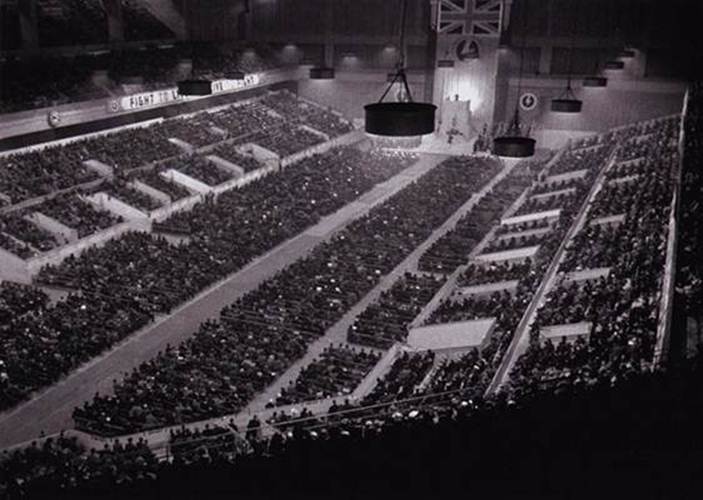 The British Union of
Fascists
and National Socialists Rally – London, 1936. One of the largest public meetings held in
Britain in the 1930s ... and indicative of the mixed sentiment of the
British
about which way to turn in the face of continental
developments
The British Union of
Fascists
and National Socialists Rally – London, 1936. One of the largest public meetings held in
Britain in the 1930s ... and indicative of the mixed sentiment of the
British
about which way to turn in the face of continental
developments
THE SPANISH CIVIL WAR (1936-1939) |
|
Although Spain was a Constitutional Monarchy (like
Great Britain and most of the rest of the European continent) the
country had actually been run by a system of local bosses (caciques)
with little interest in turning Spain into a modern society. Spain
itself was highly divided as to the direction it wanted to go,
especially after the Great War, which Spain stayed out of but which
benefitted a small group of industrial entrepreneurs who sold goods to
the combatants. The vast and highly traditional countryside (strongly
Roman Catholic and even semi-feudal in mentality) was greatly alienated
by this small intrusion of modernity into a society still romantically
attached to the glorious past of the 1500s, a past that was very
unlikely to ever return. Then there were the new industrial workers who
grudgingly took their place in Spain's factories, who felt a bit of
kinship with the Russian workers who similarly had moved abruptly from
feudalism to modern industrial society – led by Communist idealists
(the Bolsheviks). In short, Spain was a confused and highly divided
society.
Into that confusion stepped Spanish
General Primo de Rivera – who seized power in 1923, and forced economic
and social discipline on Spain, settling things down a bit (and
eliminating the caciques) – but whose rule gradually began to draw
strong criticism from impatient modernizers who felt that his
Mussolini-like grip over Spanish society (and the Spanish monarchy that
supported him) was only serving to block real social progress.
Ultimately both Rivera and King Alfonso, tiring of the situation, in
1931 called for a referendum on Spain's future. The results went in
favor of a Republican government, and Rivera stepped down and the king
abdicated.
But the Republican government's move to
secularize Spain's Catholic culture (undercutting the Church's role in
the country's schooling and cultural disciplines, such as its stand on
marriage and divorce) served only to deepen the cultural division that
split Spain into two hostile groups, the Republicans concentrated
heavily in urban Spain – actually bitter about the slowness of the
social reforms (and increasingly of a Communist or anarchist frame of
mind) – and the more rural Nationalists who clung desperately to a
clearly dying traditional Catholic Spain.
Back and forth power swung in the
national parliament (the Cortes) until by mid-1936 the battle had moved
to the streets in the form of fighting between the two groups: the
Conservative Falangists (backed by a very conservative Spanish
military) and the proto-Communist Republicans (supported by 200,000
Asaltos or fighters). This was the signal for General Francisco Franco
Bahamonde to leave his position in Morocco with accompanying
Nationalist troops and head to Spain, to fight the Republicans. At this
point the very bloody Spanish Civil War broke out.
But this civil war did not actually
remain much of a civil war. Instead it turned itself quickly into a
test run of the superpowers, especially Germany and Italy which
intervened on Franco's side, to try out their new military products and
strategies (dive bombers, for instance). At the same time, Stalin sent
a huge number of advisors to help the Republicans against Franco – as
did also France and Britain, although only on a very small scale.
Volunteers poured in from America serving on one side or another,
Hemingway, for instance, actually serving with the Republicans –
building his 1940 novel, For Whom the Bell Tolls, on his own experience in the war.
Feelings ran very hot on both sides of
the war, both sides destroying villages (and killing villagers) caught
in the crossfire. And major atrocities occurred: Leftist Republicans
killing priests and raping nuns – and the Nazi allies of Franco
leveling the town of Guernica as practice in developing divebombing
techniques that would later be used by Hitler in his conduct of
Blitzkrieg (Lightning War).
Little by little Franco's Falangists
(with a lot of help from the Germans and Italians) were able to gain
ground against the Republicans, until in 1939 Madrid was finally taken
by Franco, and the war came to a halt.
Spain was devastated. And it
would have presiding over it a dictator determined to shape Spain
exactly as he himself determined, all the way up until his death
decades later (1975).
Also, Spain was exhausted, and
in no hurry to get involved in another war (they would also sit out
World War Two).
But everything that pointed to the tragedy that
was about to break out in Europe was contained in those events of
1936–1939. The Spanish Civil War, in fact, was simply a dry run
on the larger war that Hitler had planned for Europe. And the
responses of all the major players to the events focused on Spain would
resemble very closely how the diplomacy and military development would
occur as events leading up to World War Two. But few understood
this at the time, especially the British and French who continued to
hope that they somehow knew the formulas for keeping the peace in
Europe. Spain taught them nothing.
|
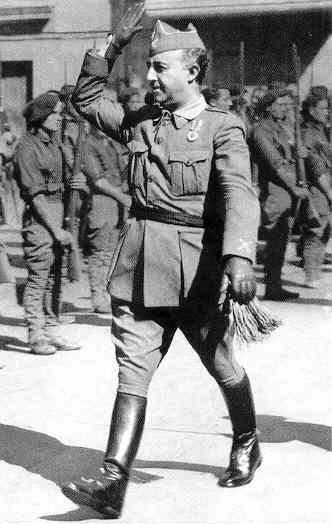 Francisco
Franco – leader of the Falangists or Nationalists ... who also absorbed the traditionalist Carlists into his organization
Francisco
Franco – leader of the Falangists or Nationalists ... who also absorbed the traditionalist Carlists into his organization
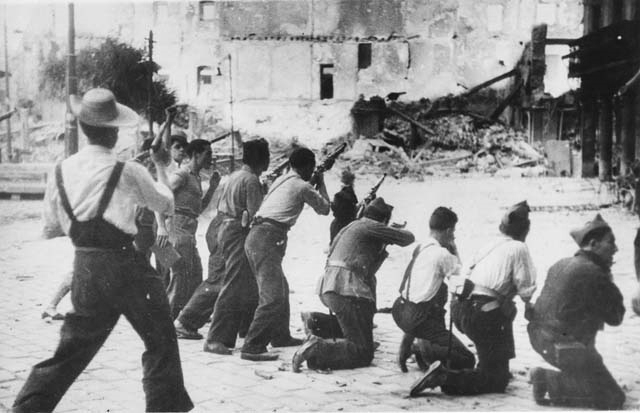 Republican militia
closing in on Nationalists barricaded in the ruins of the Alcazar in
Toledo
Republican militia
closing in on Nationalists barricaded in the ruins of the Alcazar in
Toledo
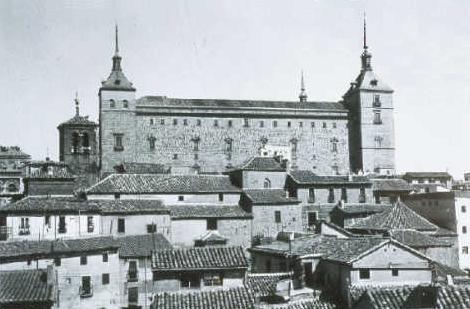 The famous Alcazar in Toledo,
where the Nationalists held out for days against the Republicans,
was razed to the ground – August 1936.
The famous Alcazar in Toledo,
where the Nationalists held out for days against the Republicans,
was razed to the ground – August 1936.
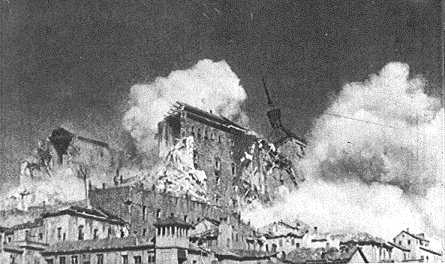
On
September 27, Franco's Nationalist forces reached Toledo and drove the
Republicans off – thus ending the siege – and making Franco the hero
of the Nationalist cause. Two days later Franco proclaimed
himself Generalissimo and shortly thereafter took the title as Head of State.
When Seville fell to the Nationalist troops, 200,000 workers (heavily
Communist) were stirred to counter-action in Madrid by the passionate
Dolores Irarruri ("la Pasionaria"). This was a call to arms of
those loyal to the Leftist Republic.
|
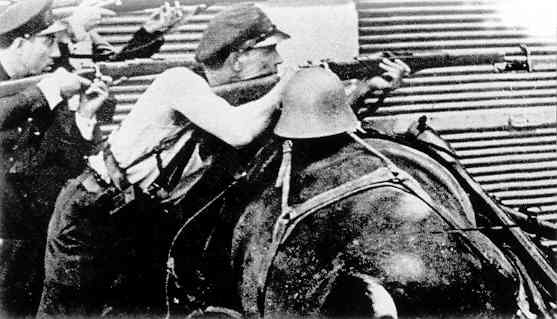 Communist militiamen during
the early stages of the Civil War
Communist militiamen during
the early stages of the Civil War
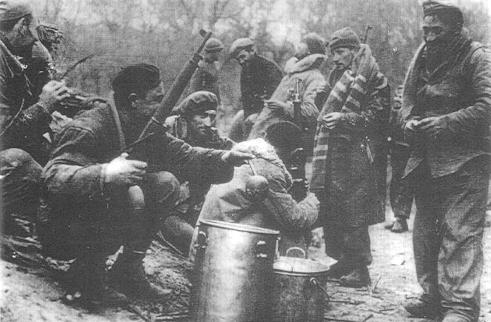 Republican International
Brigade troops at Casa de Campo on the western outskirts of Madrid during the battle against
Franco's invading Nationalist forces – November 1936
Republican International
Brigade troops at Casa de Campo on the western outskirts of Madrid during the battle against
Franco's invading Nationalist forces – November 1936
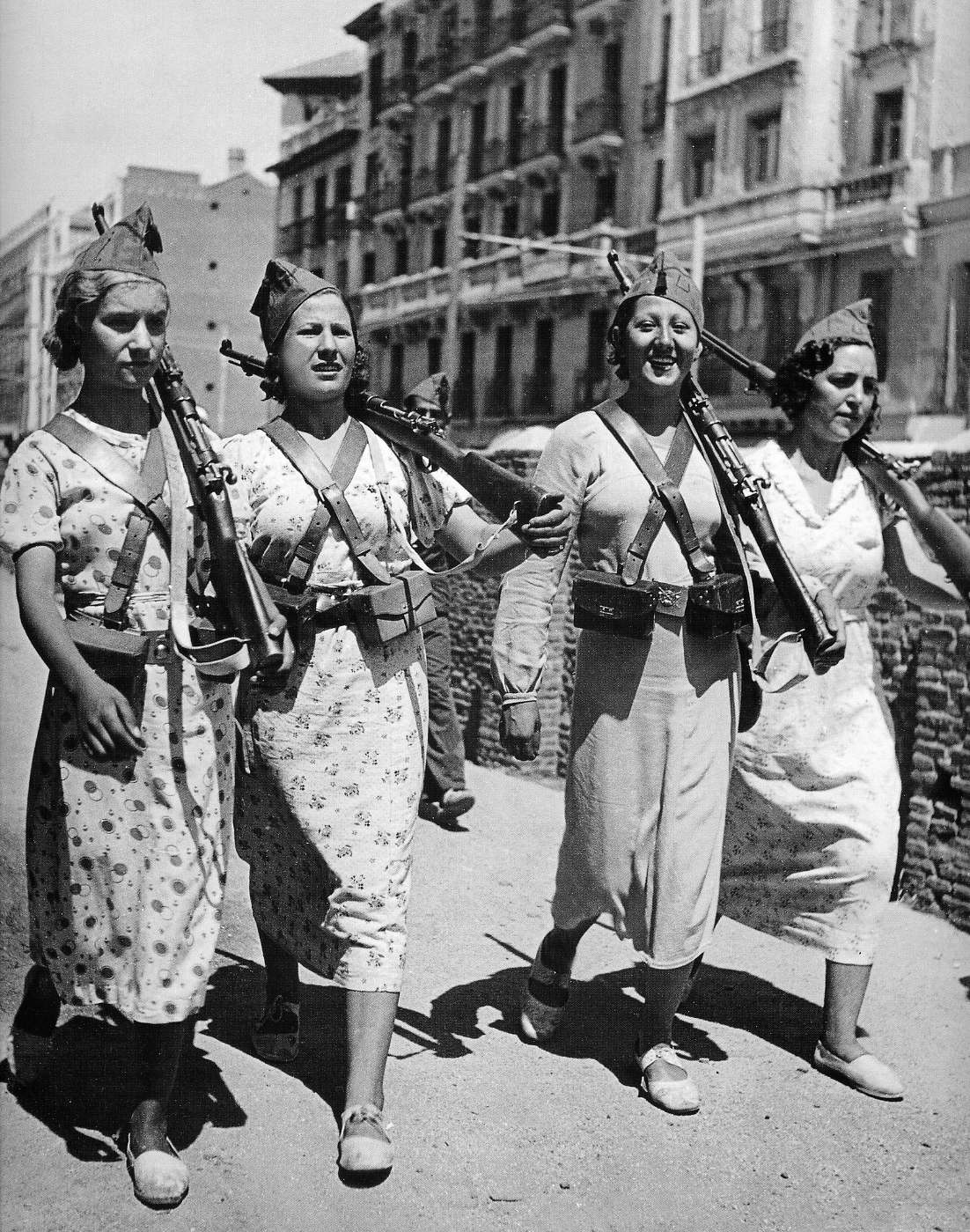 Spanish loyalist (Republicanist)
women militia
Spanish loyalist (Republicanist)
women militia
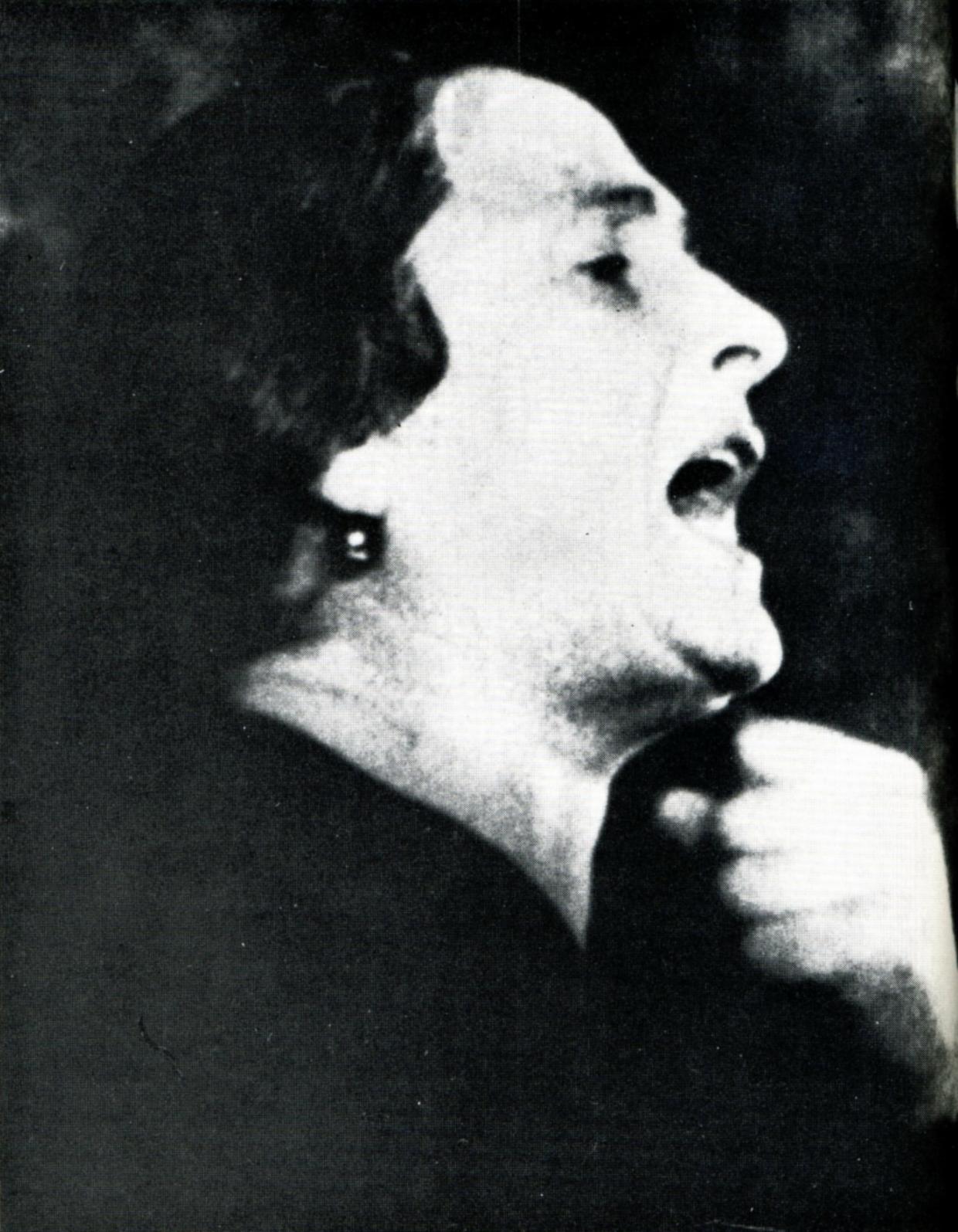 Dolores Ibarruri - "la Passionaria" stirs Communists to action in support of the Republican cause
Dolores Ibarruri - "la Passionaria" stirs Communists to action in support of the Republican cause
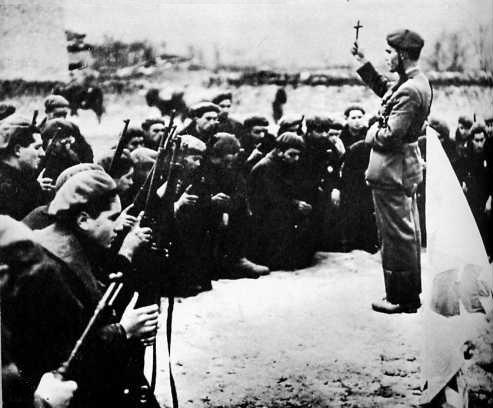
Carlist requetés receive
the benediction before an assault on Irun – 1936
|
International Involvement
Seeing a fellow Popular Front Government in Spain under threat by
Rightist forces, Leon Blum's Leftist Popular Front government in France
quickly sent 30 French planes and pilots to help the Republican
government crush the rebels. But in turn, Franco called upon the
Nazis of Germany and the Fascists of Italy to come to the aid of the
Nationalists' cause. By the end of July German and Italian
planes were arriving in Morocco to assist Franco in his revolt against
the Republican government of Spain. Thus the Spanish civil war became
from the very outset an international issue.
However, the Spanish Civil War became an international issue not just because
foreign countries wanted to help out one side or the other in the
struggle – but because the war in Spain gave a number of countries the
opportunity to develop and test larger political, military and
diplomatic strategies of their own.
Battle of Guadalajara (8 March – 23 March 1937)
Mussolini's
Italians and Franco's Nationalists combined forces to
attack Madrid from Guadalajara. Vastly outnumbering the
Republican forces, the Italians and Nationalists were at first
successful in taking one small town after another. But bad
weather – and the arrival of the International Brigade stiffened the
Republican defense (though they were still outnumbered 2 to 1).
The Republican air force was also operating from concrete runways –
whereas their opponents were grounded with an airstrip of mud.
Gradually the Republicans began to push the Italians and Nationalists
into full retreat. The Italians lost some 6,000 men in the action
– and Mussolini lost a huge amount of prestige, for he had personally
organized the Italian effort in order to gain the prestige of what he
originally thought was going to be a grand victory.
|
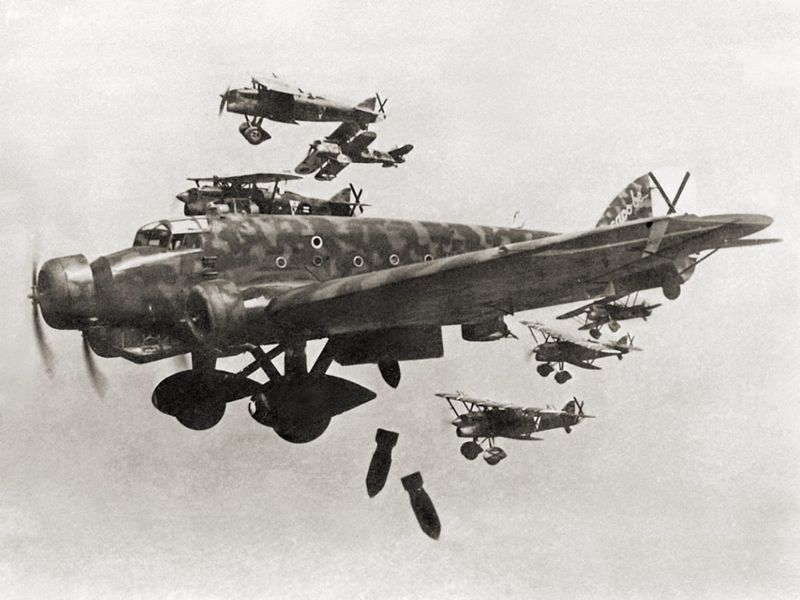 A Savoia-Marchetti SM.81
during a bombing raid in the Spanish Civil War
A Savoia-Marchetti SM.81
during a bombing raid in the Spanish Civil War
|
The bombing of Guernica, April 26, 1937
The bombing of Guernica was an aerial attack by the German Luftwaffe
squadron known as the Condor Legion against the Basque city of Gernika
(Spanish: Guernica).
|
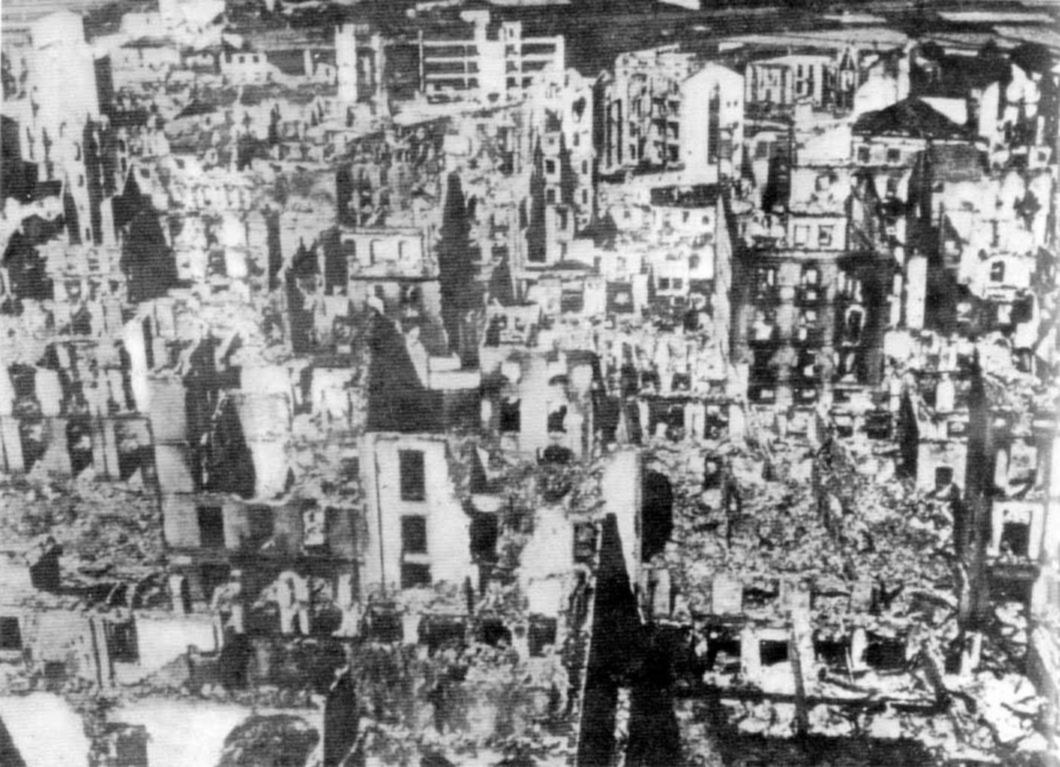 Guernica, after the bombing
of April 26, 1937
Guernica, after the bombing
of April 26, 1937
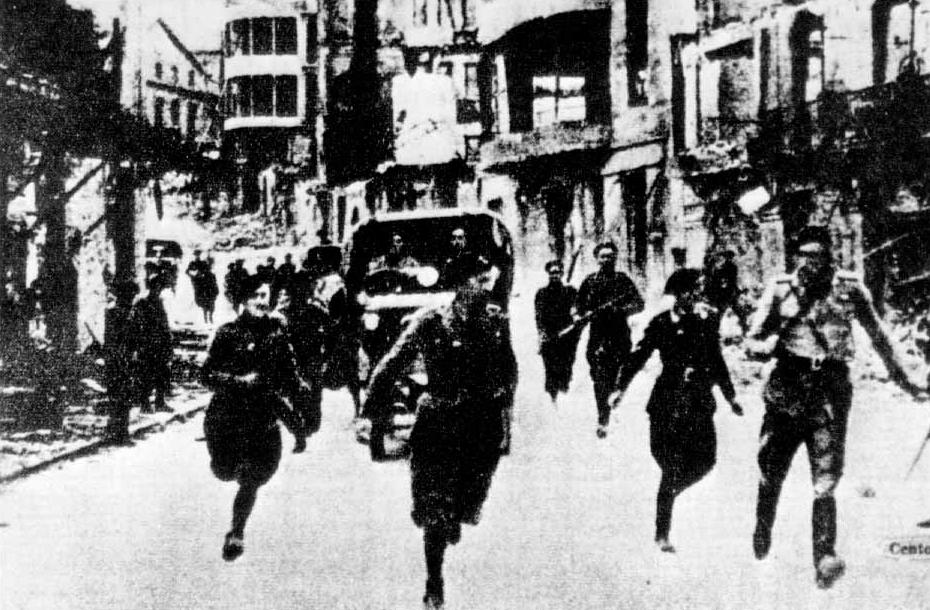 Italian troops entering Guernica
after the bombing
Italian troops entering Guernica
after the bombing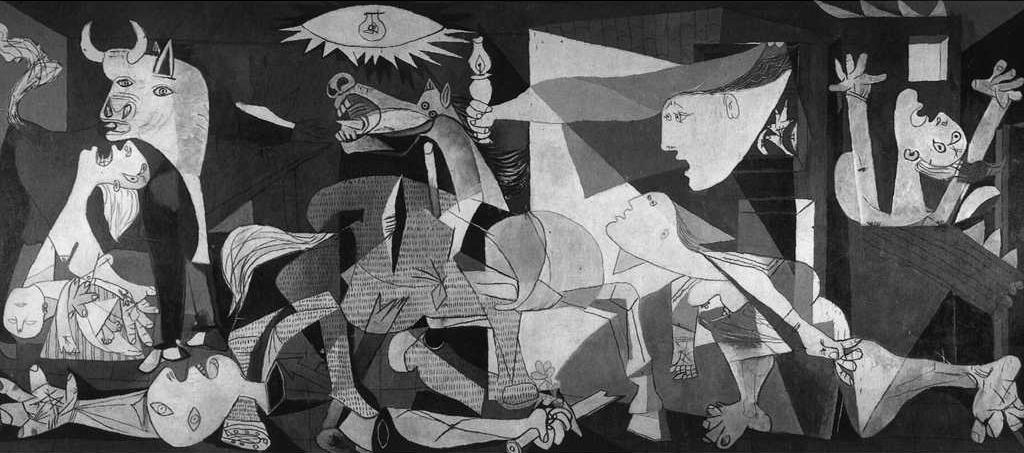
Pablo Picasso – Guernica – 1937. The huge mural was produced
under a commission by the Spanish Republican government to decorate the Spanish Pavilion at
the Paris International Exposition (the 1937 World's Fair in
Paris)
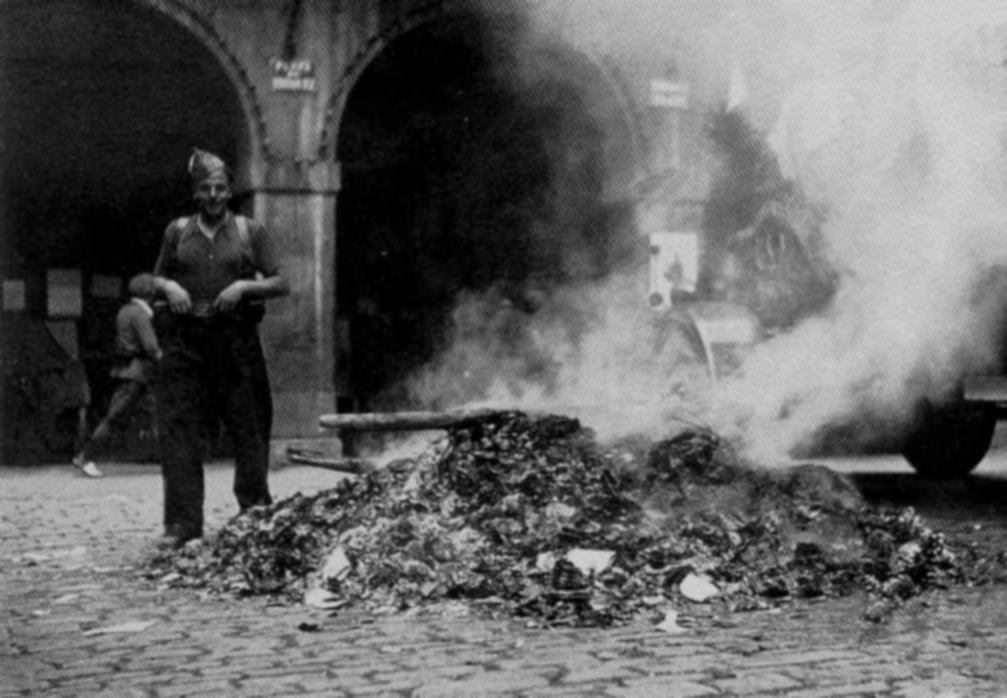
Francoists burning Basque
secular school textbooks in Guernica
The Catholic Church offers its full support to Franco in his overthrow of the democratically elected Spanish Republican government
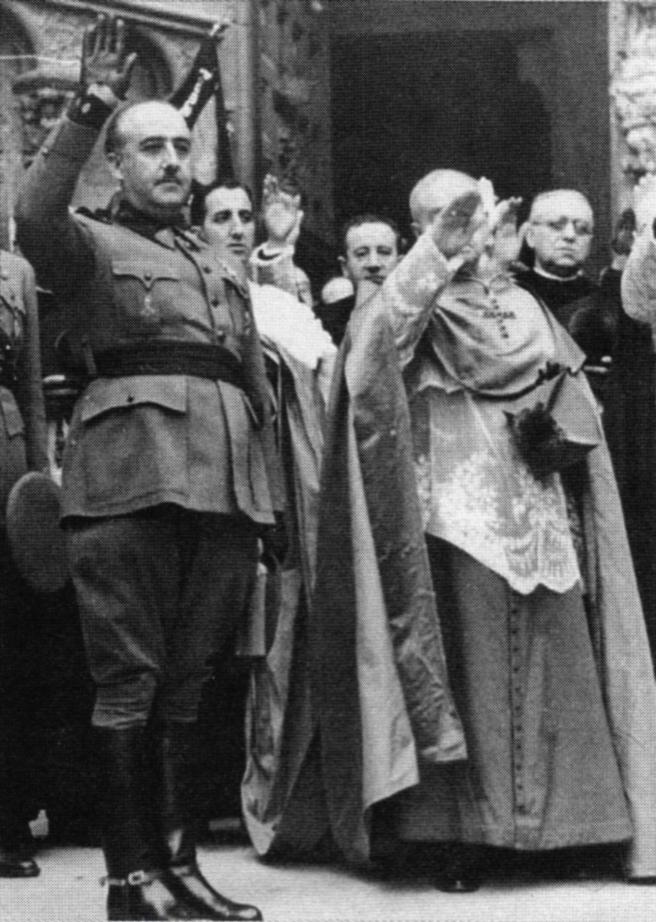
The Spanish Catholic Church
demonstrating its support of the Falangist (Fascist) General Francisco Franco – November 1938
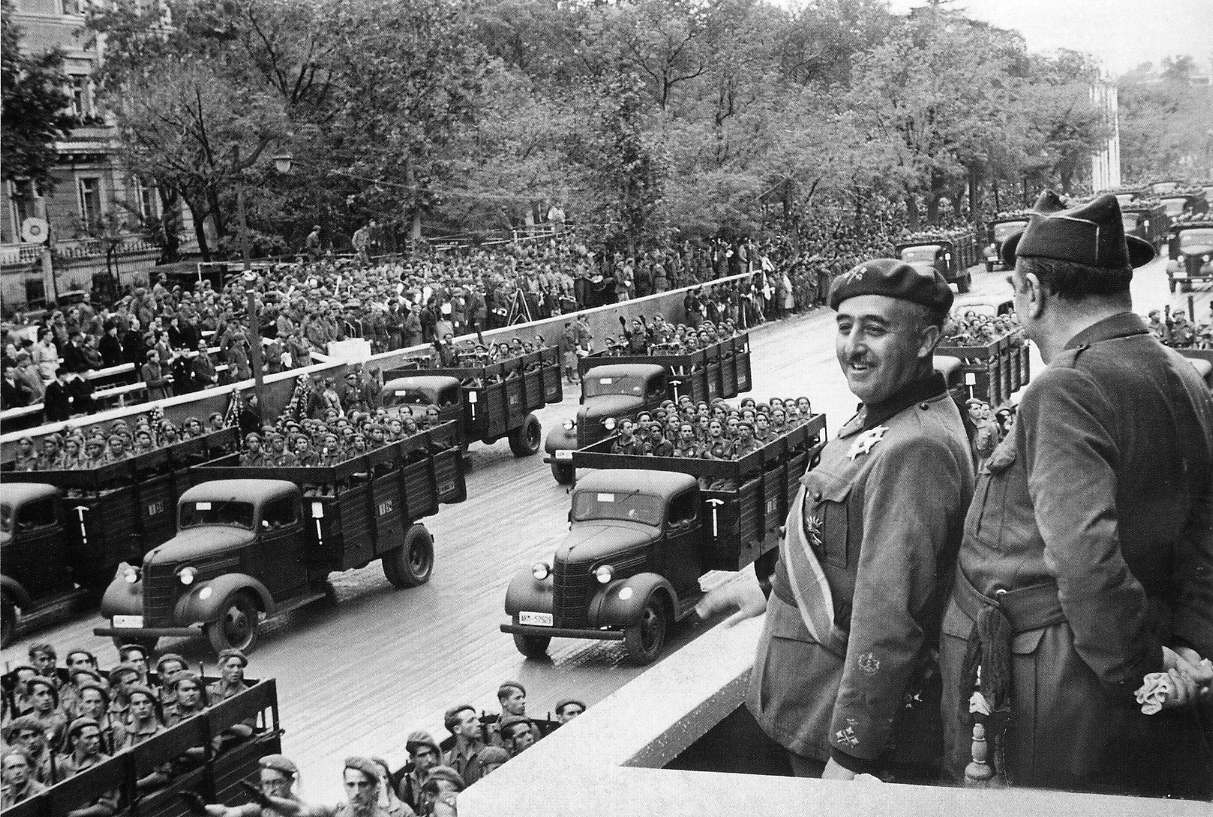
Generalissimo Francisco Franco
reviewing his Falangist troops after taking Madrid in 1939
JAPANESE IMPERIALISM IN ASIA |
|
Japan had come to consider itself one of the great
world powers as the 20th century got underway, having modernized its
army and navy to the point that it was able to defeat Tsarist Russia in
a Siberian war fought in 1904 and 1905. Also, although the Great War
(1914–1918) was essentially a European war, Japan played a part as an
Asian ally of the British and French – and was rewarded accordingly by
the formal recognition on the part of those victorious powers of the
Japanese takeover of German colonies in the Pacific.
America, of course, was wary of Japanese
broader interests in Asia (the Philippines was an American protectorate
defended by a number of American troops posted there). But in general
Japanese-American relations remained somewhat friendly, although the
Japanese were insulted by America's 1924 Immigration Act, which reduced
greatly the number of immigrants allowed to come to America – virtually
excluding all Japanese.
But the Japanese were making an effort to
move closer to the ideal of democracy – democracy supposedly having
proved itself the stronger social system in the recent war with
autocracy.
However with the onset of the depression,
democracy was not looking so impressive, and the Japanese military
group within the Japanese Imperial Cabinet began to take a scornful
attitude toward the Japanese pro-democracy civilian politicians – who
had agreed to internationally determined formulas of naval and military
disarmament – the military party pressing instead for a military
buildup of both the army and the navy. Indeed, radicals within the
Japanese military were calling for a revival of Shinto, a somewhat
mystical philosophy stressing the virtue of military valor or bushido –
even the glory of death in battle. For some (especially the younger)
Japanese soldiers, Shinto and its bushido ethic formed for them an
intoxicating ideal.
By the early 1930s civilian leaders were being assassinated – and cabinets were being turned over with destabilizing rapidity.
Also in 1932 young officers in the
Japanese occupation army in Manchuria (northeastern China) staged a
fake crisis and used the event to simply take full control of the
Chinese province and set up a puppet government there. The Japanese
Emperor Hirohito did not seem to object – and the civilian government
seemed unable to undo the takeover (very popular with the Japanese
people).
|
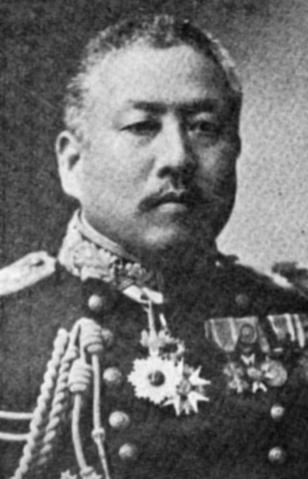
Japanese Prime Minister Makoto
Saito – 1932-1934
The Imperial Pictorial,
vol.2
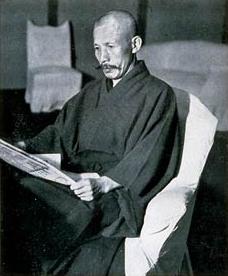 Japanese War Minister Sadao
Araki – the chief theoretician for
the Kodoha ultra-nationalist Japanese
Japanese War Minister Sadao
Araki – the chief theoretician for
the Kodoha ultra-nationalist Japanese
Time 1933
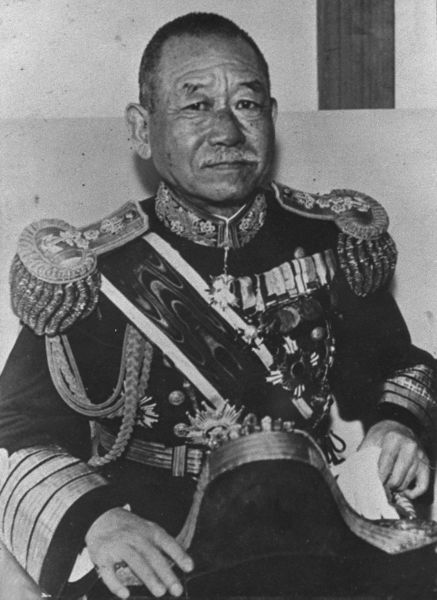 Japanese Prime Minister Okada
Keisuke – 1934-1936
Japanese Prime Minister Okada
Keisuke – 1934-1936
National Diet Library archives,
Tokyo
|
World War Two begins in China (1937).
Tensions began to mount in the Chinese North
between the Japanese Imperial government and the Chinese Republican
government under President Chiang Kai-shek, tensions which exploded
into full battle between the two countries in July of 1937 over a minor
incident at a bridge along the northern border. Using this incident as
an excuse, the Japanese invaded with full force into China – by the
army from the north and by the navy along the east coast. In short
order, the Japanese overran the major cities of the Chinese coast,
bombing the civilian population in Shanghai and worse, raping and
pillaging the Chinese in their capital city of Nanking (Nanjing). But
the Chinese government simply retreated into the huge Chinese interior
– from there to conduct an ongoing resistance movement against their
Japanese occupiers.
Thus, World War Two in the East Asian
theater had actually begun, as the first chapter in this very barbaric
story. Yet America, though deeply shocked by the stories of the
Japanese atrocities committed against the Chinese, chose to look away
rather than get involved.
But developments in Europe, plus an
alliance between the Japanese and Hitler's Germany and Mussolini's
Italy, would eventually change that American stance – dramatically.
|
|
The "Luo Kuo Chiao Incident"
of July 7, 1937
When the KMT army refused to allow
Japanese troops to cross the bridge in search of a missing
soldier, shooting broke out between the Japanese
and Chinese – as the first blow of the war
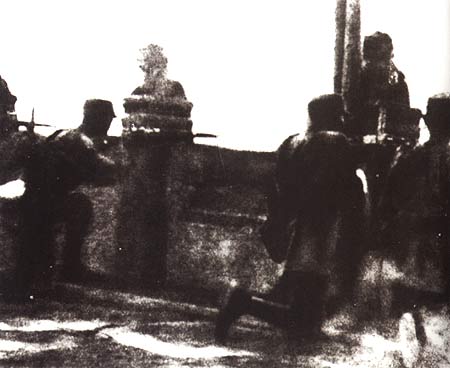 Chinese troops defending
the Luguo Bridge
Chinese troops defending
the Luguo Bridge
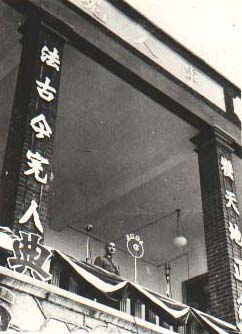 Chiang Kai-shek (Jiang Jieshi)
announcing the KMT's policy of resistance against Japan
at Lushan on July 10, 1937, three days after the Battle
of Lugou Bridge.
Chiang Kai-shek (Jiang Jieshi)
announcing the KMT's policy of resistance against Japan
at Lushan on July 10, 1937, three days after the Battle
of Lugou Bridge.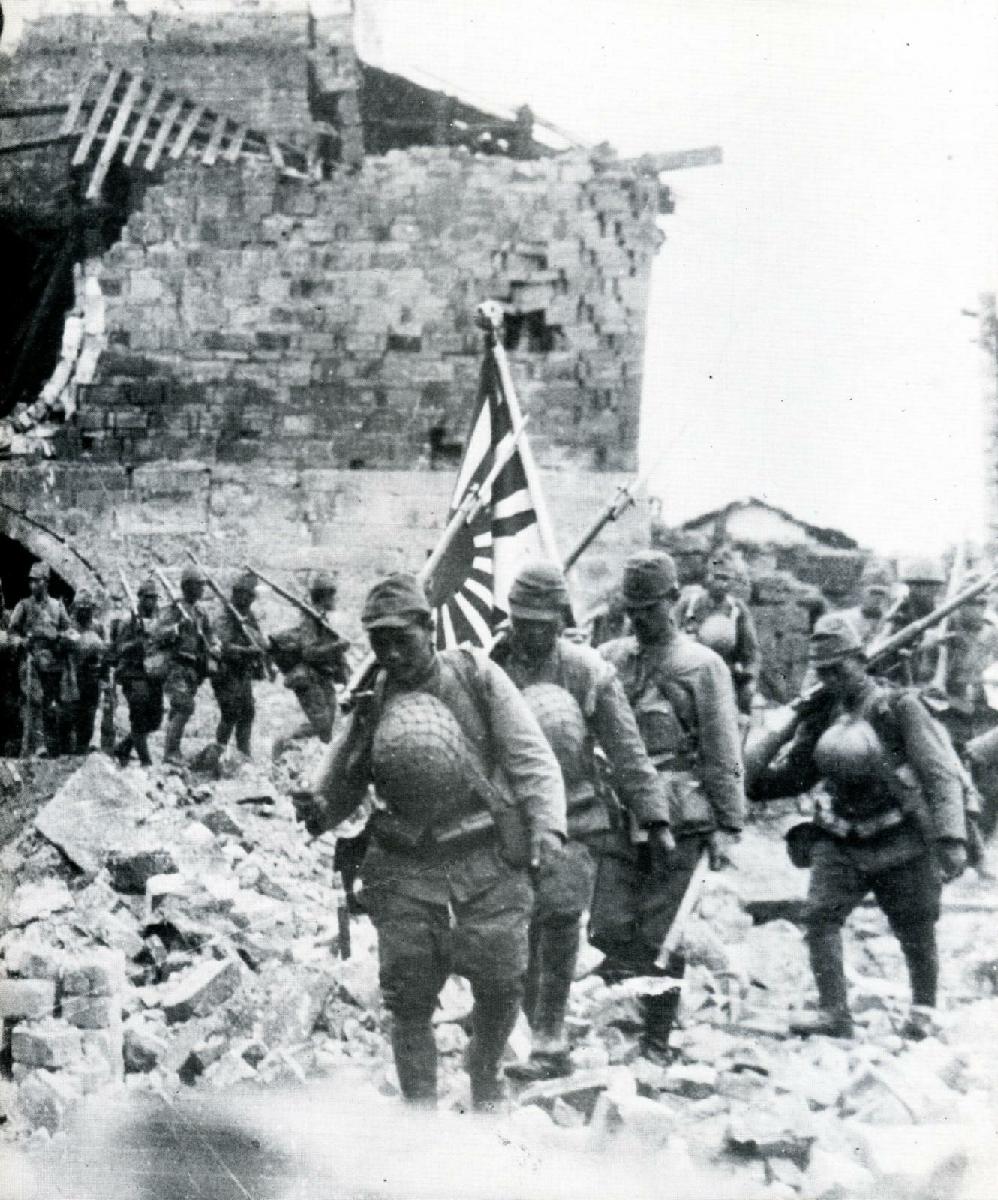 Japanese troops marching
through the rubble of a village near Hankow
Japanese troops marching
through the rubble of a village near Hankow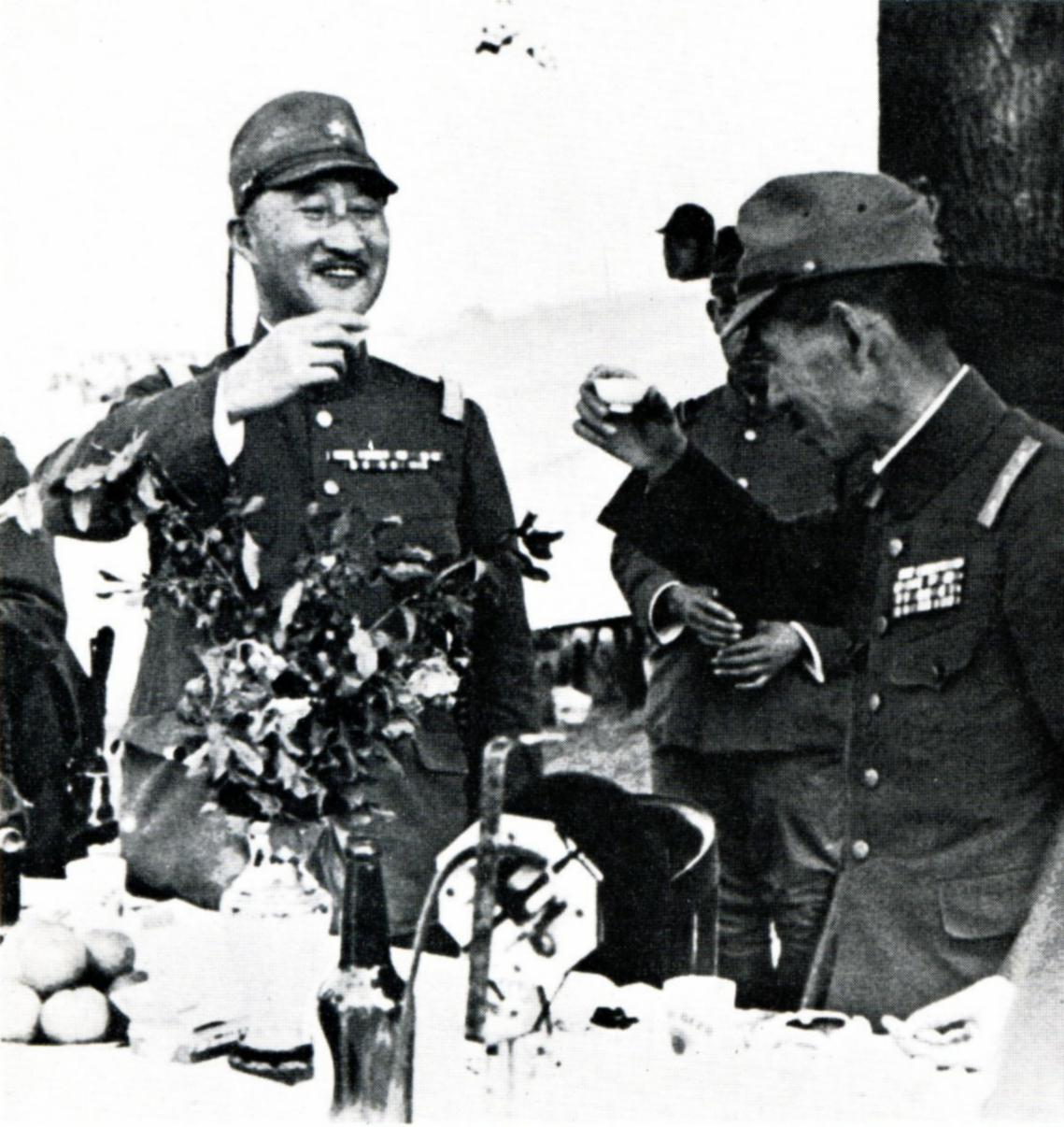 Japanese generals toasting
their victory at Hsuchow (Xuzhou)
Japanese generals toasting
their victory at Hsuchow (Xuzhou)
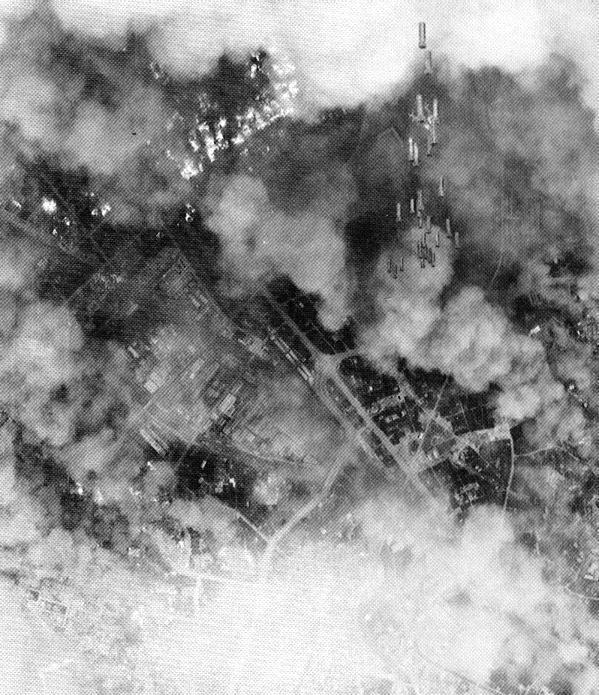 Shanghai – bombed by
Japanese
Shanghai – bombed by
Japanese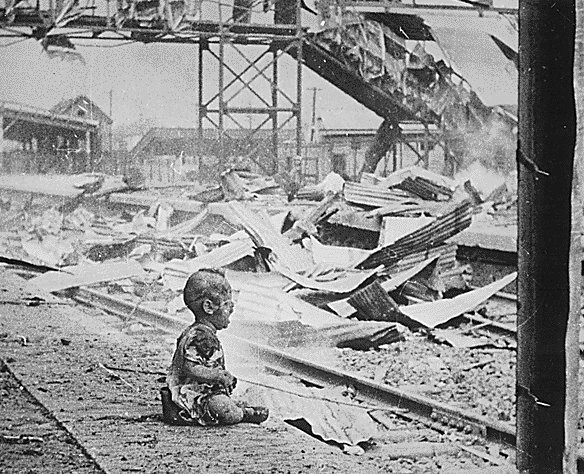 One of the last humans left
alive after intense bombing during the Japanese attack on Shanghai's South
Station. August 1937.
One of the last humans left
alive after intense bombing during the Japanese attack on Shanghai's South
Station. August 1937.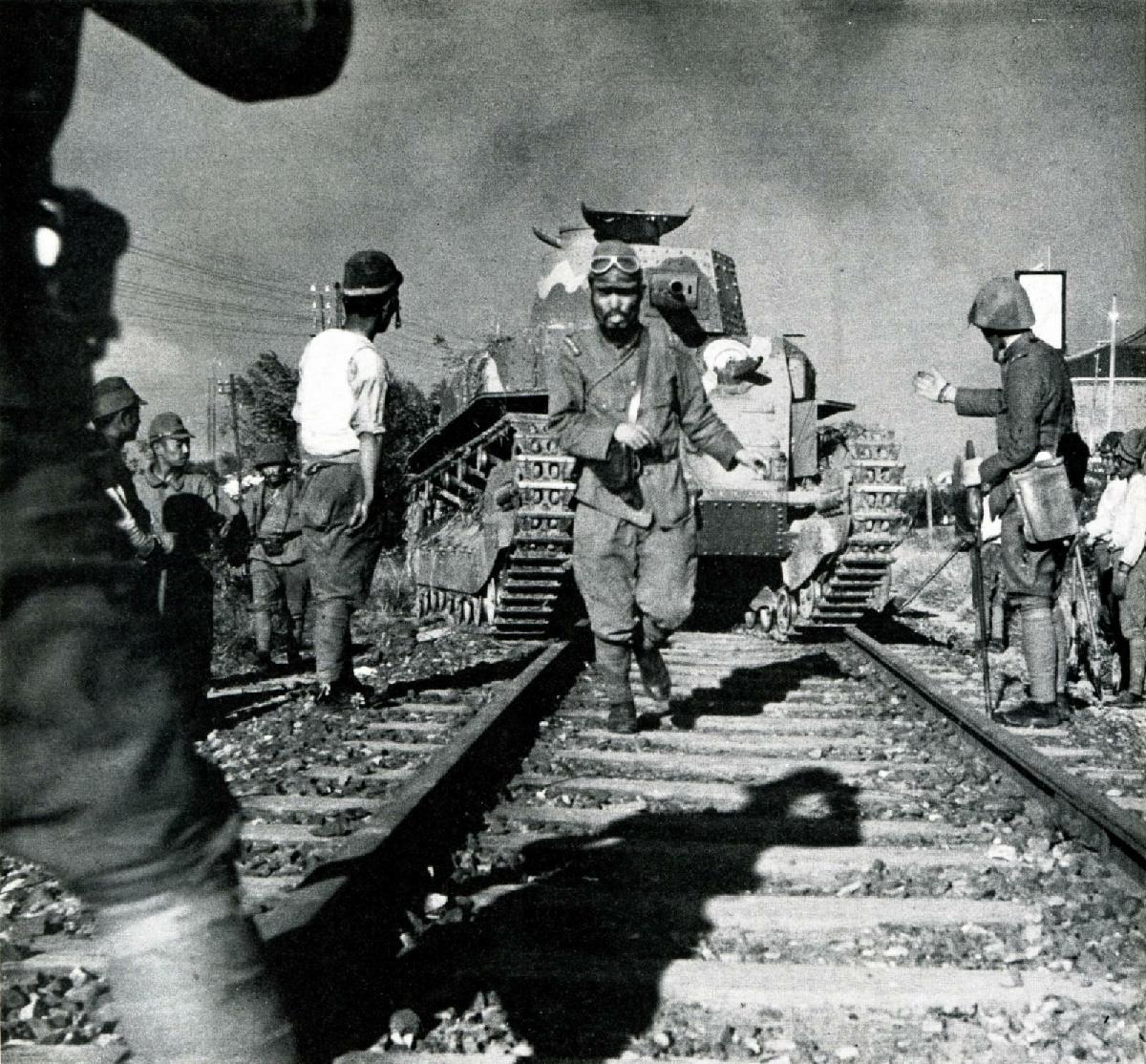 A Japanese tank rolls onto
the Shanghai-Nanking railroad
A Japanese tank rolls onto
the Shanghai-Nanking railroad
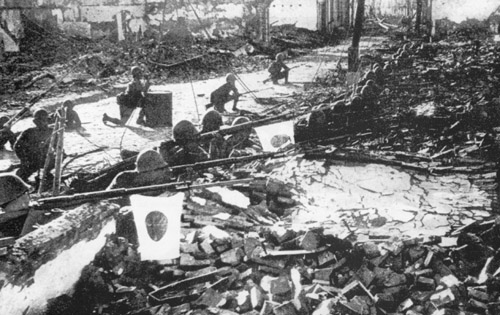 Japanese troops in the ruins
of Shanghai – 1937
Japanese troops in the ruins
of Shanghai – 1937
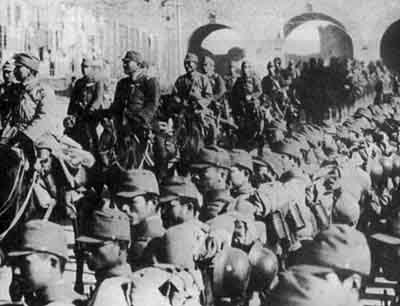 Nanking 1937: The ceremonial
entrance of the Japanese forces into the city of Nanking
Nanking 1937: The ceremonial
entrance of the Japanese forces into the city of Nanking
(Nanjing) after the city
fell to the Japanese on December 13, 1937.
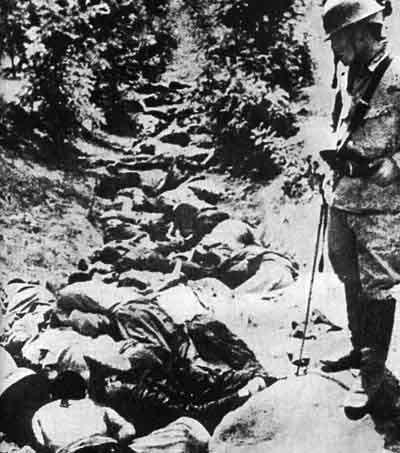 Nanking (1937) “Ten Thousand
Corpse Ditch" – where bodies of mass execution victims were dumped (as many as 300,000 unarmed
civilians may have been executed over a 6-week period,
though the numbers are hotly
debated between the Japanese and Chinese even today)
Nanking (1937) “Ten Thousand
Corpse Ditch" – where bodies of mass execution victims were dumped (as many as 300,000 unarmed
civilians may have been executed over a 6-week period,
though the numbers are hotly
debated between the Japanese and Chinese even today)
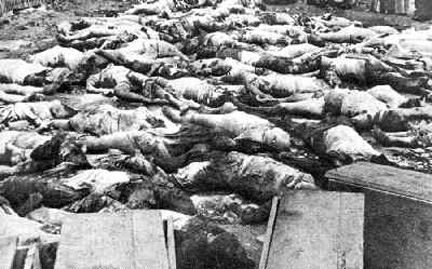 Nanking 1937: rape
and massacre of civilians
Nanking 1937: rape
and massacre of civilians
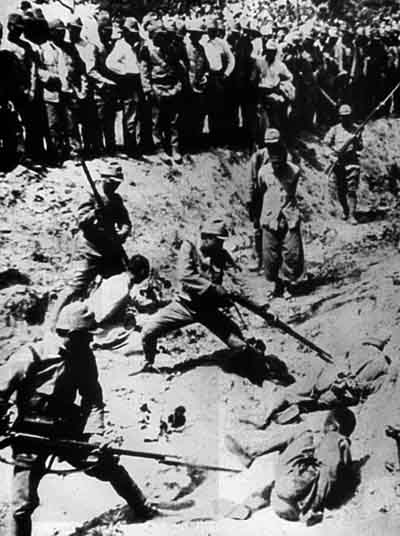 Nanking 1937: A photo
first published by Look magazine in 1938. It shows Japanese army recruits
at a bayonet drill, practicing on Chinese prisoners.
Nanking 1937: A photo
first published by Look magazine in 1938. It shows Japanese army recruits
at a bayonet drill, practicing on Chinese prisoners.
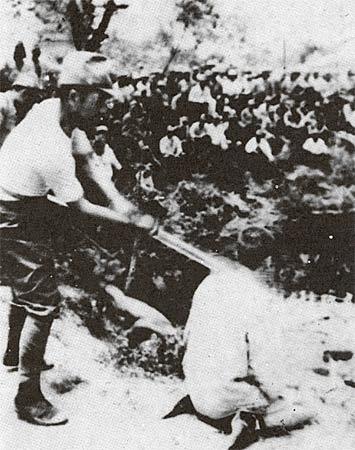
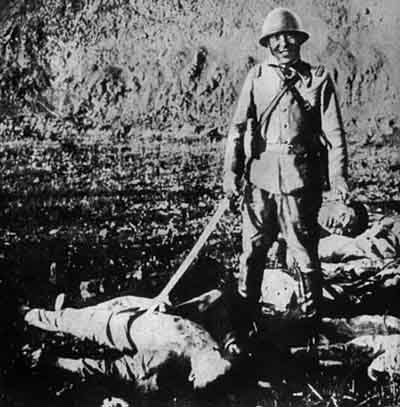 Nanking 1937: Japanese soldier
and beheaded Chinaman
Nanking 1937: Japanese soldier
and beheaded Chinaman
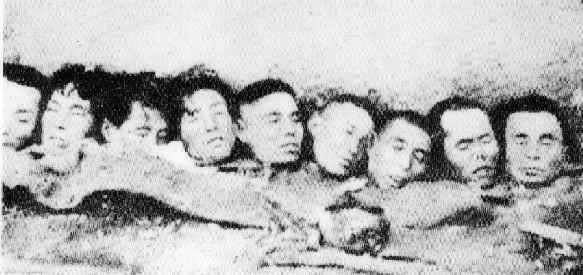
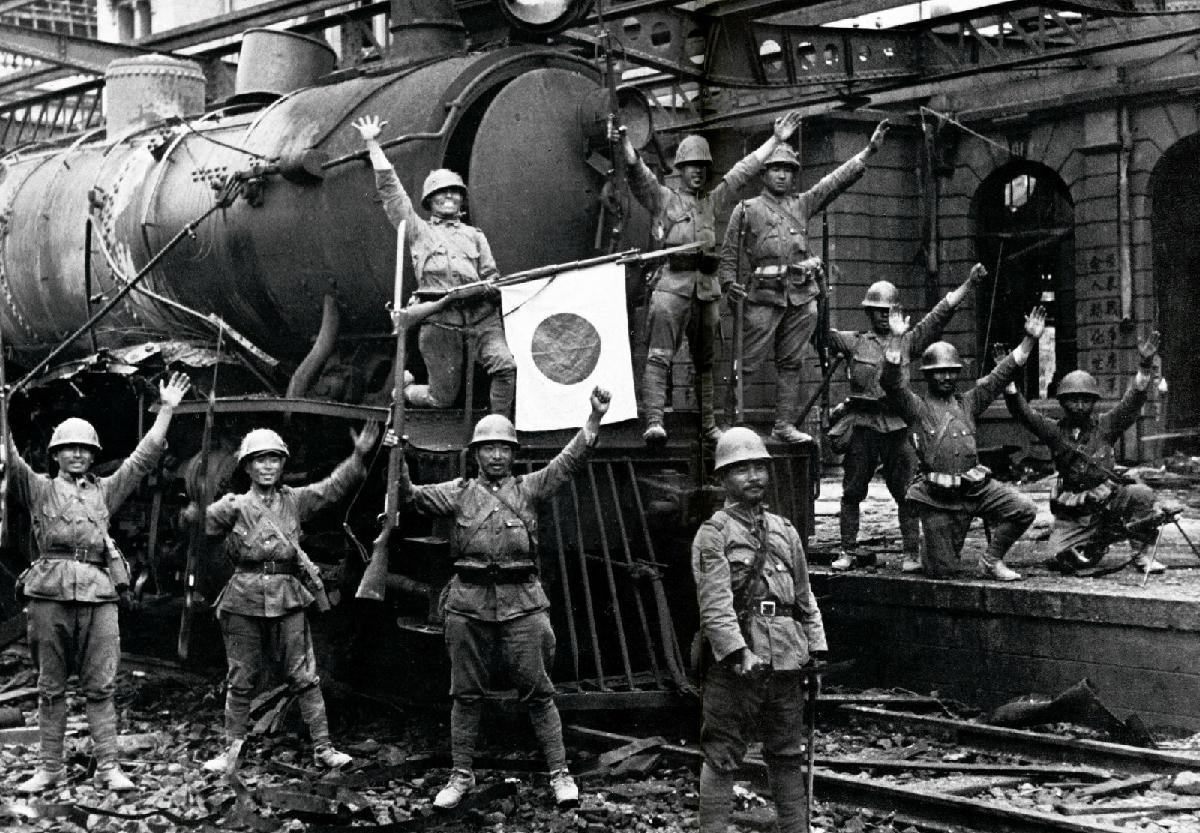
Japanese soldiers celebrating
the capture of Hankow
(temporary Chinese capital after the fall of Nanking)
THE EXPANSION OF HITLER'S NAZI EMPIRE
GOES UNCHALLENGED |
|
The logic of Chamberlain's appeasement policy soon
developed a life of its own, especially as Churchill continued to
challenge Chamberlain concerning the grave Nazi danger. Churchill, once
an avid anti-Communist, was taking the view (in the press and on the
radio as well as in Parliamentary debates) that with Hitler's rise to
power in Germany, the Nazi's were quickly becoming the greater threat
to Great Britain's security than even Stalin's Communist Russia.
Promises that each of Chamberlain's many
concessions to Germany would be the last were constantly broken by
Hitler – with each retreat by Chamberlain rationalized as necessary
steps in pacifying Hitler. Actually, each retreat only made the
dictator hungrier for German expansion. Sadly, Chamberlain (like
Baldwin) talked himself into believing that what he was doing – using
diplomatic Reason rather than brute Power – was protecting (rather than
undermining) the peace of Europe.
The German Anschluss with Austria (March 1938)
One
of Hitler's major political goals was
uniting German-speaking Austria with his German Nazi Reich (a move that
was forbidden by the treaties of 1919). He brought both his
cabinet and
his military in line with his policy (replacing leaders in both) and
then pressured the Austrian government to install more Nazis in their
cabinet. Meanwhile he began pushing Chamberlain's government to
allow
the unification of Germany and Austria, in theory as part of a stronger
defense against Communist expansion in East Europe. When
Chamberlain
seemed to be yielding, British Foreign Minister Anthony Eden
resigned. But Austrian Prime Minister Kurt von Schuschnigg
refused to yield,
finally arranging to have the Austrians determine the matter themselves
with a national plebiscite. But two days before the scheduled
election
Hitler threatened to send his troops into Germany if Schuschnigg did
not resign (which he did) and have him replaced by the Austrian Nazi
leader Arthur Seyss-Inquart (March 12, 1938). Then Seyss-Inquart
in
turn invited the Nazis (already moving across the border at this point)
to take over Austria to "restore order." A month later a highly
manipulated national plebiscite was held in Austria, producing the
highly unlikely result of a 99.7 percent approval of the Anschluss
("closing together" or '"connecting") of the two countries into a
single Germany.
The reaction of the enforcing powers of
the treaties forbidding such a union (principally Britain and France)
was weak in the extreme. Chamberlain, sensing the dangers of such
further expansion into other German areas around Hitler's Reich
(principally Czechoslovakia and Poland) did nothing, but did promise
that he would support Germany's neighbors against any further expansion
by Hitler and his Nazis.
|
Hitler's grab of Austria (the German
Anschluss)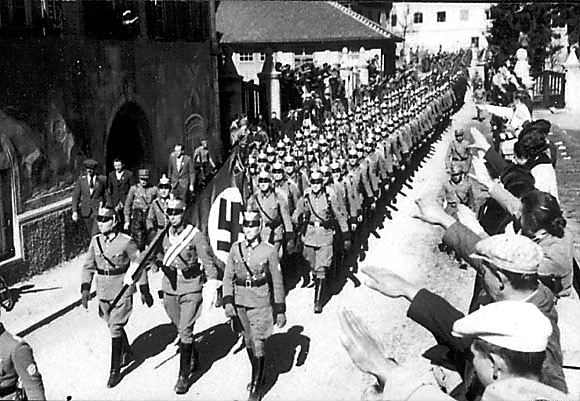 German police entering the
city Imst in Tyrol/Austria on 12 March 1938.
German police entering the
city Imst in Tyrol/Austria on 12 March 1938.
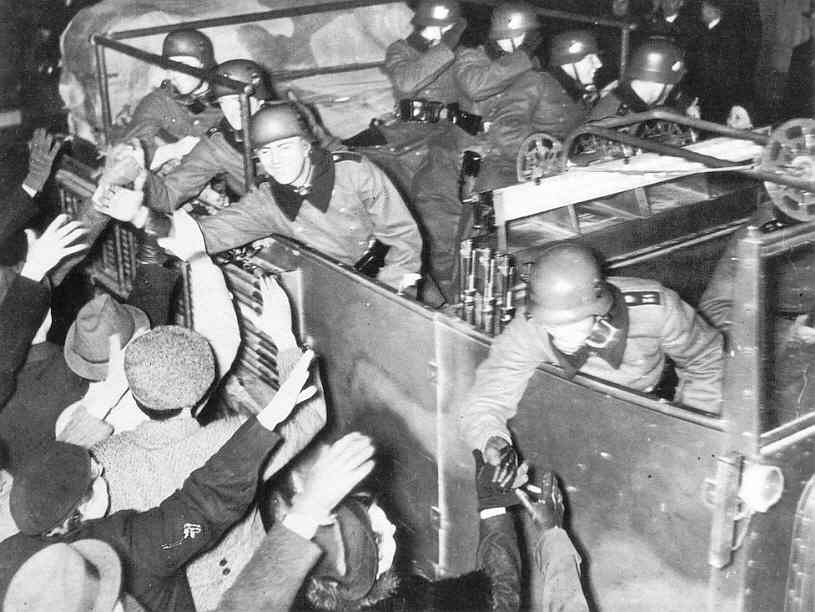 Nazi troops being greeted
by Viennese as they move in to effect the Anschluss with
Austria
Nazi troops being greeted
by Viennese as they move in to effect the Anschluss with
Austria
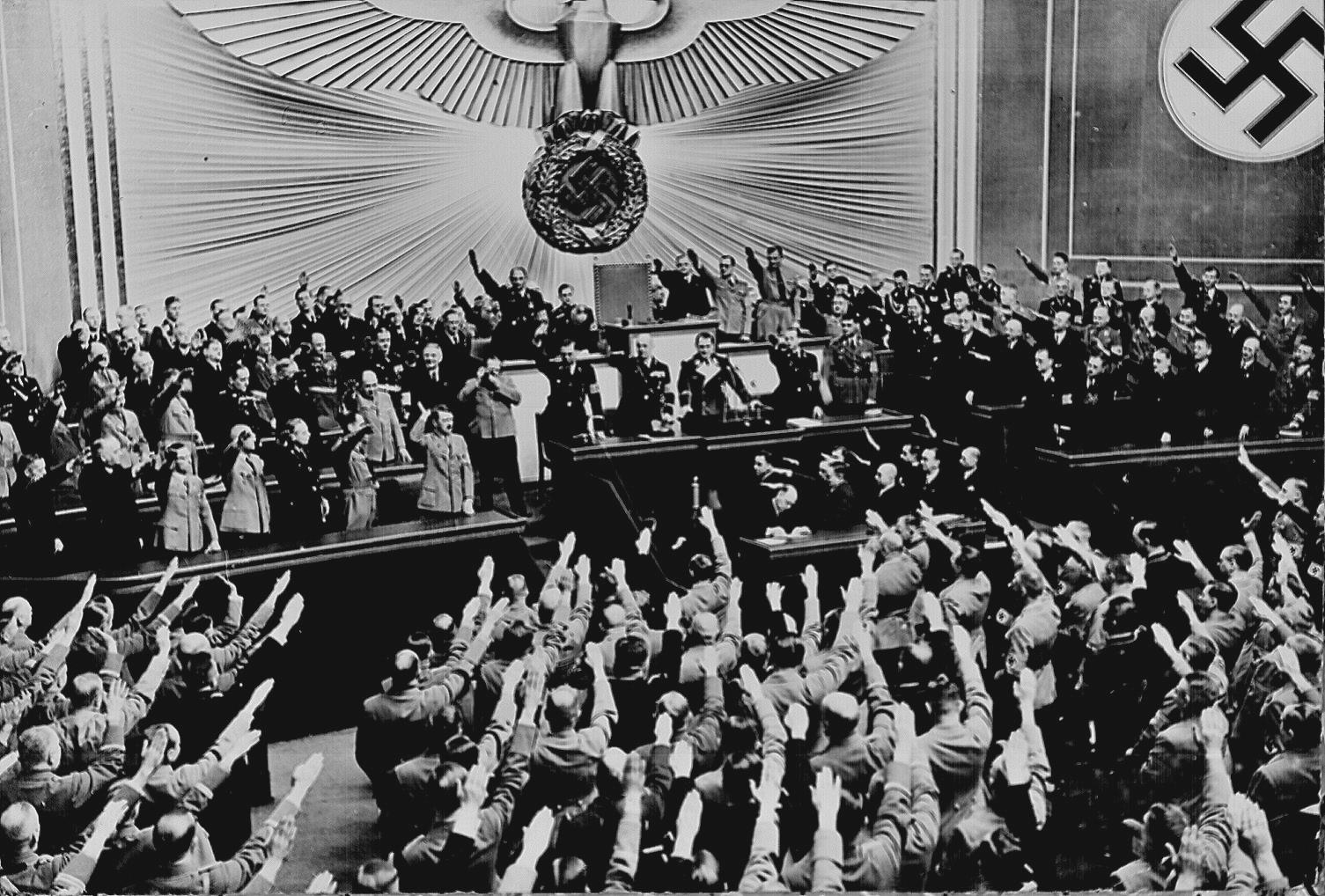
"Hitler accepts the ovation of the Reichstag after announcing the "peaceful" acquisition of Austria."
It set the stage to annex the Czechoslovakian
Sudetenland, largely inhabited by a German- speaking
population." Berlin, March 1938
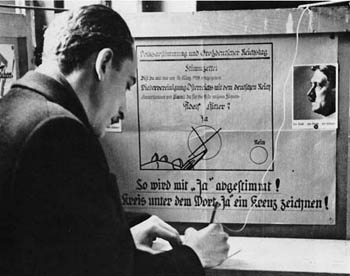
The referendum on 10 April
1938 on the Anschluss in Austria. Propaganda even in the voting
booth with a poster instructing
voters how to vote "Ja", i.e. "Yes".
Hitler seizes Czechoslovakia ... in stages
|
Chamberlain would have the opportunity soon enough
to make good on his promise – and once again back down in the face of
Hitler’s aggressive moves. Hitler now set his eyes on the Germans
living in the mountainous borderlands of Czechoslovakia (the region
known as Sudetenland). Hitler began to claim loudly that the Czechs
were mistreating the Germans of the Sudetenland (totally untrue) and he
was thus forced to have to deal with this situation. However,
Czechoslovakia’s military defenses (aimed primarily against Germany,
but also the new Poland) were well dug in there, and Czechoslovakia’s
battle-ready forty infantry divisions would have offered very effective
and very embarrassing resistance to any aggressions on the part of
Hitler.
But to avoid a mounting international
crisis, Chamberlain agreed to meet in September (1938) with Hitler (and
Mussolini) in Munich, to seek a peaceful resolution to this (non)
crisis, not knowing that officers in the German high command were
secretly making plans to depose Hitler before he dragged the country
into an unwanted war.
Then as a result of the discussions held
in Munich concerning this Czechoslovakian crisis (to which the
Czechoslovakian leadership itself was not even invited), Chamberlain
was pleased to offer the world a peaceful solution, one that would
avoid dragging Europe into another war. Hitler would be allowed to take
over the Sudetenland (and Czechoslovakia's mountain border defenses),
with Hitler's promise that this was all of Czechoslovakia that he
wanted.
So happy was the European world (except the
outraged Czechs, whose beloved President Edvard Beneš resigned rather
than agree to the terms forced on his country) that Chamberlain had
"saved Europe from another war," that talk grew of awarding him the Nobel
Peace Prize!
And most tragically for the world, it also
forced the German High command to cancel its proposed removal of Hitler
– as Hitler's acquisition of Sudetenland again made him the supreme
hero of the German people.
|
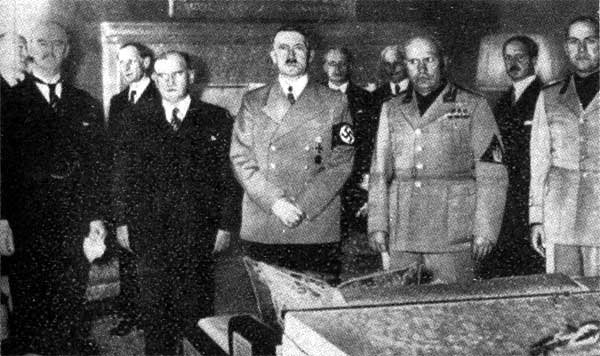 Before signing the Munich
agreement. From left to right: Chamberlain,
Before signing the Munich
agreement. From left to right: Chamberlain,
Daladier, Hitler, Mussolini,
Ciano
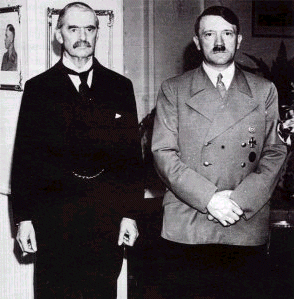 Adolf Hitler and Neville
Chamberlain after the Munich Agreement which gave Czechoslovakia's defensive borderlands to
Hitler
Adolf Hitler and Neville
Chamberlain after the Munich Agreement which gave Czechoslovakia's defensive borderlands to
Hitler
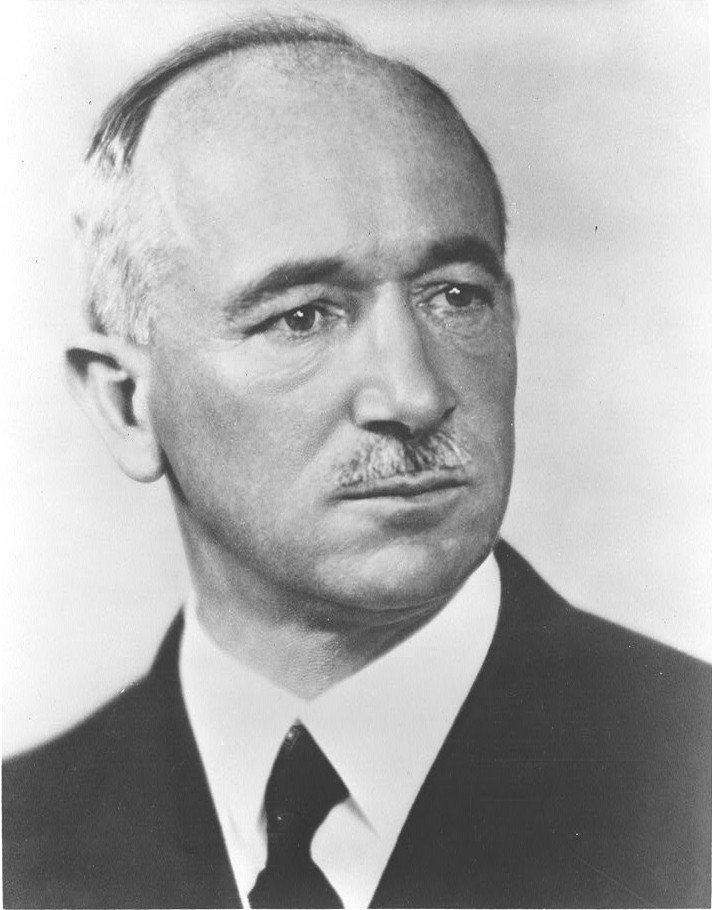 Edvard Beneš – President
of Czechoslovakia
Edvard Beneš – President
of Czechoslovakia
He was not invited by either
Hitler or Chamberlain to participate or have a voice in the dismembering of his
country by both enemy and "allied" nations
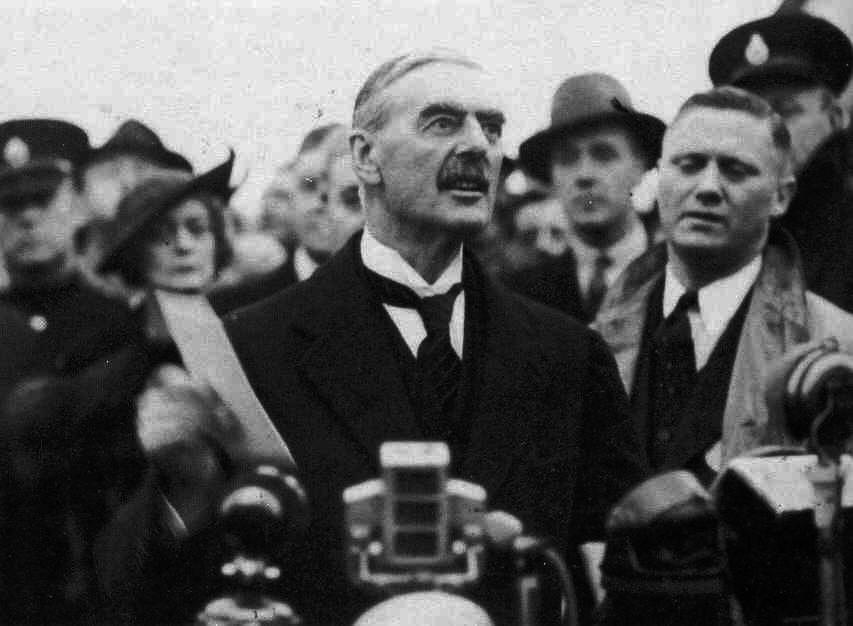 Neville Chamberlain, on his
return from meeting with Hitler,
announcing "Peace for our Time" – Sept.
30, 1938
Neville Chamberlain, on his
return from meeting with Hitler,
announcing "Peace for our Time" – Sept.
30, 1938
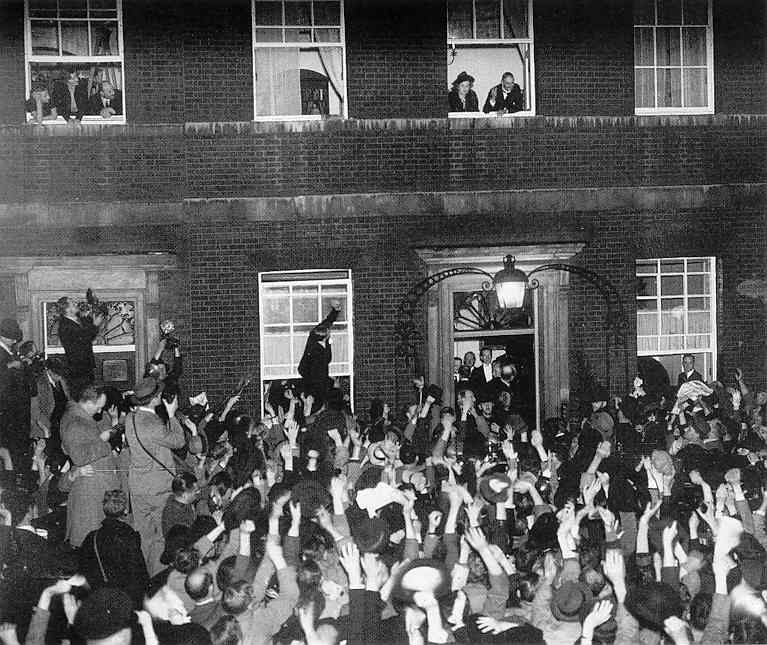 Appreciative crowds hail
the British Prime Minister for having brought them "Peace in Our
Time."
Appreciative crowds hail
the British Prime Minister for having brought them "Peace in Our
Time."
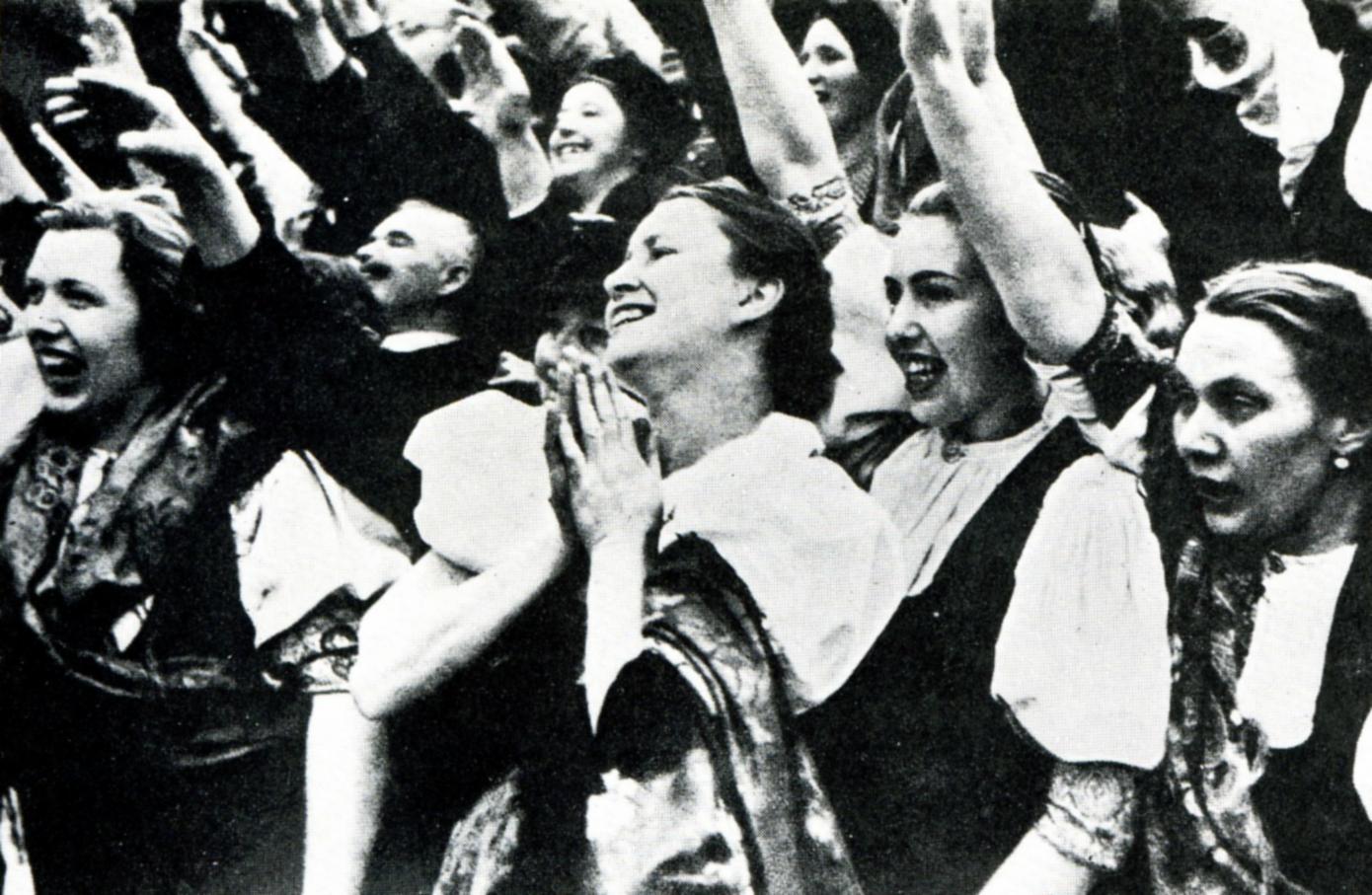
Ecstatic Sudeten women greeting
arriving German troops
|
Hitler completes the absorption of Czechoslovakia
Of course Hitler had no intention of
keeping his promise to Chamberlain, and in March of 1939 – at the
"invitation" of Czechoslovakia's new leadership (the browbeaten
President Hacha) – Hitler sent his troops to take over all of
Czechoslovakia.
The world was shocked, but again did
nothing. Chamberlain again repeated his promise that he would protect
Germany's neighbors (Poland the next obvious target) – with the threat
of a declaration of war against Germany if Hitler were to make such a
move.
But by this time few believed that
Chamberlain would – or even at this point could – deliver in a
meaningful way on such a threat.
|
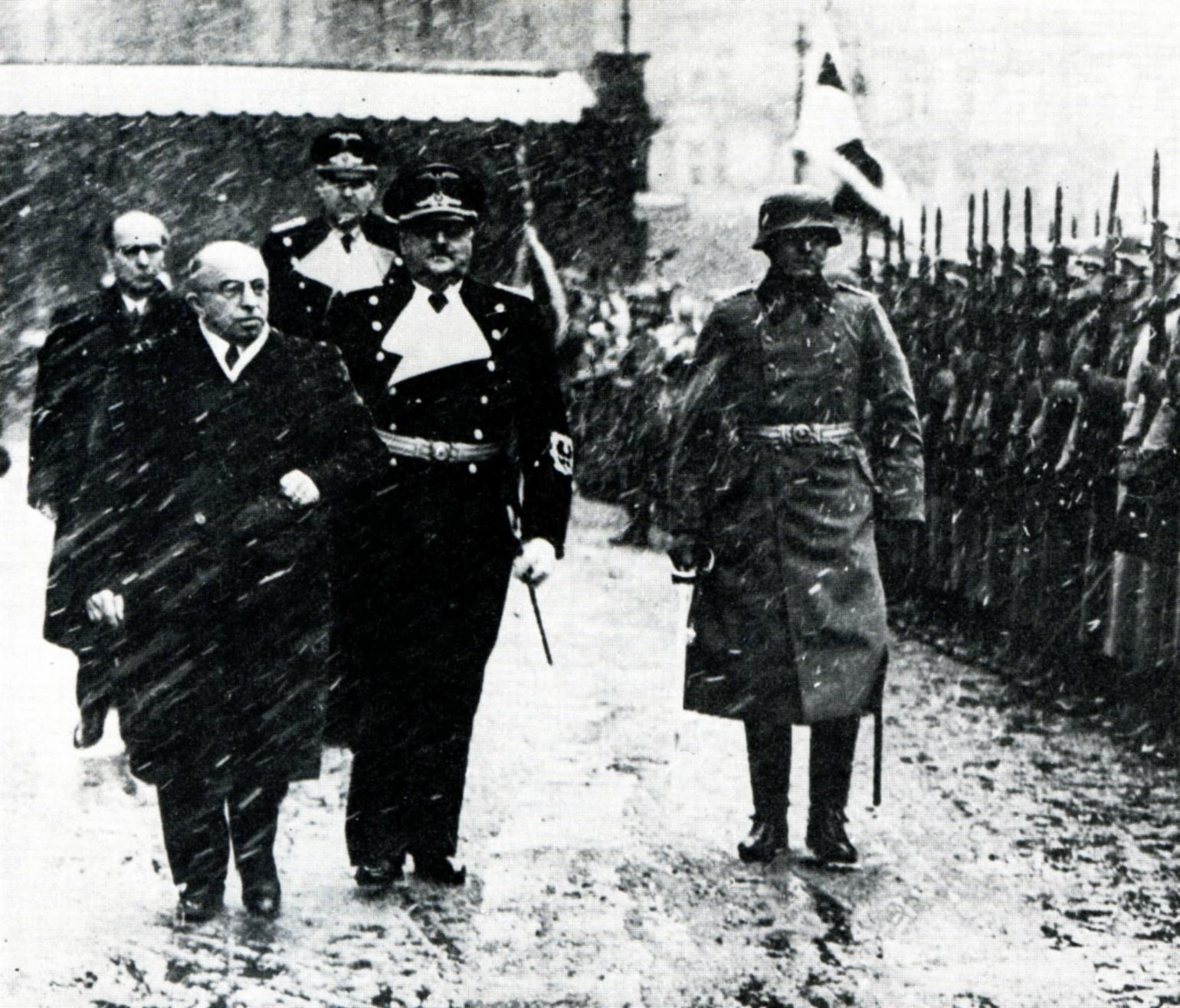
A weary Emil Hácha,
recently elevated to Czech presidency, is brought to Germany to be browbeaten by Hitler
into the surrender of his country to Nazi control – 1939
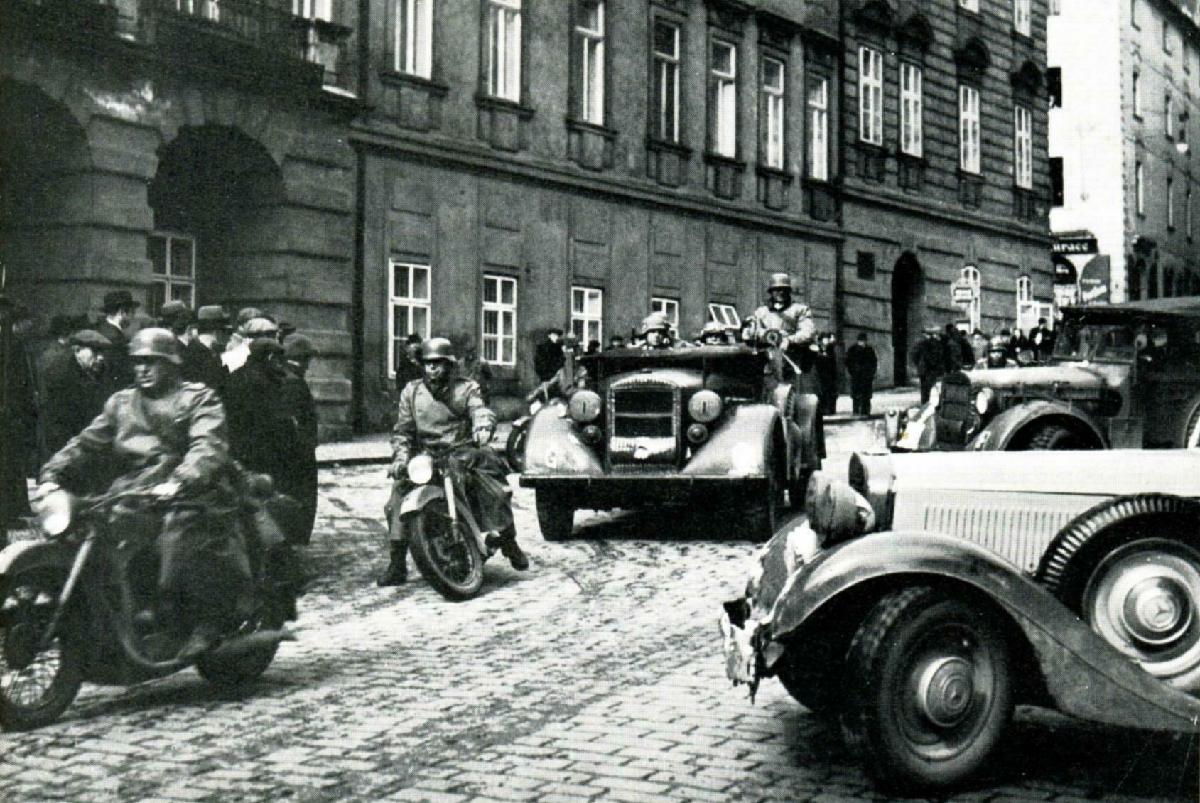
Germans arriving in Prague
in front of the Hradčany Castle
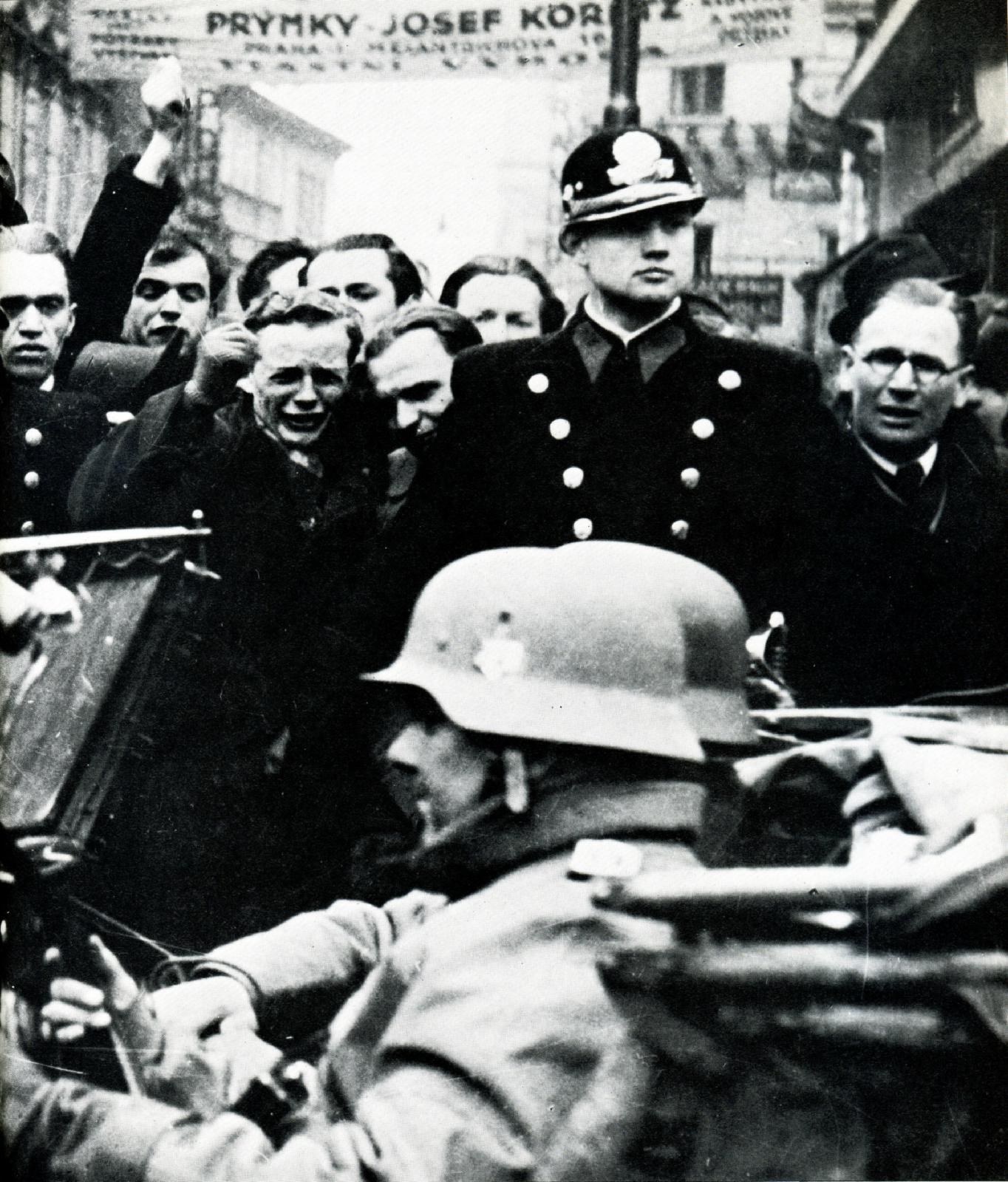
March 15, 1939 – Shocked
and angry Czechs reacting to the Nazi takeover of the whole of Czechoslovakia
and its capital, Prague
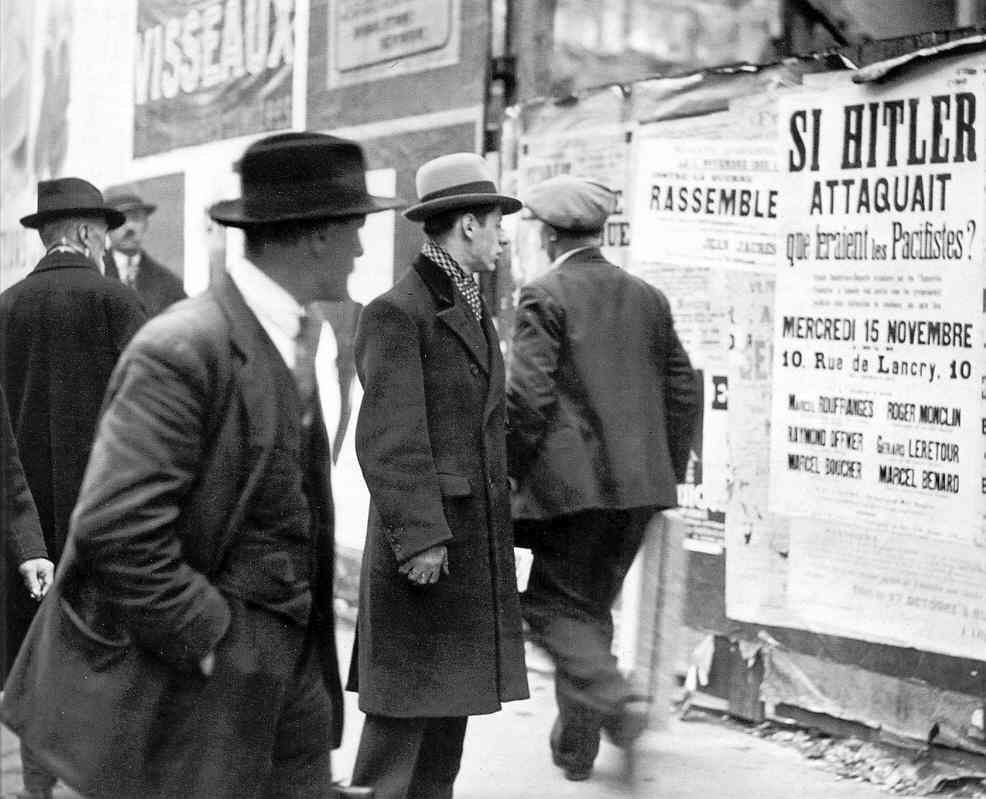
"If Hitler were to attack what would
the
Pacifists do?" French grow increasingly
concerned about Hitler
THE NAZI ASSAULT ON THE JEWS INTENSIFIES |
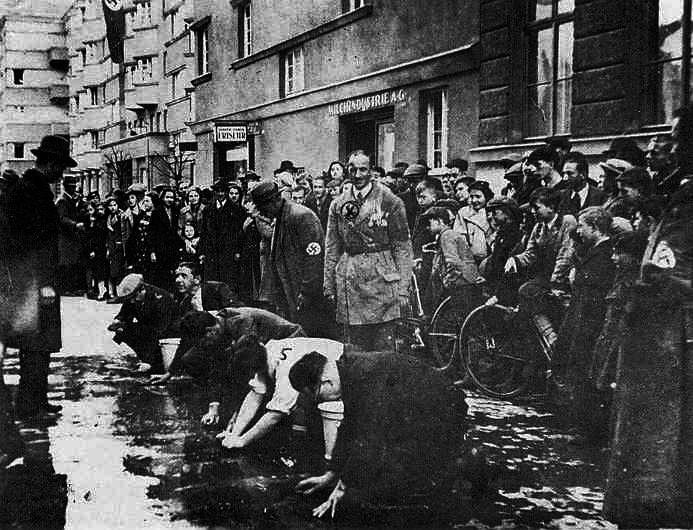 Jewish persecution begins
in Austria as Jews are made to scrub pro-Austrian slogans from streets – March 1938
Jewish persecution begins
in Austria as Jews are made to scrub pro-Austrian slogans from streets – March 1938
|
Kristallnacht – November 9, 1938 (The night of broken glass)
November 7, 1938 – Herschel Grynszpan, a young Polish Jew in Paris,
shot and killed the German 3rd secretary in the embassy there,
providing the Nazi government the excuse to retaliate 2 days later
against Jews everywhere in a night of terror known as Kristallnacht –
for all the glass windows of Jewish stores destroyed. Synagogues
were burned, 7,500 shops were wrecked, perhaps as many as a hundred
Jews were killed, thirty thousands were arrested and fines totaling a
billion marks were levied on the Jews. Also all the insurance
money paid to the Jews for the damage of the Kristallnacht (5 million
marks) was confiscated by the government.
|
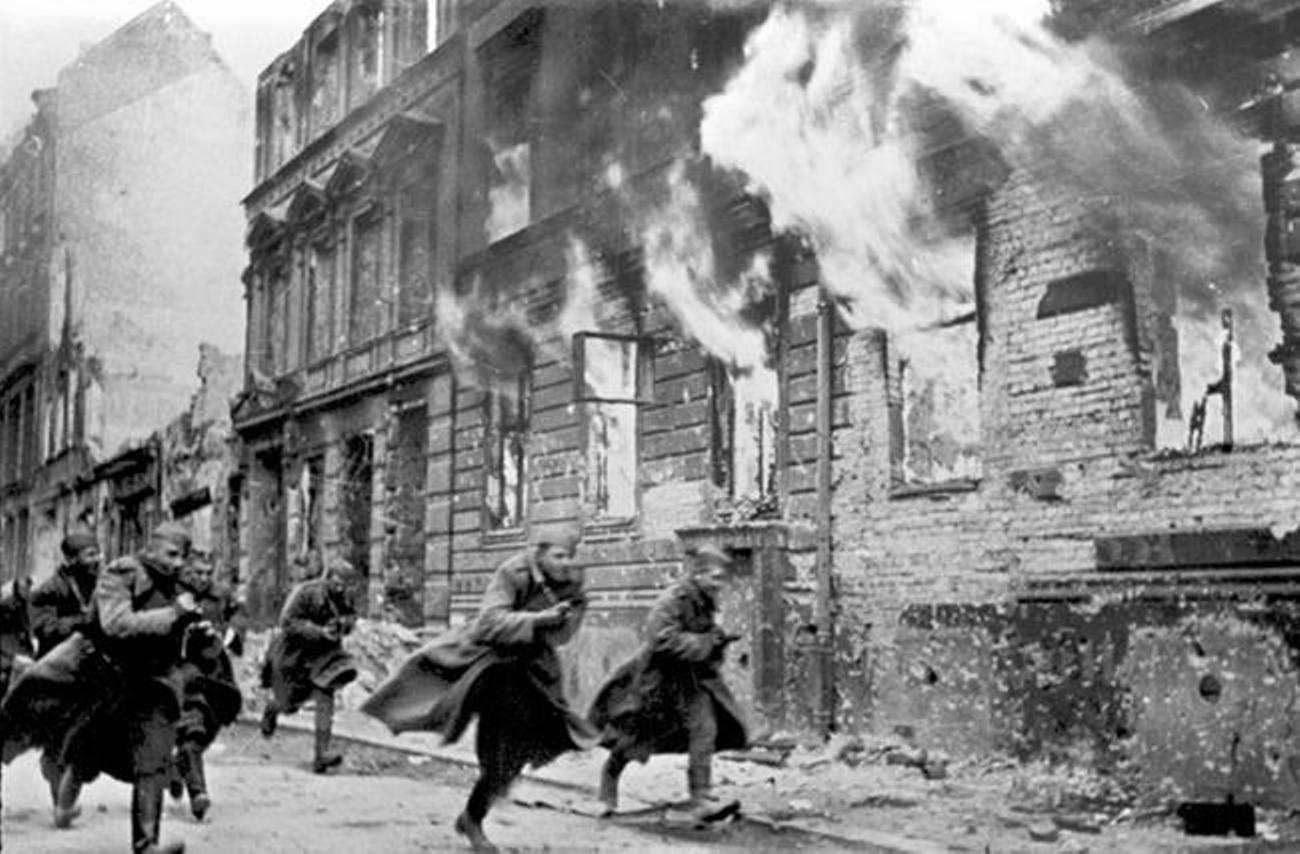 Kristallnacht – the day after (November
10,
1938)
Kristallnacht – the day after (November
10,
1938)
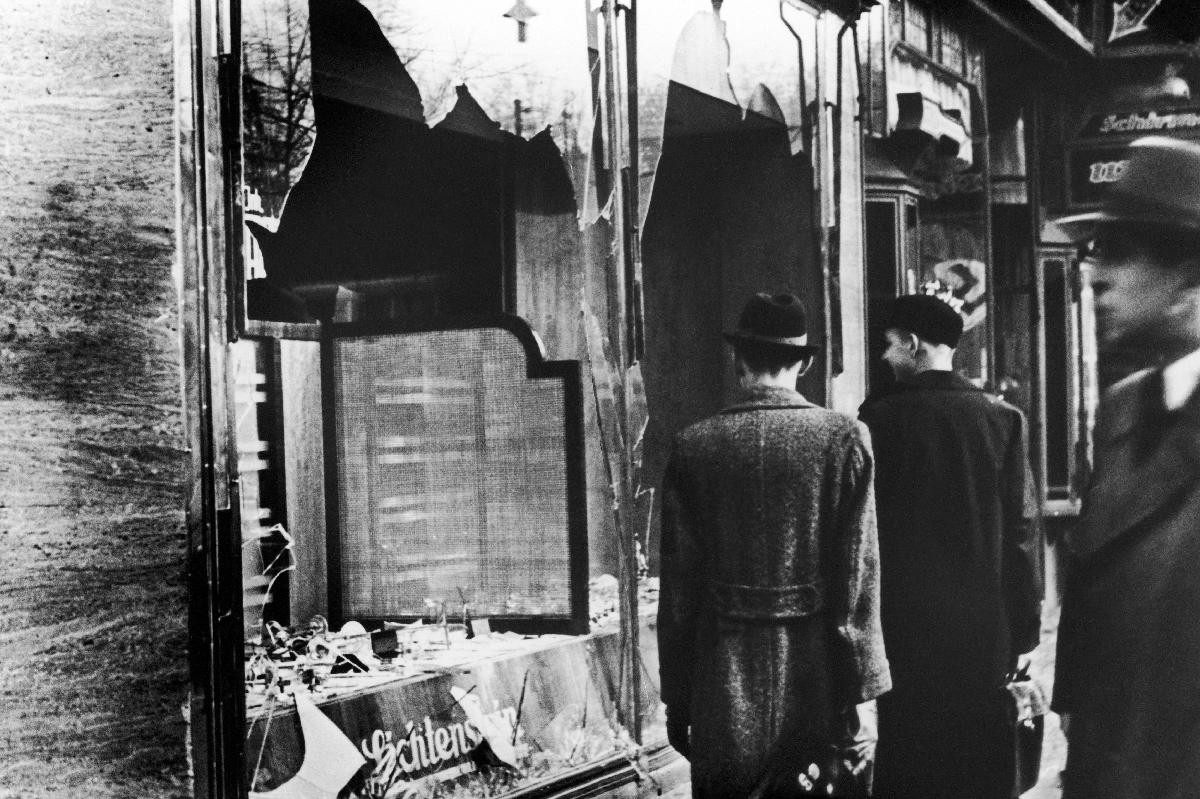
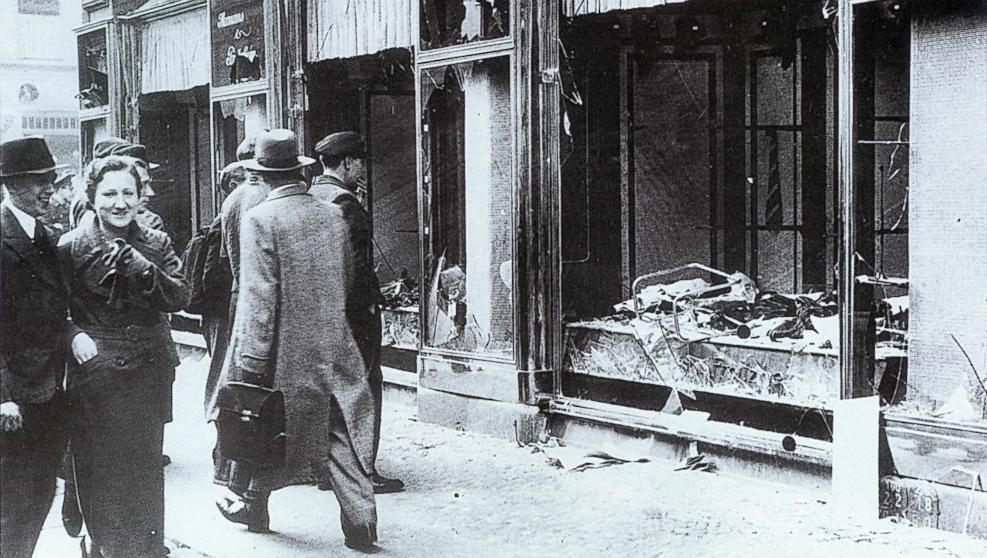 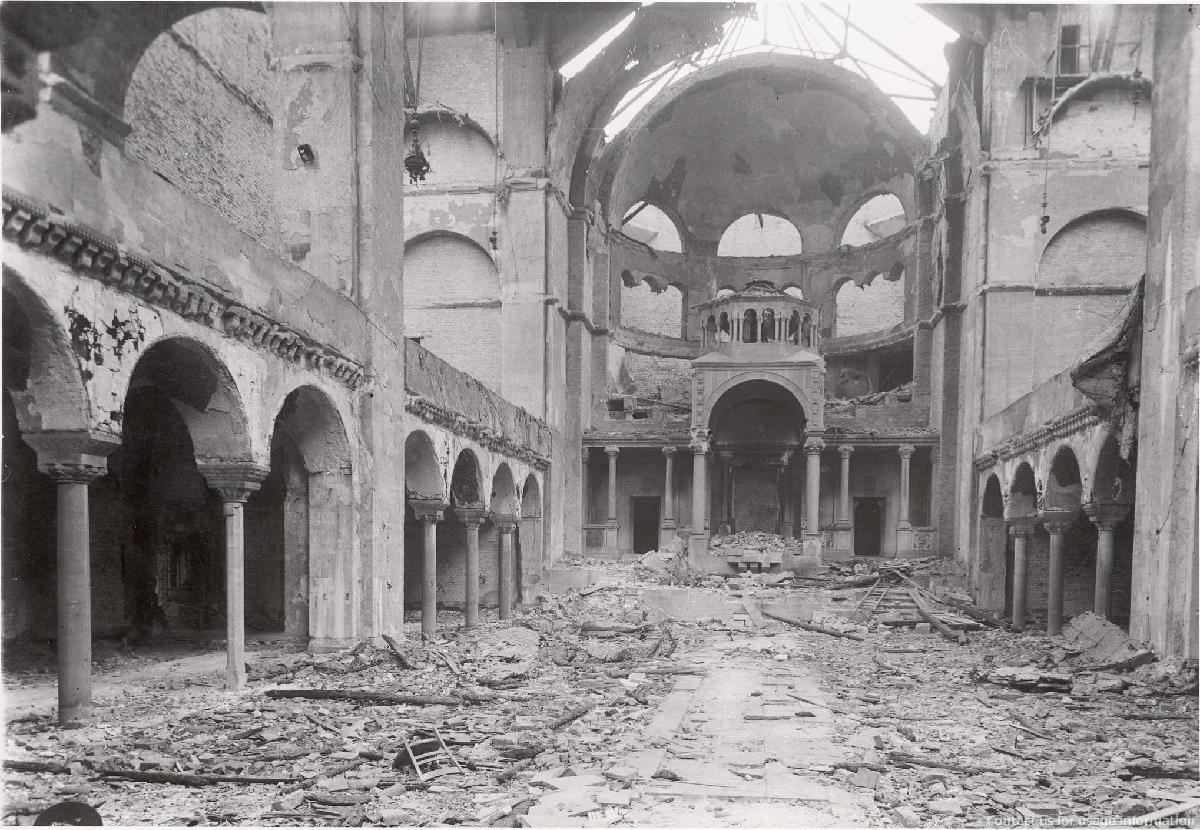
Kristallnacht – November
1938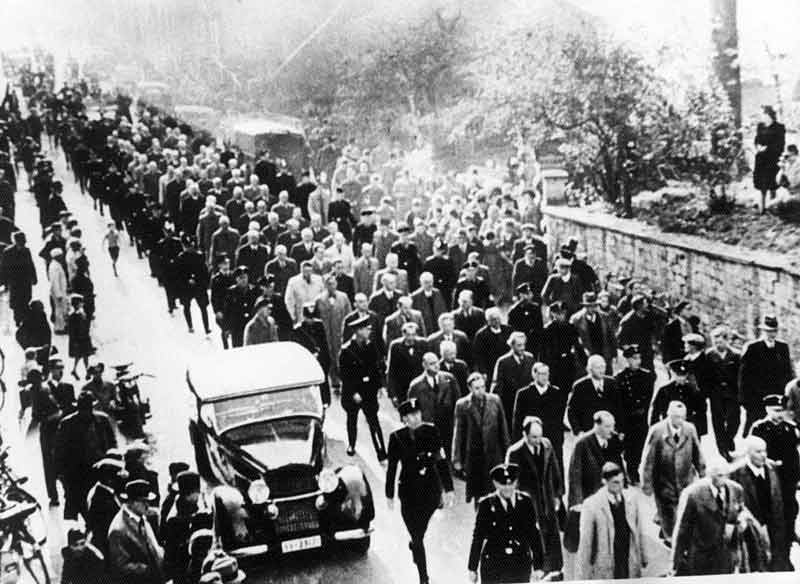 Jewish arrests in
Baden-Baden, Germany (November
10), as a follow-up on
Kristallnacht Jewish arrests in
Baden-Baden, Germany (November
10), as a follow-up on
Kristallnacht 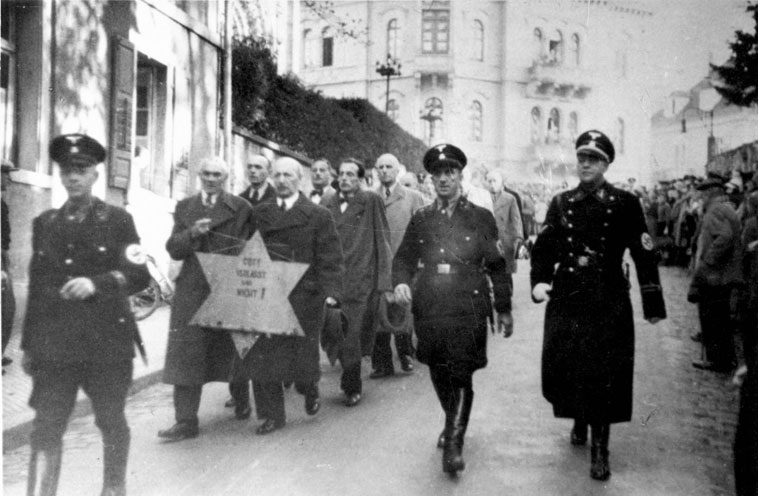 Jews being led
away (November 10)to Dachau,
Buchenwald or Sachsenhausen
Concentration Camps Jews being led
away (November 10)to Dachau,
Buchenwald or Sachsenhausen
Concentration Camps
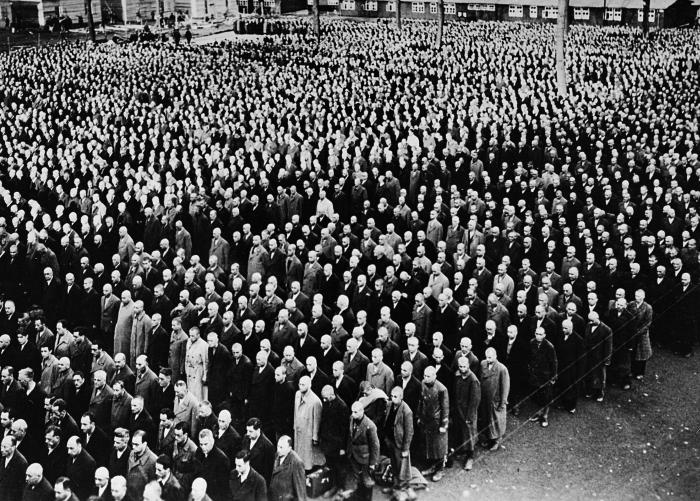 Jews arrested during
Kristallnacht line up for roll call at the Buchenwald Concentration
Camp Jews arrested during
Kristallnacht line up for roll call at the Buchenwald Concentration
Camp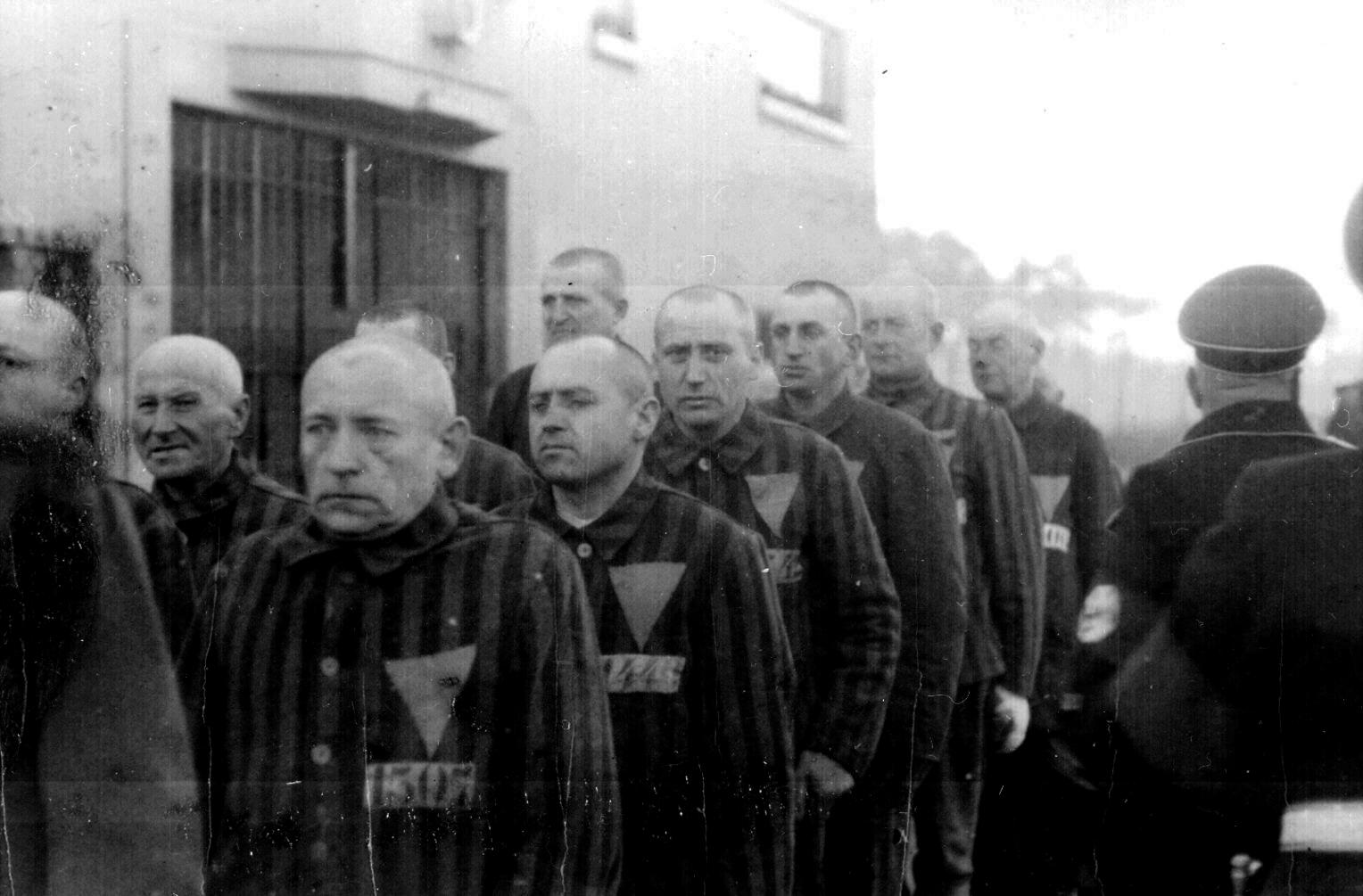
Prisoners in the concentration
camp at Sachsenhausen, Germany, December 19, 1938.
National Archives
242-HLB-3609-25
AS THE SITUATION DARKENS IN EUROPE, AMERICA RETREATS INTO A DEEP SPIRIT OF ISOLATIONISM |
|
Roosevelt turns his attention to foreign affairs
Meanwhile, with the slowing down of his New Deal
programming in the latter part of the 1930s, Roosevelt had already
begun to turn his attention increasingly to foreign events in Europe
and Asia. He found himself deeply concerned about the disturbing news
related to the behavior of Germany in Europe and Japan in East Asia.
War clouds were gathering.
America's refusal to follow him there
But in America it seemed that the only
person concerned about this was Roosevelt. Congress was suspicious of
the dominating will of Roosevelt – especially as it seemed that he
wanted America to join him in addressing the growing war problems in
Europe and Asia. That simply was not going to happen. Americans were
still bitter about their unnecessary and costly involvement in the
Great War.
The "peace and social justice" warriors
of the Liberal Federal Council of Churches protested strongly
Roosevelt's attempt to rebuild and train the American army and navy,
claiming that this would undermine world peace. Another voice of
Christian Liberalism, Christian Century, was quick to oppose
Roosevelt's State of the Union address in 1939 when Roosevelt warned
Congress of the dangers to democracy, religion and international good
will posed by the rising class of dictators in the world, and the need
of America to prepare itself to defend those virtues. Christian Century
(February 1939) classed the speech as "the most misleading and
dangerous appeal made to the American people by a chief executive in
the history of the republic."
It was very clear that Roosevelt was
making no progress whatsoever in readying Americans for what surely lay
ahead for the country. An extensive Congressional investigation by the
Senate's Nye Committee had just concluded that the only reason why
America had become involved in the Great War in 1917 was to enrich the
capitalist owners of industries manufacturing war goods – "Daddy
Warbucks" as one cartoon characterization of such a capitalist was
called. Americans were not about to be dragged into another war –
just to benefit a small group of war profiteers at the cost of the
lives of young American soldiers. Congressmen made that point very
clear.3
Congress thus repeatedly passed
Neutrality Acts (1935, 1936, 1937 and 1939), all designed to ensure
that Roosevelt understood Congress on this matter. Roosevelt's hands
were thus tied. There was very little he could do to ready America for
what he understood was awaiting the nation abroad.
And much of this isolationist pressure did not let up even when war
finally broke out in Europe. Christian Century, for instance,
attacked strongly Roosevelt's efforts to bring aid to a besieged
Britain (October 1940 and January 1941 editions) and when in October of
1941 Roosevelt attempted to warn the country that Hitler was determined
to destroy the West's very religious foundations, Christian Century
labelled Roosevelt's statement as being childish and moronic, and
accused Roosevelt of using such false claims merely to undermine the
resistance of the American religious community (the Liberal part of it
anyway) to being needlessly dragged into a war going on beyond its
borders.
But at this point they were only a couple of months away from having to change their tune, drastically.4
3This
was another example of how capitalism had become the scapegoat for all
the troubles America seemed to be facing. Actually, (as we have just
seen) it was Wilson and his Democratic Idealism that got America into
that war.
4This
they would do, of course, but without ever apologizing for their
previous refusal to understand the challenge that had been long in
developing right in front of their very eyes.
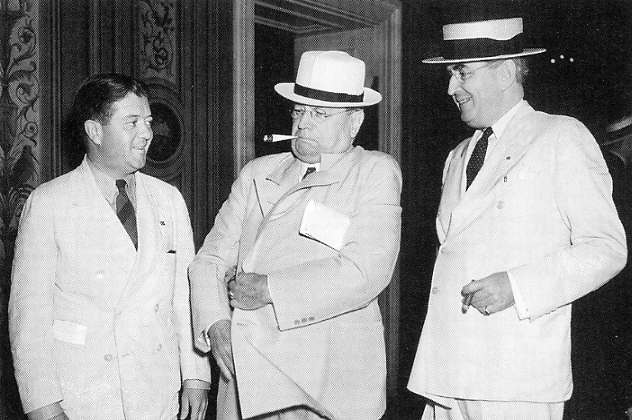 Leading isolationist voices
in the U.S. Senate – 1939: Robert La Follette, Jr.
(Wisconsin), Hiram Johnson (California) and Arthur Vandenberg
(Michigan)
Leading isolationist voices
in the U.S. Senate – 1939: Robert La Follette, Jr.
(Wisconsin), Hiram Johnson (California) and Arthur Vandenberg
(Michigan)
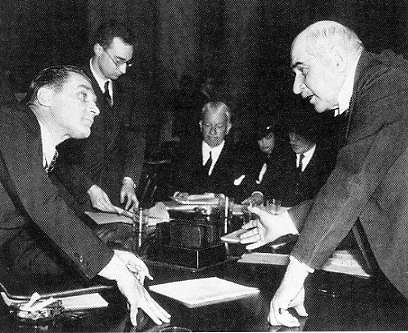 Isolationist Senator Gerald
Nye listening to J.P. Morgan defending American business – accused by Nye and others
of having pushed America into World War One solely for war profits
Isolationist Senator Gerald
Nye listening to J.P. Morgan defending American business – accused by Nye and others
of having pushed America into World War One solely for war profits
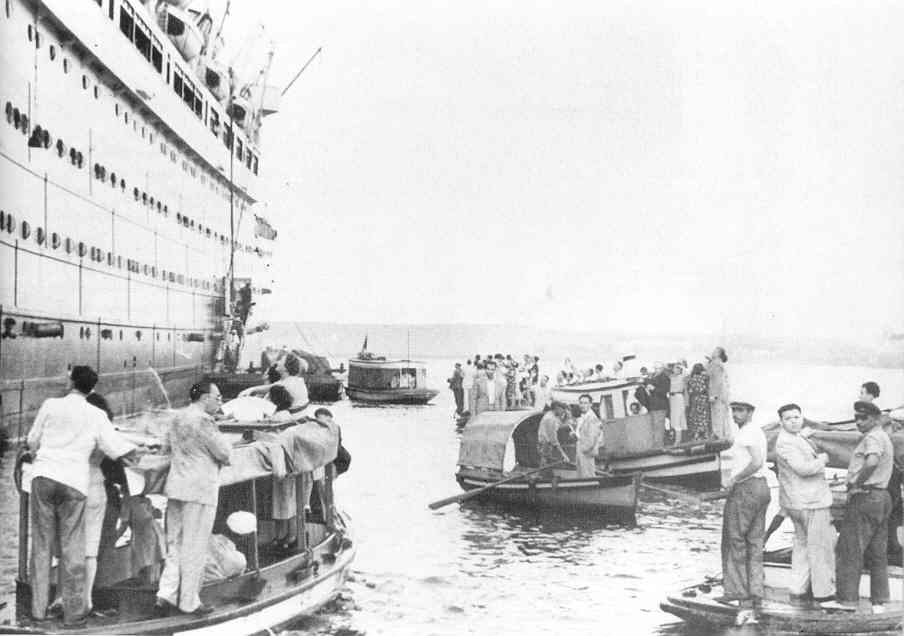
S.S. Louis carrying Jewish
refugees to Cuba to await immigration to the US – but not allowed to disembark
in Cuba – 1939

The New York World's Fair (1939) projects a fantasy view
of "the future" – as Europe becomes engulfed
in another destructive war

| | | |


 The attractiveness of the European
The attractiveness of the European Stalin's Communist "command
Stalin's Communist "command Hitler's "New Order" (Neuordnung)
Hitler's "New Order" (Neuordnung)
 France and England seem to have little
France and England seem to have little The Spanish Civil War (1936-1939)
The Spanish Civil War (1936-1939)
 The expansion of Hitler's Nazi empire
The expansion of Hitler's Nazi empire Nazi assault on the Jews intensifies
Nazi assault on the Jews intensifies
 America retreats into a deep spirit of
America retreats into a deep spirit of













































































































